Rosario: Pleasant, Authentic & Worth a Weekend
Rosario, in the province of Sante Fe, may not be a big-name tourist destination in Argentina, but it’s worth having a look at if you’re sick of the Buenos Aires grind, on the way to Cordoba or want to take a little detour on the way to Iguazu Falls.
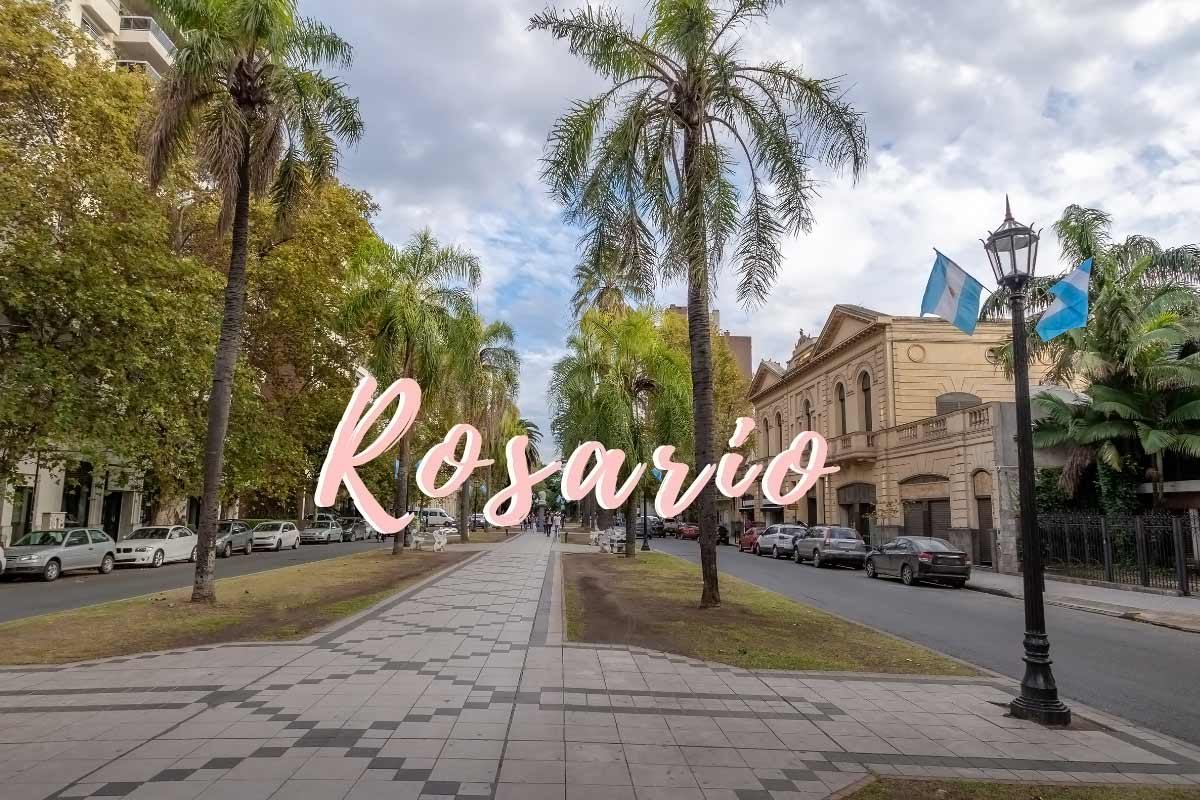
Rosario isn’t as gorgeous as Mendoza , nor will it take your breath away like Bariloche , but it vies with La Plata to be considered Argentina’s second city.
What Rosario does offer is culture, history and nightlife for fun-loving travelers or study abroad students .
Table of Contents

A Riverfront City
Argentina’s third largest city, with a population of over 1.3 million people. Rosario is a port city situated on the Paraña River.
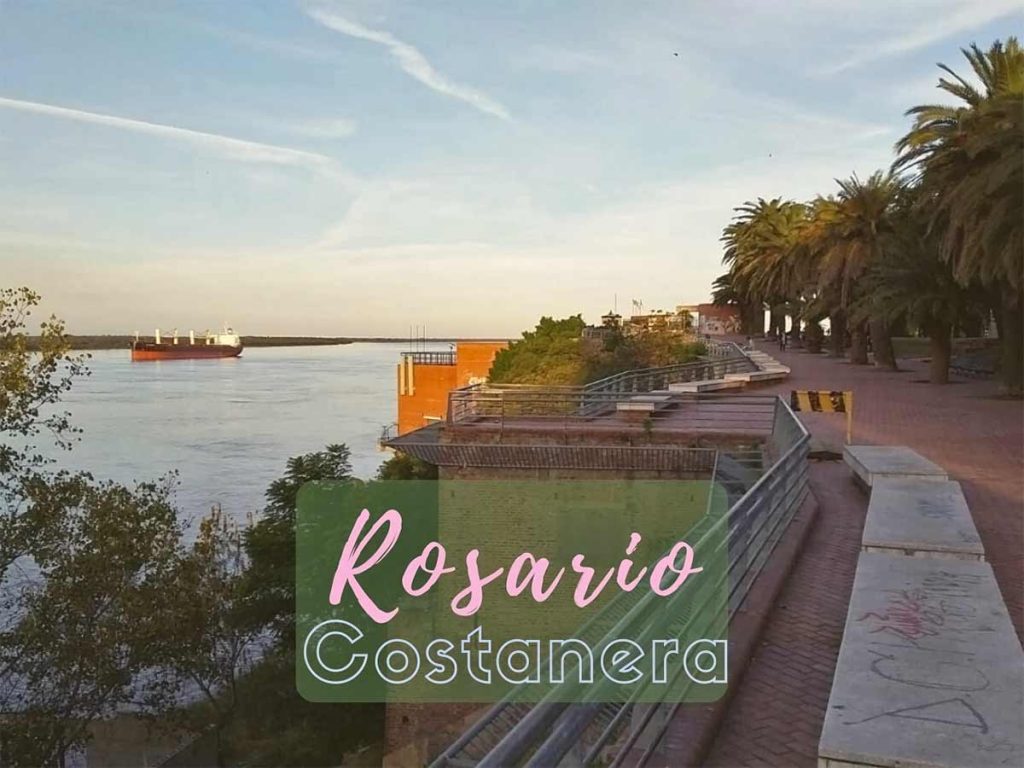
The smallish population and position on the water ensure that the ‘ Rosarinos ,’ as the locals are known, are a bit more laid back and outdoorsy than their Buenos Aires counterparts.
There are some lovely walks along the Rosario’s 15k costanera , or riverfront, where visitors can get some exercise, sip some mate and gaze upon the water.
An important Rosario monument is the National Flag Memorial, with its ornate tower overlooking an expansive courtyard, all of which is easily accessible on foot and offers great photo opportunities, or just a nice place to mill around with the locals.
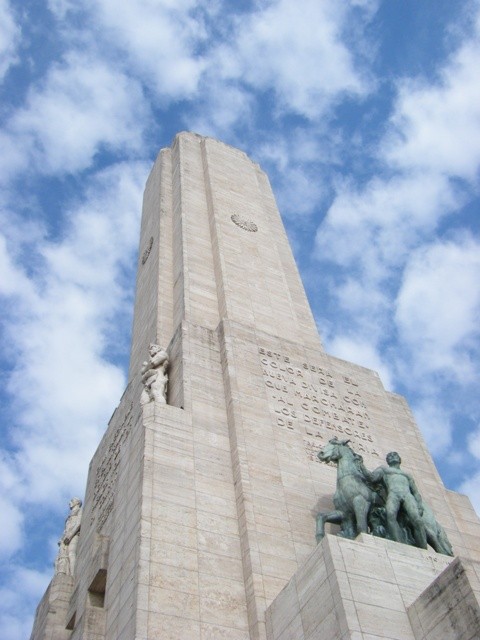
The abundance of theaters and museums, including the fine arts museum, Museo de Bellas Artes Juan B. Castagnino. The colorful Museum of Contemporary Art of Rosario (MACRo) along the rambla in a converted silo.
The city is also the birth place to some Argentine luminaries such as painter, Antonio Berni, athlete, Lionel Messi, and revolutionary Ernesto ‘Che’ Guevara ( Lynch! ) .
On the activists’ tourist circuit is latter’s first home at Entre Rios 480 (cross street, Urquiza).
In 2008, in the aptly-named Plaza Che Guevara, the city also inaugurated a four meter bronze statue of him, made with the old keys of citizens from across the country.
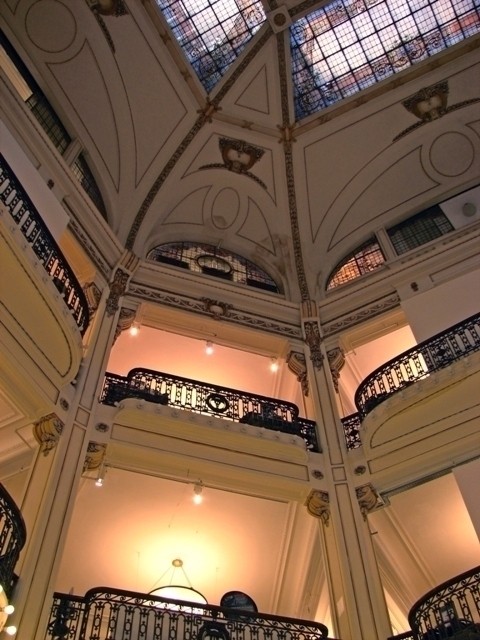
Rosario is also known within Argentina as a fun party town, due to its young population and wide variety of bars and clubs.
Porteños from Buenos Aires will even hop over to Rosario on a weekend just to go clubbing for a night or two, although rising crime in recent years has caused internal tourism to slow.
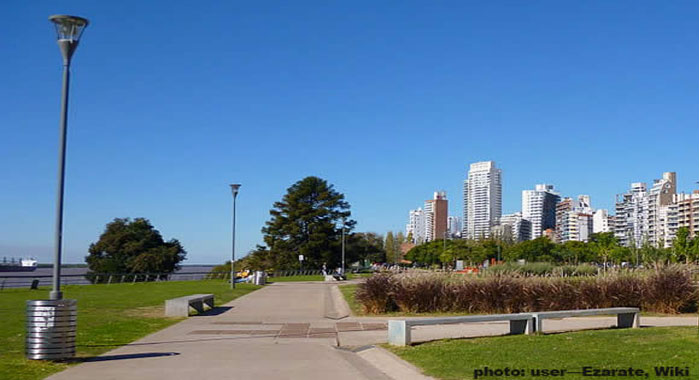
The city on the river is also reputed to be the home to the best looking girls in Argentina — quite a claim considering many Argentines believe that their country has the ‘best looking women in the world.’
Men traveling with wives or girlfriends should probably just keep their eyes on the floor at all times (or wear dark sunglasses).
Getting There from Buenos Aires: Train, Bus & Car
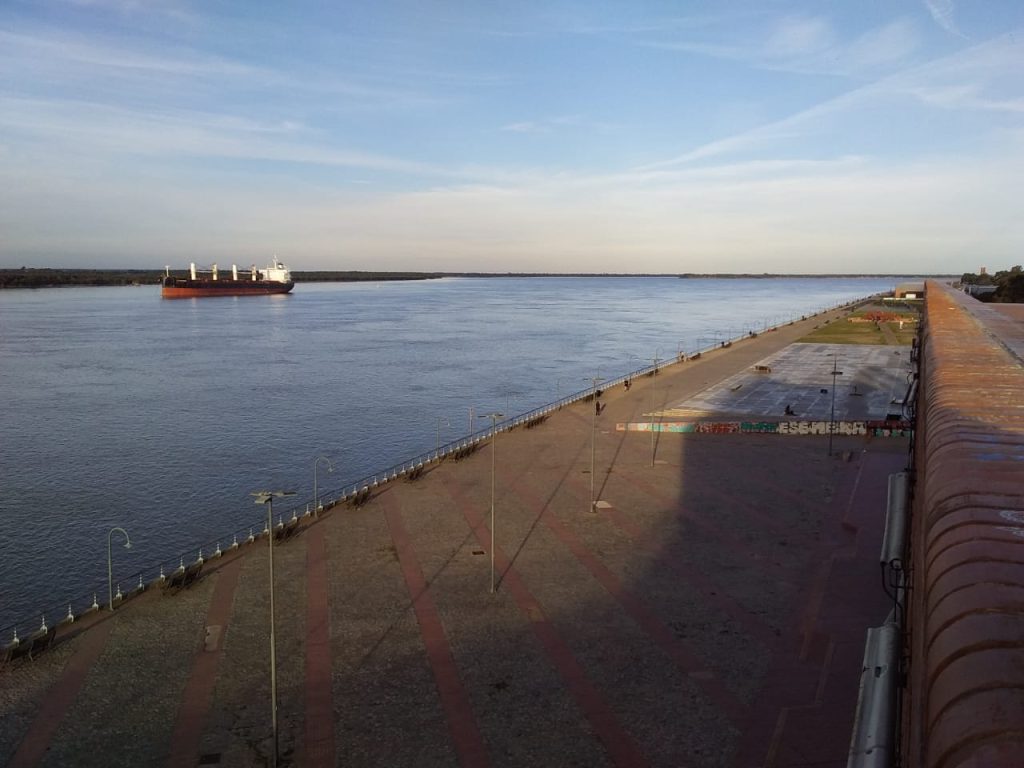
Perfect for a four-day trip, or even a long weekend, Rosario is relatively close to Buenos Aires, and it’s inexpensive to get there.
A micro (long distances bus) ride from the Retiro station costs under US$10 for a semi-cama seat (reclines to 45 degrees), and a bit more for cama (fully reclinable) and takes between three to four hours.
There are a multitude of companies offering services at all hours of the day.
You can compare prices here and purchase tickets online, or head into the Retiro bus station in Buenos Aires (Av. Antártida Argentina and Calle 10) and ask around at the different company stands.
Train lovers will be happy to know it is once again it is possible to take the train to Rosario from Buenos Aires.
It costs under US$5 and also leaves from Retiro train station.
It takes a little longer than the bus, about six hours. Bring snacks as the train doesn’t have a reputation of being reliable.
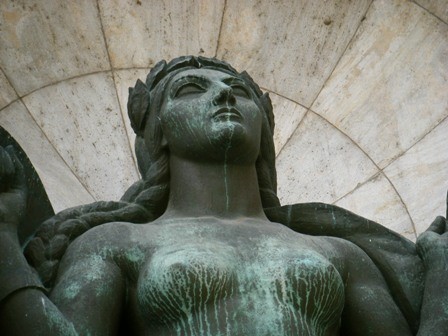
Where to Stay in Rosario
Rosario has hotels scattered throughout the city, including corporate chains, budget-friendly options, hostels, and family-owned hotels.
City Center
The city center features several corporate or chain hotels, often preferred by business travelers due to their amenities and proximity to the city’s commercial and financial districts.
Boutique hotels in the city center, which may offer a mix of comfort and personalized service.
Parque España Area
- This area, located along the Paraná River, offers a mix of upscale and boutique hotels. These hotels often provide beautiful views of the river and easy access to Parque España, a scenic park.
For budget travelers, there are several well-known hostels to choose from in Rosario.
A tranquil option 15 minutes by foot from downtown is Posada Juan Ignacio , which has a garden with a pool and bar.
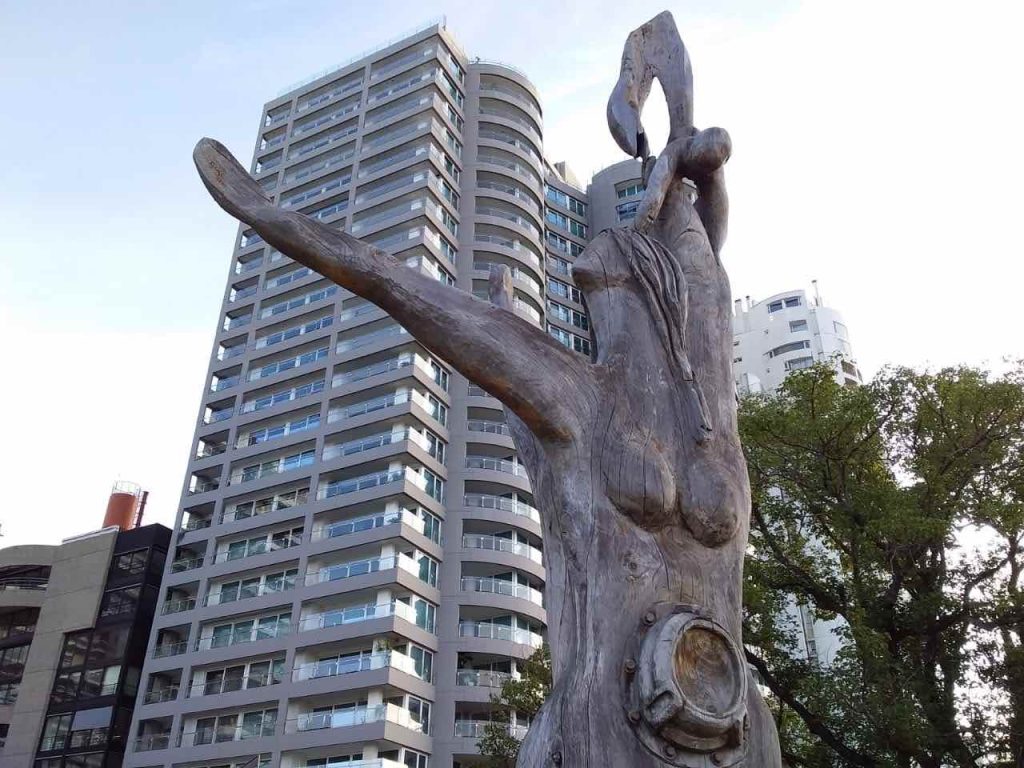
La Casona de Don Jaime is a popular hostel with two locations to choose from.
Both are situated centrally, close to both the bus station and downtown area, as well as the more attractive tourist zones, with a bed in a 6-person dorm costing only about $6 a night.
They are also the only hostels in Rosario with the Hosteling International mark of approval.
A hip alternative is the nearby Cool Raúl Hostel .
Alternative being the operative word here – this ‘rockin” hostel is geared towards fun freewheelers looking for an escape from the everyday routine.
Another option further away from town, near Florida beach, is Soles Boutique Hostel .
It’s artfully decorated with antiques and has a nice garden.
For a private room at about twice the price Casa Be Suites is a slick option near Independence Park and Newell Old Boys’ with sustainable practices in place.
Those traveling by car should note they don’t have parking though.
A family or a group of friends might want to book a reasonably-priced apartment with a view of the river. from Parana
-Dan Colasimone
additional photos: Ramón La Casona de Don Jaime 2 San Lorenzo 1530 Rosario, Santa Fe Tel: +54 (0341) 530-2020
Casa Be Suites
Avenida Pellegrini 3675
Rosario, Santa Fe
Our Services
Privacy Policy
Airport Pickup
Attend a Soccer Game
Book Accommodation
Driving & Car Rental
©Wander Argentina 2024
All rights reserved.
As Amazon Associates, Wander Argentina earns from qualifying purchases

Home » Travel Guides » Argentina » 25 Best Things to Do in Rosario (Argentina)
25 Best Things to Do in Rosario (Argentina)
Rosario is the third-largest city in Argentina, birthplace of Che Guevara and Lionel Messi, and home to artists and thousands of students. It’s just a 4-hour bus ride from Buenos Aires to this super livable and chilled out place full of friendly locals, known as Rosarinos, and warm, sunny weather.
Located along the Paraná River, the city has lots of green spaces and a few beaches where people love to congregate and socialize. Known for its neoclassical buildings, great food, and fantastic waterfront, here are several things to do in this patriotic city.
Let’s explore the best things to do in Rosario :
1. Monumento a la Bandera

This monument to the national flag of Argentina is a great place to begin your exploration of Rosario.
The flag was first unveiled in Rosario after its design, and this is one of the city’s few real tourist attractions.
With wide open spaces, an enormous flag, and an eternal flame in memory of the armed forces, it’s quite impressive and patriotic.
You can climb to the top of the main tower for great views, or just take photos amongst the huge columns made out of stone from the Andes.
If you come in the morning, you can watch the raising of the flag at 8:15 AM each day.
2. Parque Urquiza

After stopping by the flag memorial, have a wander through this waterfront park where you can snag a few churros from a nearby vendor or relax with some mate, the traditional, hot, tea-like drink you see Argentines sipping out of special gourds (also called mate) with a metal straw (or bombilla). Do some exercising on the trails and equipment here, or bring some snacks for a picnic.
There’s an amphitheater where occasional performers play and an astronomical observatory within the park.
There’s also a playground for children and lots of bars and restaurants on its edges.
3. Eat Ice Cream

Quite unexpectedly, Argentina’s ice cream is some of the best in the world.
And Rosario is actually the national capital of artisanal ice cream.
The helado here is more like Italian gelato than the ice cream in the States, and dulce de leche is a popular flavor.
There’s plenty of places to taste test it in the city – you’ll have your pick of over 100 heladerías – and plenty of parks to eat it in.
Each year in October there’s an artisanal ice cream festival where over 20 local makers pass out tastings of their delicious handmade products.
The rest of the year, try a couple of flavors at Heladerías Esther (reportedly the best), Yomo, or Touche de Crème.
4. Kayak or Cruise to Explore the Paraná River and Delta

Rosario is proud of its river location.
One of the best ways to see what the Paraná River and delta have to offer is to rent a kayak and get out on the water for the day.
Sure, the river might be a little brown (it’s just silt!), but it’s the second-longest in South America after the Amazon.
It widens around the city and has several islands set within its delta.
Paddle around the city’s waterfront and sandy beaches, or head out and stop for lunch on one of its islands.
Alternatively, you can take a motorboat tour or a cruise from Estacion Fluvial to see more of the canals, agriculture, and rural life just outside the city.
5. Eat Fresh Fish From the River

Argentina might be known as the land of steak, but Rosario’s location on the Paraná means that you should eat some fresh river fish while you’re here.
There are four varieties of freshwater fish available – Surubi, Pacu, Boga, and Dorado.
You can have yours cooked traditionally, over the embers of a wood fire, known simply as pescado a la parrilla.
Or you can have it grilled a little more elaborately, opened up and topped with a variety of accoutrements like vegetables and cheeses.
Pretty much everybody recommends Parilla Escauriza for its fantastic barbecued fish, but there are plenty of smaller fish restaurants in the beachy Florida area.
6. See the Birthplace and Statue of Che Guevara

Rosario is the birthplace of the famous Argentine revolutionary Ernesto “Che” Guevara, and you can walk past his former home within the city.
It’s located in a neoclassical building on Entre Rios 480, though it’s a private apartment now so you can’t go inside.
There’s also a 4-meter tall statue made from 75,000 pieces of donated bronze that was erected in his memory located along 27 de Febrero.
It’s set in a plaza named in his honor.
If that’s not enough for you, there are always plenty of the ubiquitous t-shirts with his likeness on them in Argentina.
7. Museo de Arte Contemporáneo

Also known as the “MACRO,” this museum houses what’s possibly the most important collection of contemporary artwork in the country.
The museum itself is based in an old restored grain silo complex by the river – the creators wanted to preserve the original building.
The 8 silos have been painted different colors and there’s a glass elevator on the exterior that goes to the top.
The museum has 10 stories of artwork, much of it by local artists, and there are great views of the islands from the top floor of the building.
On the ground floor, the sleek riverside cafe Davis offers 180-degree views of the river and is great for drinks afterwards!
8. Visit Isla Espinillo
This is one of the places where locals spend their weekends, and you can get here by public ferry or private boat from the Estación Fluvial.
Arrange to spend the morning horseback riding on the island or trying some water sports like jet skiing or windsurfing.
Then have lunch or drinks at one of the restaurants or bars located there.
From light salads to a full Argentine asado (barbecue), you’ll have options because the island can get pretty lively with visitors.
It’s actually home to about 20 families who live there too.
After lounging in the sun all day, you can take the ferry back to the city in the evening.
9. Teatro El Círculo

Inaugurated in 1904, this historic theater was renovated in 2004 to celebrate its 100th anniversary.
It now functions as a cultural center and stage for many international performers from rock bands to operas.
It has room for 1,450 people within its five levels and the dome of the main room is painted with magnificent frescoes.
Even if you’re not seeing a show here, you can take a guided tour of this elegant theater, which includes a peek at the backstage area.
Rumor has it that the acoustics are great, and they sell champagne and empanadas during intermissions.
10. Parque de la Independencia

This is the city’s largest park, and it contains gardens, a lake where you can rent paddle boats or feed the ducks, and fountains that put on a great “dancing waters” show.
It’s also home to various food vendors, a history museum, a fine arts museum, and a children’s play area.
Also located within the boundaries of the park, you’ll find the fútbol stadium, Estadio Marcelo Bielsa, home to Newell’s Old Boys.
It has its own museum which you can wander inside, but it’s not open on match days.
11. Museo Municipal de Bellas Artes Juan B Castagnino

Located in the Parque de la Independencia, this fine arts museum is named for one of the city’s most important art collectors.
It contains exhibits that change regularly in addition to permanent collections by European, Argentine, and local artists.
The museum has over 3,000 works spread across its 35 rooms, many of which were donated from the private collections of local aristocrats.
Some of the works date back to the 15th century, and the current collection includes paintings by famous artists like Goya, El Greco, and Ribera.
12. La Isla de los Inventos

This is THE place to visit if you have kids with you while traveling through Rosario.
“The Island of Inventions” is an old train station that’s been converted into a place for children to explore, learn, and investigate the sciences, arts, and technology.
There are shows, courses, presentations, and exhibits, but the most popular are the hands-on learning stations.
Kids can try paper making, clay throwing, sawing, soldering, and painting.
There’s also interactive wood-block printing, stargazing, and sand and slides to play on, so kids from very young to teenagers will be entertained.
13. Go to the Beach

Spend an afternoon on one of the city’s sandy riverside beaches.
There’s Catalunya and the slightly nicer La Florida beach where you can lounge, rent chairs and umbrellas, and purchase snacks from vendors.
Or if you’re feeling exclusive, head to one of the nearby private clubs like the Rosario Yacht Club where, if you’re not with a member, you’ll need to pay for a visitor’s day pass.
With that you’ll get access to their bar, restaurant, and amazing swimming pool overlooking the river.
Walk along the water, have drinks at Mojito Beach Bar or Nenina Cocktails, or grab a meal at one of the many casual fish restaurants nearby.
14. Mercado de Pulgas del Bajo

Every city needs a good flea market and Rosario is no exception! Started in 1982, the Mercado de Pulgas del Bajo is one of the oldest markets of its kind in the city.
Just next to the National Flag Memorial, visit on Saturdays and Sundays to see the stalls of more than 50 artisans and craftsmen.
They sell things like small handicrafts, leather goods, silver, candles, incense burners, and mate gourds.
Many of these artisans live solely off the sales of their works, and you’ll see things made from ceramics, metal, paper, and glass.
Grab a choripan (sausage sandwich) from a food cart and do some people-watching; this is a great place for a wander.
15. Explore Rosario’s Dining and Drinking Scene

Locals in Rosario love to go out, and the city itself has a burgeoning culinary scene, with great traditional Argentine fare like steak and Malbec at one of the many parillas in the city, as well as international options like Italian, Spanish, and sushi.
The streets of Avenida Carlos Pellegrini and Pichincha have tons of restaurants serving all types of cuisine.
For a bar with some history check out El Cairo, home to intellectuals and artists, which was written about by the famous cartoonist Roberto “Negro” Fontanarrosa.
Before dinnertime, be sure to try Rosario’s typical aperitif, the Amargo Obrero.
In April, the city hosts an international food festival, with all sorts of meats, wines, confections on offer, and it just recently held its first food truck festival.
16. Museo Histórico Provincial “Julio Marc”

Also located in the Parque de la Independencia, this museum is good for getting some background on local, regional, and national history.
Its collection includes artifacts from several South American cultures, with more than 30 rooms of things like textiles and tools from indigenous peoples, weapons, coins, medals, and Hispanic art.
There’s also a large display about mate and its accoutrements.
And you can learn more about the colonial times and Argentina’s struggle for independence.
17. Spend Time by the Waterfront

A favorite pastime of Rosarinos, spending time by the newly revamped riverside area is fabulous during the day or night.
La Costanera, as it’s called, is filled with grassy spots and sandy beaches where you can have an ice cream and catch some impromptu fútbol matches or street performers.
The promenade is great for a walk, and there are lots of restaurants and bars that line the shores of the river.
This 15-kilometer stretch used to be filled with run-down warehouses, but now it buzzes with establishments and crowds.
After a day out on the water, have some sunset drinks at one of the bars by Estación Fluvial or in the trendy area near the National Flag Memorial.
18. Museo de Arte Decorativo Firma y Odilo Estevéz

Not your average museum, this was once a privately owned house that’s been donated to the city.
The Estevéz family lived here with the elegant and opulent decorations, art collections, and imported furniture and carpets that they accumulated throughout the years.
Along with pieces of Spanish and French furniture that date back centuries, there are many European paintings, sculptures, and works made of glass, ivory, porcelain, and jade.
Unfortunately, you can’t take photos inside, but this “house museum” will transport you to another time.
Check their schedule because they often host performers like flamenco dancers, guitarists, and singers.
19. Alto Rosario Shopping

For some shopping that’s not part of the outdoor market scene, venture to one of Rosario’s newest malls.
It’s been uniquely designed within the structure of a former factory that the English constructed while building the railroads in Argentina.
It has a variety of shops inside the modern building, from clothing to bookstores, with many restaurants and a supermarket too.
It’s a great place to have a look at all the Argentine brands.
There’s also a kids museum and movie theater in this complex.
20. Head Out For Some Nightlife

There’s no shortage of bars and clubs in Rosario, and just like the crowds in Buenos Aires, the locals do love their nightlife.
The large student population keeps the city cool, and you can usually just ask one of them to find out where the best party is that night.
For a serious club atmosphere, head to Madame – it’s (supposedly) one of the biggest nightclubs in South America – with multiple dance floors, a basement, and a huge outdoor patio and terrace.
They play a variety of music like cumbia and reggetón, and they have a stage for performances.
If you prefer a calmer bar or pub atmosphere, head to McNamara or Café de la Flor which now frequently host comedians on the weekends.
21. Mercado Retro La Huella

This “retro” outdoor Sunday market is great for antique collectors, window shoppers, or anyone interested in seeing some old and intriguing goods! The city requires that items sold here be at least 25 years old.
Each week, it draws hundreds of folks looking for treasure amongst things that look like they’ve been emptied from vendors’ attics.
Located along the waterfront near the contemporary art museum, you can find jewelry, clothing, European tableware, old records, cameras, and typewriters amongst the near 70 stalls here.
22. Basílica Catedral de Nuestra Señora del Rosario

A bit plain on the outside, this cathedral is ornate and beautiful on the inside.
As you’re wandering the streets of Rosario, head inside for a quick look (or attend a service if you like). The Italian marble altar is magnificent, as is the architecture of the domes, and the frescoes painted on the ceiling.
Located in the oldest part of the city, the tree-lined Plaza 25 de Mayo is right out front, and the church itself is just next to the municipal building, el Palacio de los Leones.
This area is part of the original settlement of the city, and the first parish was built here in 1731 when Rosario was just a tiny village on the river.
23. Play Golf

There are several great golf clubs and courses in the area, including the historic Rosario Golf Club, the English-style Jockey Club Rosario, and the Molinos Country Club.
They’re known for holding international tournaments and have fabulous facilities and challenging terrain.
Plus, their location along the Paraná River means that golfers will be accompanied by plenty of birdsong and fresh air.
24. Gamble at the City Center Casino

Okay, it’s no Vegas, but the Hotel Pullman built a kind of oasis here for games and gambling.
There are over 3,000 slot machines, 80 table games like craps, blackjack, and roulette, plus a poker room with exclusive tables for Texas Hold ‘Em.
There’s also a bar with flat screen TVs and a restaurant with regular live music and shows.
They typically have taxis waiting outside to take you to the city or back to your own hotel.
The Pullman property also has a big swimming pool and tennis courts for guests of the hotel.
25. Rent a Bike to See the City

If you’ve already explored Rosario by water, then hop on a bike to see the rest of it! From the tree-lined streets and plazas to the neoclassical buildings, you can cruise the city center and the full 15 kilometers of the waterfront area.
It’s one of the most popular ways to explore the city, and this way you can see some of the outer neighborhoods and perhaps check out a viewpoint from one of the bridges.
Bike tours usually last around 3 hours and with a guide you’ll get to learn a little more about the culture and history of the city.
You can even arrange a kayak-and-bike tour of Rosario if you’re feeling really active.
25 Best Things to Do in Rosario (Argentina):
- Monumento a la Bandera
- Parque Urquiza
- Eat Ice Cream
- Kayak or Cruise to Explore the Paraná River and Delta
- Eat Fresh Fish From the River
- See the Birthplace and Statue of Che Guevara
- Museo de Arte Contemporáneo
- Visit Isla Espinillo
- Teatro El Círculo
- Parque de la Independencia
- Museo Municipal de Bellas Artes Juan B Castagnino
- La Isla de los Inventos
- Go to the Beach
- Mercado de Pulgas del Bajo
- Explore Rosario’s Dining and Drinking Scene
- Museo Histórico Provincial “Julio Marc”
- Spend Time by the Waterfront
- Museo de Arte Decorativo Firma y Odilo Estevéz
- Alto Rosario Shopping
- Head Out For Some Nightlife
- Mercado Retro La Huella
- Basílica Catedral de Nuestra Señora del Rosario
- Gamble at the City Center Casino
- Rent a Bike to See the City

Why Porteños escape to Rosario, Argentina (and why you should, too!)
Categories Argentina
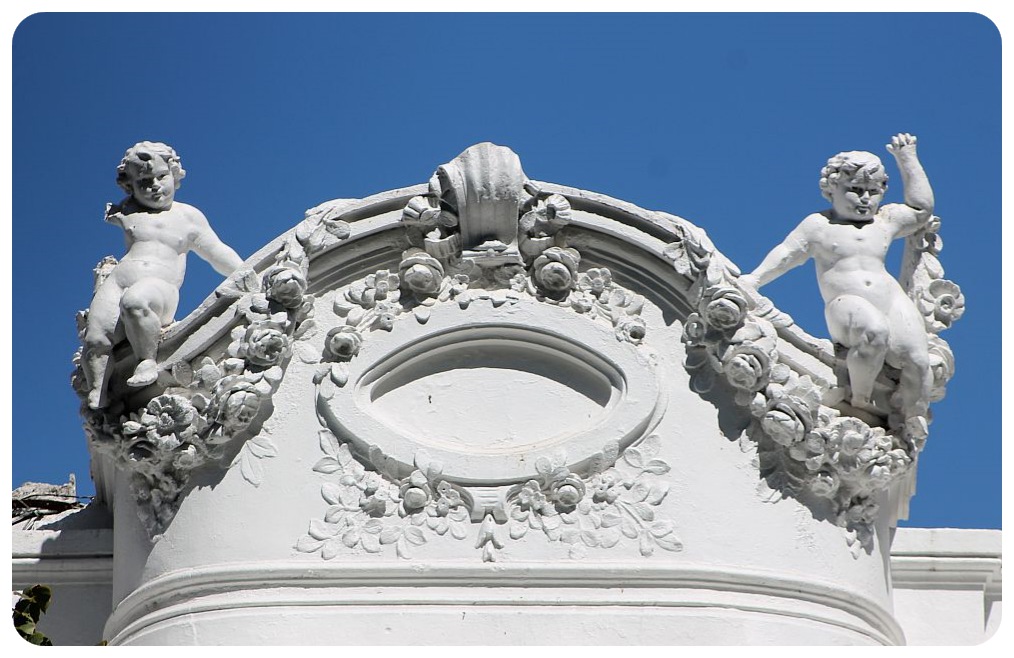
Last Updated on February 1, 2023
With Buenos Aires, Patagonia and all that wine country, we understand that Rosario can be easily overlooked on a trip to Argentina. That’s why all the Porteños (locals in Buenos Aires) escape here during major holidays. Which we only learned because our visit coincided with Easter weekend, and all of the hotels in Rosario were completely booked. Oops.
To Porteños, Rosario is a ‘quaint’ city of just over 1 million inhabitants. Here they can shop in stores that aren’t crowded, sip coffee in quiet cafes and stroll for miles and miles along the Paraná river in peace.
Unlike his image plastered across T-shirts and magnets throughout the rest of the world, we couldn’t believe how absent Che Guevara’s image is in Argentina. Even here in his birthplace, we only happened to stumble across the apartment where he was born, on the street Entre Rios 480, which is still a private residence marked only by sign out front. (The Guevara family home in Cordoba where they moved shortly after his birth is now a museum.)
Snooping around a bit, we did find a large mural of him in a nearby plaza and local friends showed us a statue made of melted keys much further outside the city center.
But if you’re really looking for beach, hit the Costanera Norte, the north coast, five km north of downtown. This stretch, along with the islands, are the best places to swim, and have sandy beaches, cafes, bars and volleyball nets.
Table of Contents
Rosario Travel Information
- Rosario is located about 185 miles (299km) north east of Buenos Aires. Buses run several times a day from Buenos Aires, Salta, Cordoba and all other major cities to Rosario – it takes about 4 hours to get here from the capital.
- There are plenty of hostels in town, but we’d advice to book well in advance, especially during Argentine holidays when the Porteños flock here. See below for recommendations.
- Three days are enough to get a good feel for the city and to see the main sights, but you can easily spend a week here, eating your way around town, chilling along the river promenade and on the beaches, explore the nightlife and the islands along the river.
The best hotels in Rosario
If you are not sure where to stay in Rosario, here are some of the best hotels in the budget, mid-range and luxury range:
Best budget apartments and hostels
- High Hostel – Beautiful hostel in a historic building. Seasonal outdoor swimming pool. Dorm beds from US$10 ; private rooms from US$20 .
- Bon Voyage Boutique Hostel – Travel-themed hostel with a lovely garden (BBQ facilities), bar, kitchen and library. Dorm rooms from US$10; private rooms from US$23 (breakfast included)
- AndiamO apartment – 1 bedroom apartment with fully equipped kitchen near Plaza Sarmiento. From US$28 per night.
- Rosario Up – Modern apartments with kitchen, Air Conditioning, balconies, city views. From US$38 per night.
Best mid-range hotels in Rosario
- Esplendor by Wyndham Savoy – double rooms from US$56 (including breakfast)
- Dazzler by Wyndham – Seasonal rooftop pool and Jacuzzi. Double rooms from US$56 (including breakfast).
- Urquiza Apart Hotel & Suites – Suites and apartments with kitchenettes. Seasonal rooftop pool, fitness center. Double rooms from US$56 , breakfast included.
- Holiday Inn Express – double rooms from US$55 including breakfast
- Holiday Inn Rosario – double rooms from US$79
Best luxury hotels in Rosario
- Puerto Norte Design Hotel – modern boutique hotel with rooftop pool (year-round), sauna and spa, near the Alto Rosario Shopping Mall. Double rooms start at U$122 , breakfast included.
- Ros Tower Hotel – 5* hotel with a heated rooftop pool and luxury spa facilities. Double rooms start at US$119 (Breakfast included)
- Hotel Casino Pullman City Center Rosario – Stylish, modern hotel with a beautiful outdoor swimming pool and an on-site casino, but it is a bit further away from the city center (about 5 kilometers). Double rooms from US$109 , breakfast included.
Related posts:

By using this form you agree with the storage and handling of your data by this website. *
Rosario: gay guide to the best bars, clubs and hotels in Rosario
Wednesday 14th of September 2016
[…] around 3-4 hours drive from the big capital city or 4-5 hours by bus, making it the ideal weekend getaway from Buenos Aires, or a nice way to cut the journey if you’re heading West to Córdoba or […]
Friday 3rd of June 2016
Sorry Limón, but where are you from? We do have some differents foods from bsas, for example The Sandwich called "Carlitos" you can only eat it in Rosario, same thing happens with the river fish, we're used to eat fresh because we're really close to it. About the accent? Of course we do! It''s not so different like Salta o Cordoba, but if you compare it to a porteño accent, you should notice it (we don't use the S at the end of words, and porteños put it in words that doesn't go with S) yes, we don't have the cold sea that the porteños have to a shorter distance, but we have "el Paraná" a brown river where we all in the summer to the beach, to chill and to practise sports all year! And finally we're are really far From being a bsas "wannabe" city, because we are proud of being rosarinos and in generally we don't like the porteño attitude!
Wednesday 4th of March 2015
As for the streets and statues that ARE named after Che-Guevara / none pre-date the 90s - when foreign tourism took off in Argentina (and globalization and CNN made Argentinians aware of the link). The emphasis of the current administration on Human Rights and the bonding with fellow Latinamericans (the anti-Americanist discourse of CFK, Chavez, Evo) also helped
Saturday 7th of March 2015
Limon - thanks so much for your comments! Some great insights on Rosario, much appreciated! I really enjoyed my time in the city :)
That is to say - Rosario is too much like B.A. (only smaller and therefore perceived by portenos as a B.A. 'wannabe') being part of the same flat humid Pampa region and and just another extension of B.A. (as are the other small cities in the humid pampas) minus the gaucho folk-lore - it offers therefore nothing different from B.A. (Rosarinos don't even have a distinct accent or local culture or food such as Cordobeses, Correntinos, Saltenos) and therefore the massive preference for the sand and beaches of the Atlantic, the sundrenched hills (sierras) of Cordoba with their wonderful Mediterrenean landscape, weather and sunshine (did I mention that ?) or the virgin pine-forests, lakes and snowy mountains of Bariloche..
Great post about Rosario, 'the hometown of Messi' nowadays I´m afraid - Che Guevara left Argentina when he was an unknown university dropout and made his whole life and exploits in Cuba (where locals nicknmaed him 'che' - as Argentinians are often called in Latinamerica - after the funny meaningless word they use to adress each other) Argentinians identify him with the International history of Communism (as does the rest of the world) and sense no particular relationship to him (learning only late in life that he was an Argentinian- his name being absent from schoolbooks, streets, plazas, etc) associated as he is with such an unrelated foreing topic (more aking to Indonesia or Angola) such a Third World peasant revolt) As for portenos heading to Rosario, it is true they find it more relaxing - whenever they ever visit (which is only if they have some relatives, or business) - the favorite porteno destinations for the holidays are the classic three (by volume of visitors): sea, hills or mountains - which is to say: Mar del Plata, Cordoba, Bariloche (and all the tourist towns surrounding them)...
Rosario and around
Book your individual trip , stress-free with local travel experts
- roughguides.com
- South America
- litoral-gran-chaco
- rosario-around
- Travel guide
- Itineraries
- Local Experts
- Travel Advice
Plan your tailor-made trip with a local expert
Book securely with money-back guarantee
Travel stress-free with local assistance and 24/7 support
Annie, Canada
What a great trip! It was so easy to communicate, got all the answers to my many questions. What a trip! Argentina wasn't on my bucket list, now I NEED to ...
Confident and stylish, with a vibrant cultural scene and a lively nightlife, Rosario dominates the whole region. With a little over 1.2 million inhabitants, it is Argentina’s third-biggest city – Córdoba just beats it to second place. However, Rosario likes to see itself as the most worthy rival to Buenos Aires , 300km southeast – in some ways it is a far smaller version of the capital, but without the hordes of foreign visitors or the political clout. It’s also the birthplace of two global superstars, football sensation Lionel Messi and revolutionary hero Che Guevara.
Places to visit in Rosario
Getting to rosario, getting around rosario, information and tours in rosario, where to eat in rosario, rosario nightlife, paseo del siglo and plaza san martín, plaza 25 de mayo, monumento a la bandera, the costanera, parque de la independencia, tailor-made travel itineraries for argentina, created by local experts.

10 days / from 2650 USD
The Great Lakes and Glaciers of Argentina
Experience the great outdoors, Argentina-style! Marvel at jaw-droppingly beautiful Patagonian landscapes, walk the shores of deep-blue lakes guarded by snow-capped mountains at Bariloche, explore the stunning Perito Moreno Glacier – experience all of this, and much more, with this unique trip!

13 days / from 3180 USD
From Chile to Argentina, across the Andean Lakes
Travel from Chile to Argentina across the stunning Andean Lakes, also known as the Lakes District. Beginning in Santiago, you will travel to Puerto Varas, in Chile, and then across the lakes to Bariloche, Argentina, taking in the stunning mountain scenery, before ending your trip in Buenos Aires.

14 days / from 1933 USD
An adventure across three countries: Brazil, Argentina & Uruguay
A trip filled with history, culture and nature spread out over three beautiful and unique countries, Brazil, Argentina and Uruguay. Visit some of the most stunning sites, like the Sugar Loaf Mountain, Iguazu Falls and UNESCO World Heritage site Colonia del Sacramento, during this 14-day trip.
Geographically the comparison with Buenos Aires certainly holds: Rosario is a flattish riverside city and major port, lying at the heart of a vital agricultural region, its streets lined with shabby but handsome buildings and lilac-blossomed jacaranda trees. Unlike Buenos Aires, however, Rosario has always enjoyed a close relationship with its waterfront; the Río Paraná, which swells to an eye-popping 2km wide at this point, features an attractive riverfront that runs for 8km along the city’s eastern edge, flanked by high-rise condos, parks, bars and restaurants and, to the north, popular beaches. One of its main attractions is the splendidly unspoilt series of so-called “delta islands” with wide sandy beaches, just minutes away from the city by boat. You can also admire some of Argentina’s finest turn-of-the-century architecture here, with an eclectic spread of styles ranging from English chalets to Catalan Modernism. In addition to the Museo de Arte Contemporáneo, housed in a conspicuously converted grain silo on the riverside, the city’s most celebrated attraction, nationally at least, is the monolithic Monumento a la Bandera, a marble paean to Argentine independence.
Brief history of Rosario
Rosario lacks an official founding date, with the settlement slowly developing in the eighteenth century around a series of Catholic missions to the local Calchaquí tribes, military outposts and estancias in an area known as Pago de los Arroyos. In 1730 the parish was established with remnants of an old mission chapel dedicated to the Virgen del Rosario – the new church was completed in 1762 and gradually lent its name to the settlement, given formal status by the colonial authorities in 1823. Despite its strategic location as a port for goods from Córdoba and Santa Fe provinces, early growth was slow: it wasn’t until 1852, when river traffic was freed up, that Rosario was granted city status and finally set on course for expansion. The city’s population was boosted further when the Central Argentine Railway, owned and largely financed by the British, was completed in 1870, providing a link to Córdoba.
By 1895, Rosario was Argentina’s second city, with 91,000 inhabitants – many of them immigrants attracted by the promise of the by now flourishing port, giving the city its soubriquet, “Hija de los Barcos” (Daughter of the Ships). In the twentieth century the city became a major Peronist stronghold, and the Partido Socialista (Socialist Party) has won every election for mayor since 1989. In 2011 Mónica Fein became the first female Socialist candidate to be elected mayor in Argentine history, and was narrowly re-elected in 2015. Other rosarino celebrities include leading artists Antonio Berni and Lucio Fontana, three of Argentina’s most popular singers – Fito Páez, Juan Carlos Baglietto and Litto Nebbia – and the late cartoonist Roberto Fontanarrosa, whose most beloved creation was the hapless gaucho Inodoro Pereyra.
Getting to Rosario by plane
Rosario’s small airport, Aeropuerto Internacional de Rosario , lies around 15km west of the city centre, along RN- 9, with 1–6 daily flights to and from Buenos Aires and a handful of other destinations. From the airport, bus #115 runs every 30min into the centre along San Luis, two blocks south of Plaza 25 de Mayo. A faster, more comfortable alternative is the dedicated Aeromovi bus that runs to the centre (Dorrego and Santa Fe) in 40min (via the Terminal de Ómnibus) every hour or so – check the schedule online. Taxi rates are fixed according to the destination: it’s $420–460 to the centre ($370 to the Terminal de Ómnibus and $4250 to Santa Fe); they’ll probably use the meter on the way back. You’ll find the major car rental desks in the terminal, plus a Banco Santa Cruz ATM, though don’t count on it working (make sure you have pesos as there is nowhere to change money).
Getting to Rosario by bus
Long-distance buses arrive at Rosario’s clean and user-friendly Terminal de Ómnibus Mariano Moreno , 4km west of Plaza 25 de Mayo, at Santa Fe and Cafferata. An information kiosk can provide you with a list of hotels and a map, and there are also plenty of cafés, free wi-fi, Banco Municipal ATMs and left luggage facilities. To head into the centre, walk to the corner of Cafferata and Córdoba and catch bus #115, #116, #133 or #142. Otherwise, plenty of taxis pull up outside the front entrance ($100–150 to the centre).
Getting to Rosario by train
Trains currently shuttle between ultra-modern Rosario Norte station (Aristóbulo del Valle and Callao) and Retiro in Buenos Aires once a day in both directions, departing Buenos Aires at 4.40pm (arriving 11.05pm) and departing Rosario 12.15am (arriving in BA at 6.43am). Retiro to Tucumán trains and Retiro to Córdoba trains also stop at Rosario Norte station once daily in each direction. See the website for more information.
Getting to Rosario by boat
Passenger boats run to the various islands in the Paraná River throughout the week, with regular services Nov–March from 10am to dusk (1 or 2 departures daily; return $260–300); out of season, services are less frequent. All boats depart from the Estación Fluvial , at De los Inmigrantes 410 on the Costanera.
Getting around Rosario by bus
Rosario’s bus system is cheap and easy to use, with bus numbers clearly marked and route maps at most bus stops. Cash fares are $19.70, but you can only pay with $1 or $2 coins (no change). If you intend to use buses a lot, get a stored-value card (MOVI or tarjeta magnética ; minimum value $25; fares $18.28) – there’s a booth selling them at the bus terminal. You can also buy them at the Centro Municipal at Wheelwright 1486 and in the centre at Santa Fe 1055.
Getting around Rosario by taxi
Taxis are easy to hail on the street; the meter starts at $53, adding $2.65 every 100m (Mon–Sat 10pm–6am, and all day Sun/hols, the rate jumps to $60.56 plus $3 every 100m). Most trips across the centre should be no more than $150–200.
Getting around Rosario by bike
Tourists can use the Mi Bici Tu Bici bike share scheme (with stations all over the city) through the website or associated app. The daily rate is $23.63 but each trip is limited to 30min before you have to dock and check out again.
Rosario tourist information
There’s a helpful tourist information office down by the riverfront, at Belgrano and Buenos Aires. It produces an informative map covering most of the city. See also Rosaria Tipica .
Rosario river tours
One long-established river trip is a 2hr river cruise on the sightseeing boat, Ciudad de Rosario , while the more intimate Island Explorer dinghies do 2hr trips from the Estación Fluvial. Paseos en Lancha Rosario offers all sorts of boat and kayak tours along the Paraná.
Rosario has plenty of restaurants to suit all budgets, both in the city centre and along the Costanera. There are some excellent freshwater fish restaurants specialising in boga , dorado (not related to the saltwater fish) and catfish-like surubí , but look out also for the “Carlitos”. This toasted sandwich – invented here and mostly served in bars – is basically a combination of ham, cheese, olives and (crucially) ketchup, and it has a cult status among rosarinos .
Rosario is noted for its nightlife, la movida , but its clubs can be a little disappointing. In summer, when all the action moves to the Rambla Catalunya, you’re limited to one or two very popular but faceless mega-discos, whose names but not character change with the seasons. The city’s popular milongas offer a more authentic experience: Rosario has a hard core of tango enthusiasts – who dance a slightly showier version of the dance than Porteños – and most nights of the week there is something going on. The tourist office should have a list of current milongas .
Rosario’s premier shopping street is Paseo del Siglo (aka Av Córdoba), pedestrian-only from Paraguay to Plaza 25 de Mayo, and lined with some of the best examples of Rosario’s belle époque architecture. Towards its western end lies Plaza San Martín, a spacious park dominated by an equestrian statue of the independence hero. On the plaza’s west side lies the former Palacio Provincial de Justicia, completed in 1892 and now part of the Universidad Nacional de Rosario (UNR). On the north side of Plaza San Martín sits the former police headquarters, completed in 1916 and now the seat of the provincial government of Santa Fe – it’s known as Casa Gris (“Grey House”) after its stark German Neoclassical design. In the southwest corner of the plaza lies the Museo de la Memoria , commemorating the political violence of the 1970s and 1980s. Heading east on Paseo del Siglo, the Bolsa de Commercio, the Rosario Board of Trade, is a gorgeous beaux-arts landmark designed by Raúl Rivero in 1926, while the 1915 Jockey Club building at Córdoba and Maipú is one of Argentina’s finest Art Deco gems.
Constructed on the site of the first modest chapel built to venerate the Virgen del Rosario, Plaza 25 de Mayo is the historic heart of the city. Today the plaza is an elegantly shady space laid out very formally around its central marble column, the Monumento a la Independencia. On the southeast of the square, at Córdoba and Buenos Aires, lies the imposing Palacio del Correo (central post office), completed in 1938. On the northeast corner is the terracotta-coloured Palacio Municipal, also known as the Palacio de los Leones in reference to the majestic sculptured lions that flank the main entrance. It was completed around 1896 and still serves as the city government building.
Museo Estévez
Despite its relatively modest facade, the Museo Estévez is a real gem, a decorative arts museum housed in a fantastically ornate mansion. It’s crammed with artwork donated to the city in the 1960s by its former occupant, Firma Estévez, in memory of her Spanish husband Odilo (who emigrated to Rosario in the 1880s and made a fortune in Argentina by selling the “Yerba 43” mate brand). It’s a stunning display – every inch of the interior is furnished and ornamented with everything from Egyptian glassware and tiny Greek sculptures to Flemish tapestry and Limoges porcelain, via pre-Hispanic ceramics and Spanish ivory figures. There’s a small but impressive painting collection, too, including Portrait of a Gentleman by French Neoclassicist Jacques Louis David, and a Goya portrait, Doña María Teresa Ruiz Apodaca de Sesma , with strikingly piercing black eyes.

Main tower of the Monumento a la Bandera located at Rosario city © Anibal Trejo/Shutterstock
Completed in 1957, Rosario’s premier historic sight is the Monumento a la Bandera , a vast monumental complex honouring the Argentine flag ( bandera ) and the heroes who have fought for it since independence. General Manuel Belgrano designed the flag in the city in 1812, lending Rosario the official title of “Cuna de la Bandera” (Birthplace of the Flag). The first section of the monument comprises a 70m tower guarding what was supposed to be Belgrano’s tomb (the general remains in Buenos Aires, as per his wishes), overlooking the river and adorned with sculptures; the whole thing is shaped like a ship’s prow, representing Argentina sailing towards a glorious future. The observation deck on top of the tower (“Mirador de la Torre”) affords stellar views of the river and city. Behind the tower, up the slope, is an amphitheatre-like space (Patio Cívico) leading to the “Propileo”, a Modernist Greek temple gateway containing an Eternal Flame (“Llama Votiva”) dedicated to those who lost their lives in the wars for independence. Beyond, the Pasaje Juramento, lined with dramatic marble figures and fountains by the great sculptor Lola Mora, links the monument to Plaza 25 de Mayo. The country’s major Flag Day celebrations are held at the monument on June 20 each year, but there’s a small flag-hoisting ceremony every day at 8.15am. Across the road from the main tower is the Cenotafio a los Caídos en Malvinas, completed in 2005 to honour veterans of the Falklands War.
Dolores Mora Vega de Hernández – better known as Lola Mora – was born on November 17, 1866, at El Tala, a tiny village in Salta Province very close to the Tucumán border. She completed her studies in Italy and took to working in marble, a medium used for much of her prolific oeuvre of statues and monuments. In addition to works in various towns and cities around the country, she is best known for her invaluable contribution to the Monumento a la Bandera in Rosario; the magnificent Nereidas fountain adorning the Costanera Sur in Buenos Aires; and the voluptuous set of allegorical figures – Peace, Progress, Justice, Freedom and Labour – intended for the National Congress building but never placed there, as they were considered too shocking. Instead the five naked forms can be admired at the Casa de Gobierno in Jujuy. Hailed as the country’s foremost sculptress, Lola had a tragic life, losing her parents at an early age, enduring a turbulent marriage and facing social rejection owing to her bohemian lifestyle and her predilection for portraying shapely female forms (leading to comparisons with Camille Claudel). Towards the end of her life, she suffered from ill health and psychological problems. She died in poverty, on June 7, 1936, shortly after reconciliation with her husband after seventeen years of estrangement and only a few months after the national government agreed to grant her a pension.
Stretching over 8km from north to south, Rosario’s Costanera, or riverfront, is one of the city’s most appealing features, offering numerous green spaces and views over the Río Paraná. Its most central park, the Parque Nacional de la Bandera , lies just to the east of the Monumento a la Bandera. At the southern end of the park is the Estación Fluvial from where regular boat services run to the river islands and cafés line the river. Every weekend there is a flea market selling crafts, antiques and books – the Mercado de Pulgas del Bajo – around Avenida Belgrano 500, which runs past the western edge of the park.
Dissected by various avenues and containing several museums, a football stadium and a racetrack, the Parque de la Independencia feels like a neighbourhood in itself. Newell’s Old Boys football club, Lionel Messi’s first pro team, was founded here in 1903 and named for Isaac Newell, an Englishman who emigrated to Rosario in his teens and went on to pioneer football in Argentina. The park itself was inaugurated in 1902 and is an attractively landscaped space with shady walkways and beautifully laid-out gardens such as the formal Jardín Francés, just west of the main entrance on Boulevard Oroño. The park can be reached on foot from the city centre via a particularly attractive walk along the Paseo del Siglo and Oroño, though it can be a hot slog in the summer – you could also take a taxi or a bus.
Monumento al Che Guevara
Acknowledgement of Rosario’s most famous son, the revolutionary Ernesto “Che” Guevara, was a long time in coming; compared with Cuba, where Che is a hero of gigantic proportions, the Argentine authorities have seemed rather embarrassed about him, and it took until 2008 for a monument to him to be erected in his hometown. The bronze statue was unveiled to commemorate what would have been his 80th birthday, but even then, it was funded by thousands of small donations from around the world rather than the government, though they did contribute the space – an out of the way, rather forlorn plaza on 27 de Febrero and Laprida, twelve blocks east of Parque de la Independencia. The statue itself depicts a larger-than-life though not, in truth, very lifelike Che striding purposefully, mounted on a concrete plinth covered in suitably socialist graffiti.
Top image: Panoramic view cityscape of the city of Rosario, Argentina © illpaxphotomatic/Shutterstock
Discover more places in Argentina

- Travel Guide Morocco
- Travel Guide Namibia
- Travel Guide South Africa
- Travel Guide China
- Travel Guide India
- Travel Guide Indonesia
- Travel Guide Japan
- Travel Guide Laos
- Travel Guide Malaysia
- Travel Guide Myanmar (Burma)
- Travel Guide Nepal
- Travel Guide Philippines
- Travel Guide Singapore
- Travel Guide South Korea
- Travel Guide Sri Lanka
- Travel Guide Taiwan
- Travel Guide Thailand
- Travel Guide Australia
- Travel Guide Fiji
- Travel Guide New Zealand
- Travel Guide Belize
- Costa Rica Travel Guide
- Travel Guide Cuba
- Travel Guide Guatemala
- Travel Guide Honduras
- Travel Guide Jamaica
- Travel Guide Nicaragua
- Travel Guide Panama
- Travel Guide Puerto Rico
- Travel Guide Trinidad and Tobago
- Travel Guide Albania
- Travel Guide Austria
- Travel Guide Belgium
- Travel Guide Bosnia-Herzegovina
- Travel Guide Bulgaria
- Travel Guide Cyprus
- Travel Guide Czechia (Czech Republic)
- Travel Guide Denmark
- Travel Guide England
- Travel Guide Estonia
- Travel Guide Finland
- Travel Guide France
- Travel Guide Germany
- Travel Guide Greece
- Travel Guide Hungary
- Iceland Travel Guide
The Rough Guides to Argentina and related travel guides
In-depth, easy-to-use travel guides filled with expert advice.

Find even more inspiration here

Planning your own trip? Prepare for your trip
Use Rough Guides' trusted partners for great rates

written by Andy Turner
updated 26.04.2021
Ready to travel and discover Argentina?
Get support from our local experts for stress-free planning & worry-free travels.
- Travel advice
Inside Argentina: A Guide to Discover Rosario
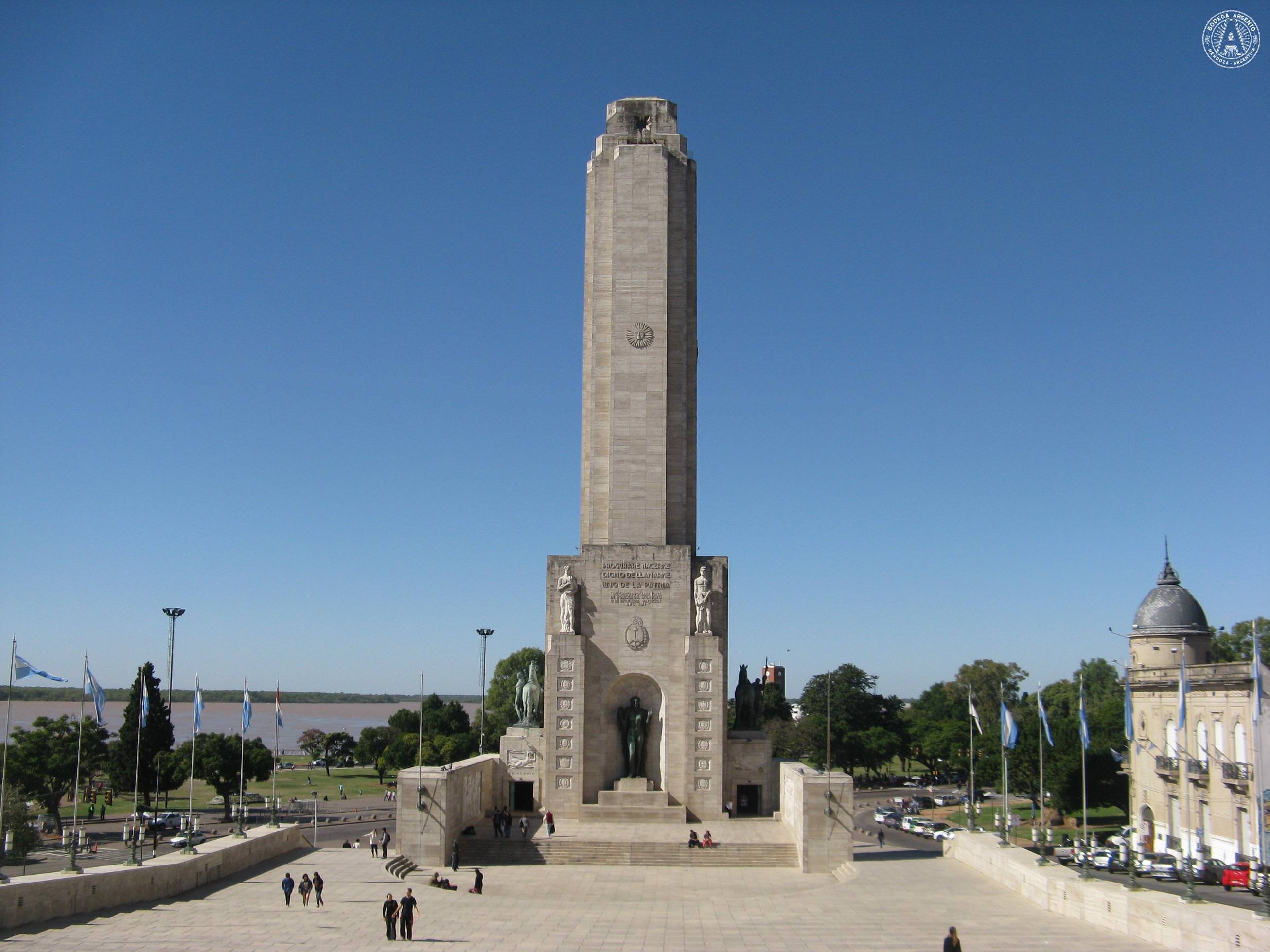
Here in Rosario the Río Paraná dominates the urban landscape, its tea-brown waters setting the scene for riverside dining, drinking, strolling, and chilling out on peaceful river islands. While Buenos Aires bursts with capital city pride, Rosario paddles its feet in the water. Dynamic and confident without being showy, culturally rich and the best urban location to cool off in the sweltering summers, Rosario is easily overlooked but not to be missed. The third-biggest city in Argentina (Córdoba just pips it to the post of second), Rosario is around 300 km to the northeast of the capital and a four-hour bus ride away. You can explore the main sights in a couple of days but you’ll probably need longer to eat your fill of surubí , get your Rosarino culture fix in a classic bar or gallery, and find your favorite sandy beach on one of Rosario’s delta islands.
Life on the River
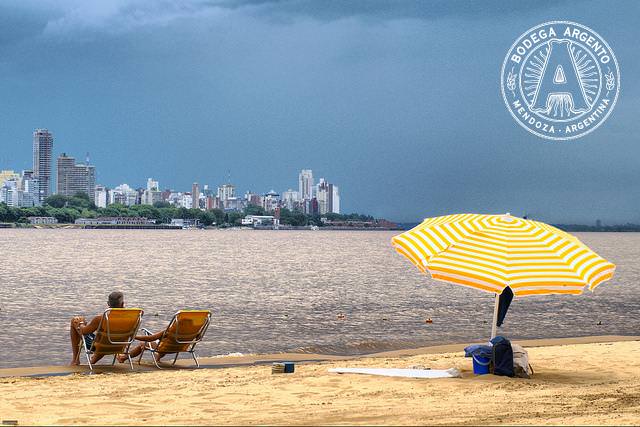
If Buenos Aires is too inward-looking for your tastes, here you can open up your vista to the water. Rosario is proud of its river, the powerful Río Paraná> , and the 15km-long waterfront called La Costanera , once home to derelict warehouses, is now a buzzing destination with restaurants, galleries, bars, and beaches competing for your attention. Wander along the promenade stopping for an ice cream, or to watch an impromptu game of fútbol or musical performance, and end the afternoon with a coffee or glass of wine watching the boats chug past.
La Florida (Avenida Puccio and Avenida Escauriza, at the northern end of the city) has a sandy beach where you can swim, with bars, cafes, and volleyball nets. The brownish water is not to everyone’s taste but in the summer you can wear your swimsuit, catch some rays and cool off with the river breezes.
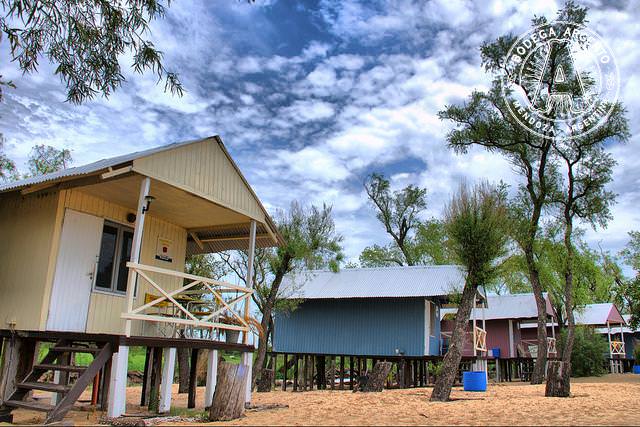
For an even more watery experience, take a boat trip to the islands in the subtropical river delta. Various boats and ferries leave from near the Monumento Nacional a la Bandera to the island beaches, or you can stay on board and take a tour through the mostly uninhabited, bird-filled streams and leave the ice cream stands and the beach umbrellas behind.
Rosario Outdoors
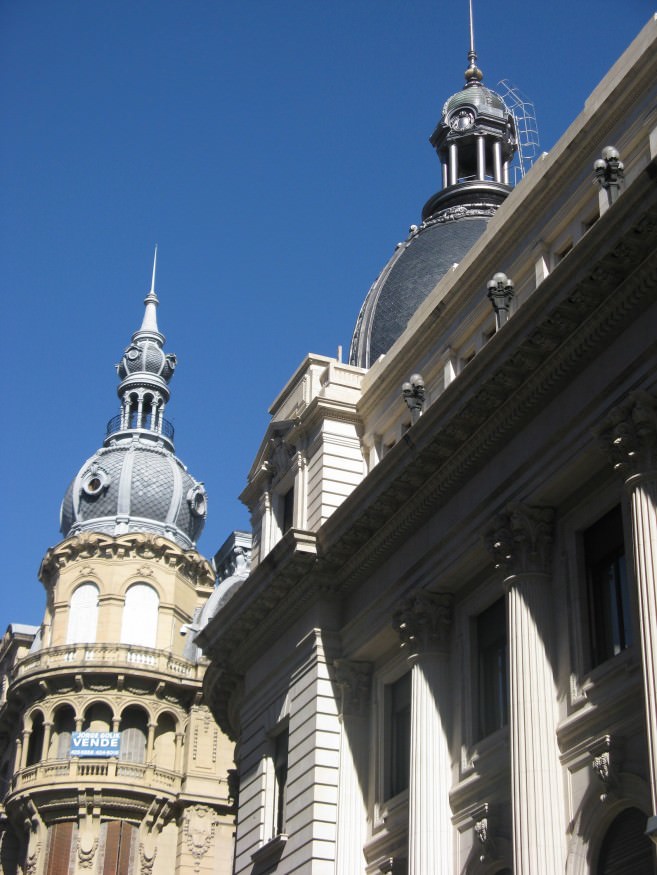
Walk down Boulevard Oroño on a Sunday morning when it’s opened up to pedestrians and you can take in the grandeur of the architecture without the traffic. Rosario is made for strolling on Sundays; the cobbled, tree-lined avenues and ornate, classical buildings boast the splendor of Buenos Aires without the urban chaos. End up at Parque de la Independencia , a busy, spacious park filled with lakes and paddle boats, families sipping mate on the grass, and play areas for the kids. Outdoorsy children are well-served in Rosario with the adventure-filled Jardín de los Niños inside Parque de la Independencia, the Granja de la Infancia , an urban farm and natural reserve, and La Isla de los Inventos , a science and investigation center for kids big and small.
Rosario’s Famous Names
Rosarinos , people from Rosario, are notably down-to-earth and friendly, and they are proud of their local heroes. Rosario is the birthplace of, in no particular order of importance, Lionel Messi , Che Guevara , cartoonist Roberto Fontanarrosa , popular singers Fito Páez , Juan Carlos Baglietto and Litto Nebbia , and the Argentine flag.
Che Guevara’s birthplace is a modest apartment at Entre Ríos 480 (it’s a private residence so you can’t go in). You can visit the bar most associated with Argentine cartoonist and writer Roberto Fontanarrosa. It’s called El Cairo, on Sarmiento and Santa Fe, is famous for its artistic and intellectual patrons and was immortalized by the cartoonist in his book “La Mesa de los Galanes” . And you will surely notice the birthplace of the flag.
Honoring the Flag
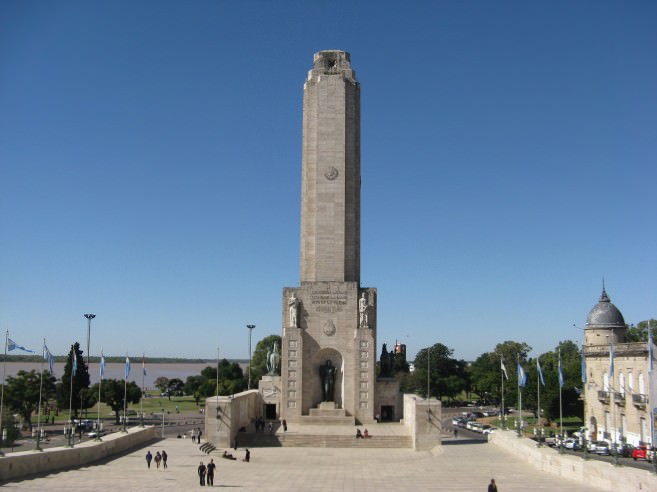
In contrast to images of Che, you’ll see the Argentine flag everywhere you go in Argentina. In Rosario the monument to the flag, Monumento Nacional a la Bandera , is a fittingly monolithic homage. You can’t miss the monument just off the waterfront at Santa Fe and Belgrano, constructed where the celeste -and-white stripes were first raised. The flag’s designer Manuel Belgrano rests in state in a crypt below the obelisk and the flame in the center of the ornate colonnade burns continuously in tribute to those who died for Argentina.
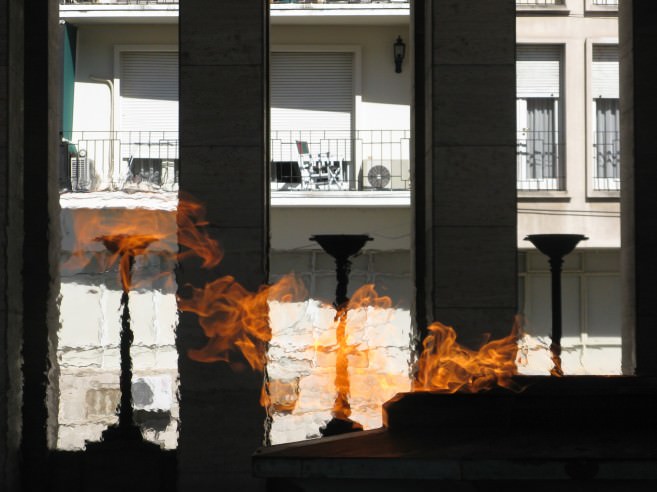
Take the elevator up to the top of the obelisk for sweeping views across the river and the islands. If you can, visit at sunset and sit on the steps while the stone turns orange and the skies darken over the delta.
Cultural Rosario
Rosario is a notably cultural destination and if you want to spend a few hours gazing at works by modern Argentine artists, listening to contemporary music or traditional folk songs, or even just sipping a coffee in an art museum with views over the urban canvas, this is your city.
The Museo de Arte Contemporáneo de Rosario (MACRO) is a vibrant, multicolored edifice characterized by its painted grain silos on the waterfront at Boulevard Oroño. MACRO has exhibitions of young artists and local talent as well as a viewpoint over the islands from the top floor. The Museo Municipal de Bellas Artes on the corner of Pellegrini and Oroño has some fine traditional pieces of art and regularly changing exhibitions.
Rosario Food and Drink
It’s all about the river fish in Rosario. Think Paraná heavyweights like surubí, dorado, pacú and boga served with hefty salads and masses of bread and potatoes. But if fish aren’t your thing, plenty of other choices abound in Rosario to tempt your taste buds. And to wash down the surubí ? Torrontés , of course. And the steak? Why not an Argento Malbec , or a nice glass of Argento Bonarda . Here are a few Rosario favorites to whet your appetite.
La Estancia on the Pellegrini street is a classy parilla with some stunning cuts of meat (and a good selection of fish). While it’s been around for over 25 years, La Estancia still pulls in the crowds to its cavernous dining room (Pellegrini 1510).
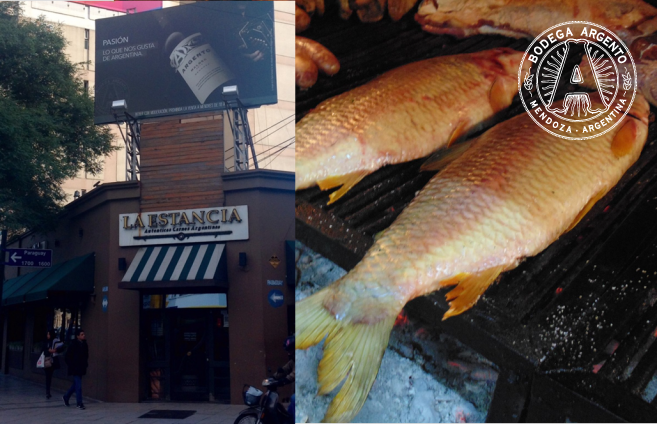
Downtown Rosario , is a lively, relaxed place for unwinding over a chilled beer or a large glass of Argento Malbec from their luxe cava. Also serves a variety of global dishes (Urquiza 1285).
Escauriza is arguably one of the best places in the city to get your fresh seafood fix. Located behind the beach at Florida in the north of Rosario, Escauriza is a spacious place with a legendary fish barbecue (Balada Escauriza & Paseo Riberebo).
The basement of La Marina Restaurant , set close to the flag monument, is papered with old-fashioned posters and serves a wide range of tasty, inexpensive dishes like river fish and rabas – calamari (1 de Mayo 890).
Davis occupies the heart of a glass cube and boasts some stylish riverside seating for a drink or two. The food inside the restaurant is pricy but worth it for the ambience and the freshness of the fish (Av de la Costa 2550).
Check out the urban classic Don Leo for parilla dishes with style (Pellegrini 971). Or try the locro and traditional Argentine favorites at the Restaurante El Nuevo Cid (Río de Janeiro 1082), classic barbeque fare at El Parrillón de Pichinch a (Alvear 298) or sample the wide selection of fish and seafood at Puerto Gaboto (Pellegrini 584).
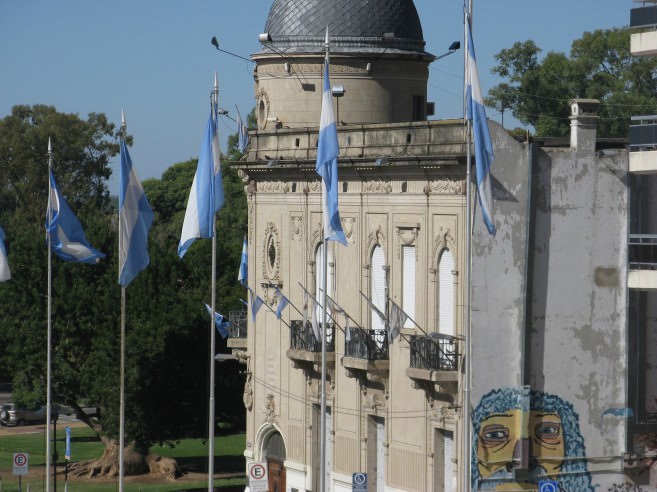
- Latest Posts

Louise Carr de Olmedo
Latest posts by louise carr de olmedo ( see all ).
- 12 FRESH ORGANIC OPTIONS IN BUENOS AIRES - December 15, 2016
- WHERE TO EAT VEGAN FOOD IN BUENOS AIRES - December 15, 2016
- WHERE TO GO GLUTEN FREE IN BUENOS AIRES - December 15, 2016
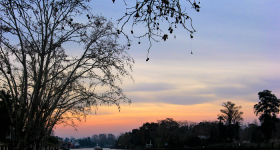
Leave a Comment Cancel reply
Your email address will not be published. Required fields are marked *
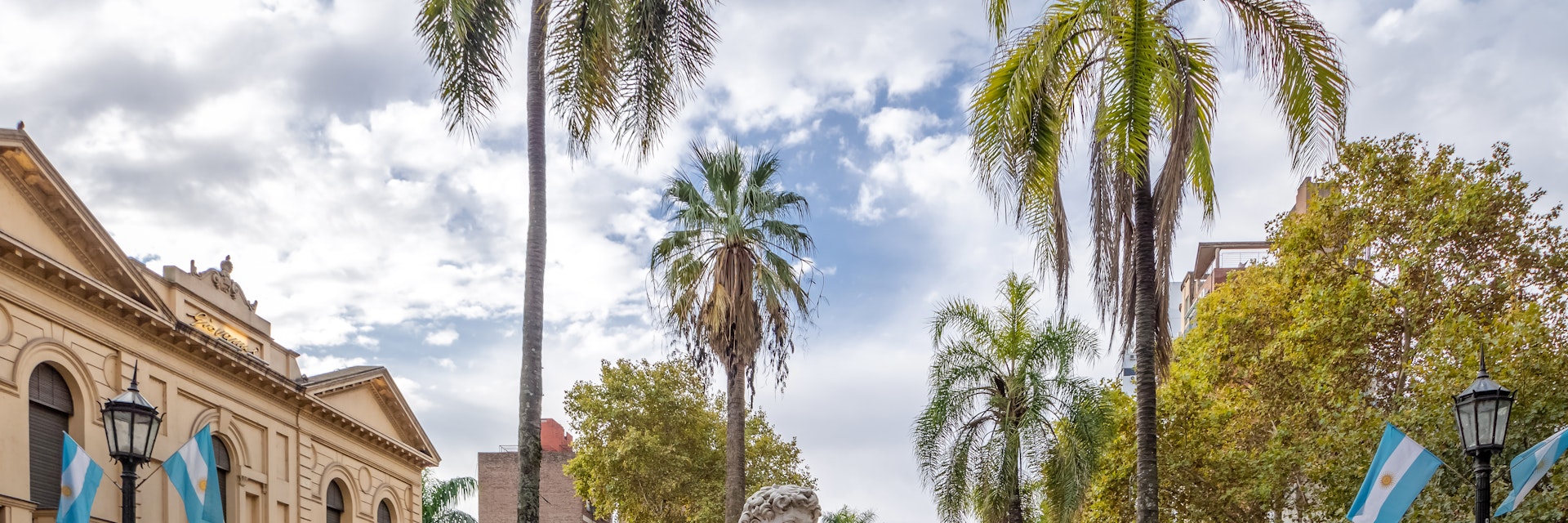
Shutterstock / Diego Grandi
Birthplace of the Argentine flag as well as two of the nation's most famous exports, Che Guevara and Lionel Messi, Rosario is still an important river port but has done a great job of regenerating its center. The derelict buildings of the long costanera have been converted into galleries, restaurants and skate parks, and river beaches and islands buzz with life in summer. The center – a curious mishmash of stunning early-20th-century buildings overshadowed by ugly apartments – has a comfortable, lived-in feel, and the down-to-earth rosarinos (people from Rosario) are a delight.
Leave the planning to a local expert
Experience the real Rosario. Let a local expert handle the planning for you.
Attractions
Must-see attractions.
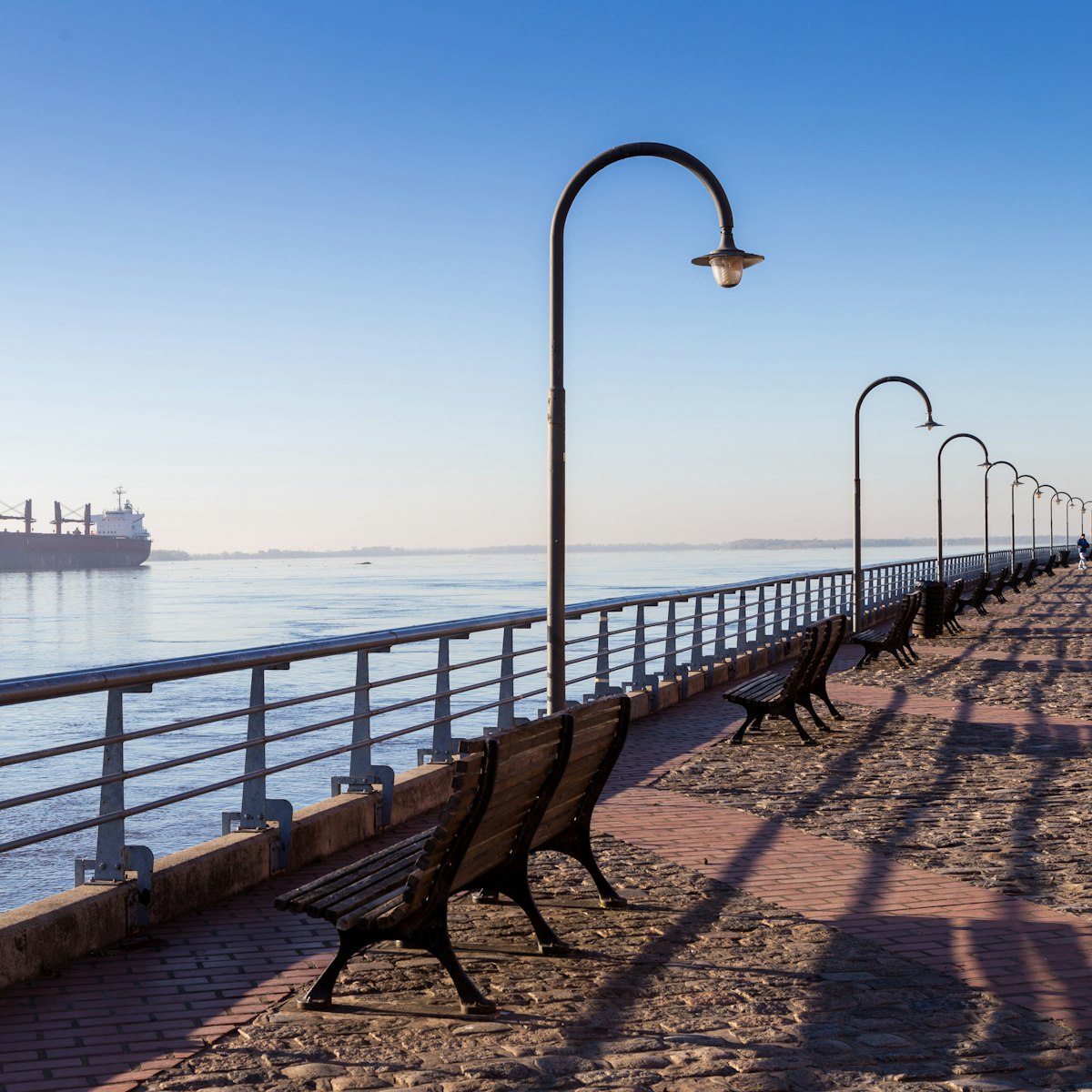
Rosario’s most attractive feature is its waterfront, where the area that was once derelict warehouses and train tracks has been reclaimed for the fun of…

Museo Municipal de Bellas Artes
This gallery is worth a visit for its inventive displays of contemporary and 20th-century artworks from the MACRO collection, and its small collection of…

Paraná Delta
Rosario sits on the banks of the Río Paraná upper delta, a 60km-wide area of mostly uninhabited, subtropical islands and winding riachos (streams). It’s…

Costanera Sur
The grassy zone below downtown includes plenty of space for jogging and courting, as well as the Estación Fluvial building, where you can find eating and…

Museo de Arte Contemporáneo de Rosario
Housed in a brightly painted grain silo on the waterfront, this museum is part of Rosario’s impressive riverbank renewal. It features temporary…

Monumento Nacional a La Bandera
Manuel Belgrano, who designed the Argentine flag, rests in a crypt beneath this colossal stone obelisk, built where the blue-and-white stripes were first…

Museo Histórico Provincial
The well-presented collection features plenty of post-independence exhibits plus excellent displays on indigenous cultures from many parts of Latin…

Museo de la Memoria
A former army HQ, not far from where police held, tortured and killed people during the Dirty War, this museum seeks to remember the violence and victims…
Plan with a local
Experience the real Argentina
Let a local expert craft your dream trip.
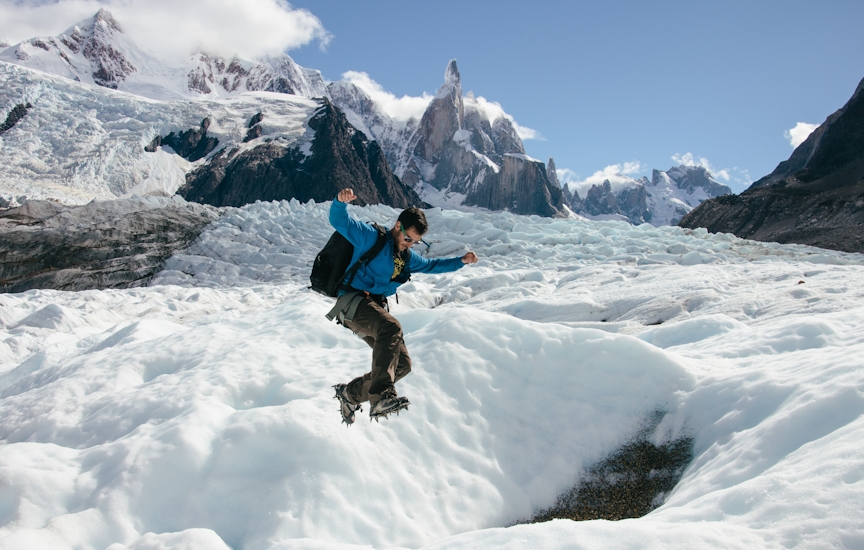
in partnership with getyourguide
Book popular activities in Rosario
Purchase our award-winning guidebooks.
Get to the heart of Rosario with one of our in-depth, award-winning guidebooks, covering maps, itineraries, and expert guidance.

Rosario, Argentina – City Guide for Nomads and Expats
October 8, 2017

Updated in 2022.
Rosario, Argentina.
Located in Central Argentina, it is the third largest city in the country.
It is known for its neoclassical architecture, and for being the country’s most liberal and socialist city. It is also the birthplace of renowned artist Guillermo Forchino. There is an abundance of bars and hostels in the city.
POPULATION: 1,200,000
Skip the guesswork and develop your optimal Latin Life with our consultation services:
Schedule Your Personal Consultation With My Latin Life
Table of Contents
IS ROSARIO SAFE?
Rosario is considered to be one of Argentina’s more dangerous cities. That said, violent crime is pretty rare, but be conscious of bag and purse-snatchers and pickpockets. The city also seems to have a bit of a drug problem…like a junkies on sidewalks and under bridges sort of thing. Like you might see back home! However, users generally won’t trouble you. Its reputation is worse than the reality…but keep your guard somewhat up nonetheless.
RENT AN APARTMENT IN ROSARIO
$400.00 is doable.
BEST BARS & NIGHTLIFE IN ROSARIO
7.5/10
While not quite as manic as Buenos Aires , Rosario offers more than it’s fair share of party. Most of it lies in Centro , between Parque de la Independencia and the Rio Parana. Nightlife here gets started very late in the evening – around 2:00 am – so don’t bother going out much earlier than that unless you feel like going to a chill bar. Drink a good Mendoza wine while you wait for things to get started.
I recommend: Try Kubrick Bar. It’s usually gets a decent crowd of young people, and the atmosphere is unpretentious.
COST OF LIVING IN ROSARIO
The following data is from Expatistan, a crowdsourced database of prices and cost of living around the world. In our experience, the data tends to underestimate cost of living, so take the following as the minimum you might need to live here.
*Figures are listed in USD
You’ll need a minimum of $546 USD/month to live in Rosario, Argentina

HOW TO GET TO ROSARIO
Rosario is halfway between Cordoba and Buenos Aires. You can easily get to Rosario by bus from either of these cities. Rosario is also a 2 hour drive from Santa Fe.
FINAL THOUGHTS ON ROSARIO
Rosario is an eclectic city. It coexists as a working-class port, as well as an artistic hub. The students bring both engaging nightlife and contemporary artistic flair, all against a backdrop of stunning neoclassical architecture. If you visit Argentina, don’t just stay in B.A; Rosario deserves a good amount of time as well.
OVERALL RATING: 8.25/10
If you enjoyed this city guide, check out another one of our 100+ city guides to nearly every city in latin america .

- September 30, 2016
The story of Rosario
- Continent: South America
- Country: Argentina
- Categories: city travel
- Tags: LatAm , Rosario
Sandeepa Chetan
Or why should rosario travel be part of your itinerary in argentina.
That’s how the stories of most civilisations go.
But this isn’t the story of how Rosario, the city on the banks of the river Parana became the third largest city in Argentina.
This could be the story of the Monument to the National flag of Argentina, the Monumento Nacional a la Bandera

One big idea – sometimes, that is all it takes to make a world of difference. This came in the form of the Monument to the National flag of Rosario.

It gets crowded here, in the tiny balconies jutting out of the tower. Take your time to adjust to this height, and mind your hair covering your face in the gusts of wind. 360-degree panoramic views of Rosario unfold.

From the road facing balconies, you see a lesson in geometry. Neatly laid out parallel roads with perpendicular lanes merging in.

The story could be littered with the charm of tree-lined avenues and parks

Lined by important looking houses – palatial architecture but now in a need of renovation. At regular intervals, this walking path broke at a crossroad, letting traffic crossover. The pathway gave way to a park. Another massive park called Parque Independencia.
(Remember, we are still in the middle of a “regular” city – not a “quaint little hill town”).

Manicured gardens, lakes, sports clubs, skating rinks, stadia, open spaces for cultural events, fairs – and a good number of food trucks – the Parque Independencia has more than enough to spend an entire leisure filled day.
Leave home. Stroll to Parque Independencia. Find a tree. Spread out your mat. Open your book. Sip your mate (of course, this is Argentina!). Hungry? Grab a salchicha baguette from a nearby stall. Unless you have packed in some facturas dripping with dulce de leche ! Afternoon siesta. Followed by a boat ride in the lake. Loosen up with a walk along the leafy paths. Play with the beautiful dogs who are enjoying their day out as well. End the day with dinner at a parrallia (Argentinian steak house). Followed by the famous helados (ice creams!) of Rosario.
Yes, it was a beautiful life we pictured, if we weren’t just on a short visit to Rosario, but lived here in Rosario, one with the Rosarinos.

The story starts to get warm and fuzzy with the “Community”
“Do you eat meat?”. It’s the first message we receive in the morning from Alexandro. We’ve never met Alexandro before. Which is quite often the case when you stay over as a Couchsurfing guest.
But here’s the thing about the Couchsurfing community in Rosario – we never ever wrote to anyone. No introductory messages saying “We are Sandeepa and Chetan, travelers…”
Our friend whose family we stayed with in Buenos Aires is from Rosario. He informed his sister we were visiting. That set the ball rolling. Between that message sent late evening and the early the next morning when we reached Rosario, we had heard from his sister who would meet us for breakfast. She was leaving for Uruguay that weekend, so couldn’t spend more time together.
She contacted Alejandro, who said we could stay with him. A hair stylist, trained in Europe, now teaching a practising in Rosario!

It was the “friends week” in Argentina. Celebrations here don’t end with a few “Happy Friendship Day” messages forwarded over the phone. Friends do really meet and spend time together. That evening Alejandro was meeting his friends over for as asado . Which is why he wanted to know if we ate meat. He invited us over to join him.

Through Couchsurfing, we have often lived with a family, had a real home in a new city. But during our visit to Rosario was the first time, we met a Couchsurfing community – who were a family. Welcoming guests together. We may have stayed at Alejandro’s but we were hosted by the city of Rosario. Was this the magic of the river Parana, we were beginning to wonder!
This IS a story of clown schools – and what they stand for
On our first evening in Rosario, after the visit to the Monument of the National Flag, we headed to the riverfront. It was a pedestrian only path, with the usual suspect of walkers, joggers, cyclists. Walking amongst them all with the Parana river on one side and gardens on the other, we hear sounds of clapping and laughter. Turns out, the sounds were coming from those tiny identical structures we had seen from above.

In such situations, someone comes up with a brilliant suggestion. And everyone – the decision makers, implementers and the common man – support it. Doesn’t happen often, in fact, happens very rarely. And in the case of Rosario, it did happen.
These warehouses – solid wood structures by the river – were converted to clown schools! Yes, there is such a thing as a clown school – we had no idea until we decided to travel to Rosario. These schools have 2- or 3-year programs. Students can master in various disciplines like acrobats, juggling, acting, magic – all the arts that leave people enchanted!

The audience had many little kids, seated at the front. Many friends of the clown students. Someone was recording the entire show (presumably, a staff member, for evaluating the students). The rest were all Rosarinos, who had just chanced upon a “clown show”.
On Sunday mornings, the roads leading to the riverfront are closed for traffic. People get on these streets for all sorts of activities. Entire families are skating together. Children are out on the roads, cycling with their parents. Couples are jogging together. Friends have got together for a run. The happy faces of the Rosarinos are out on the streets.

Well done, Rosario, well done!
Travel Tips for visiting Rosario
- It might sound obvious and redundant, but our first travel tip for Rosario is – include Rosario in your travel itinerary for Argentina. It generally gets overshadowed by big brother Buenos Aires and the likes of Iguazu waterfalls and Patagonia .
- There are things to do in Rosario in the summer as well as winter. Rosario is studded with museums – from contemporary art to natural history.
- The Parana river has created many beaches along Rosario, especially in the northern part of the city. Kayaking along the river delta and picnicking on one of the many islands is a popular summer activity in Rosario.
- We stayed in the Hostel La Casona de Don Jaime 2 and Suites , Hosteling International (HI) hostel. The birthplace of Che Guevara is at a walking distance from this hostel. The family has now restricted entry into the house, though. Ardent fans can view the place from the outside.

Has the story of any city made you feel happy about traveling there? Tell us in the Comments !
More travel stories from argentina.

Share this on
Related posts.

Unique cultural experiences in Pune
Pune is famously known as the cultural capital of Maharashtra. These cultural events in Pune are some of the best times to visit this city.

Exploring Hyderabad: Places to visit and eat at
We had heard a lot about Hyderabad’s culinary heritage but didn’t have a local contact to help us discover the hidden treasures. We took to social media for suggestions on-the-go using our swift Airtel 4G. From unknown monuments of the Nizam’s era and one-of-a-kind ice cream parlours to inspiring stories of overcoming all obstacles, we discovered Hyderabad through the eyes of the “virtual” locals.

Wellington beyond the tourist attractions
An extra day in Wellington meant we could see parts of the city beyond the Wellington waterfront. We started our exploration with the Botanical garden.
17 thoughts on “The story of Rosario”
Thanks for providing such a beautiful post. It is really refreshing. The world has more to offer besides USA and UK.
ha ha ha cycle on the street light stand… Amazing Photographs
Lovely, lovely story! Loved both the parts. I always like it when it involves people, their warmth, their emotions. So my kind of post. 🙂 Marking this post for my visit to Argentina, whenever that happens.
Hey Nisha, nice to hear from you! After a while, places feel all the same, right? Mountains, lakes, cafes, plazas. But the people – they make the lifetime memory. We are now friends with so many of the people we met in Rosario – through them, we continue to have a connection with Rosario, even though we are so far away. For Argentina, do have a look at the story we wrote about the people we met in Buenos Aires as well. Thank you once again, for writing to us and hope to see you here again!
Very well portrayed ! Lovely post.
There is that story, and then there is your story which makes the former come alive! Lovely journey for you, I saw some pics from your travels on Insta…amazing they are!
Hey Alok, thank you! So happy to read your comment about connecting the stories. That is essentially what we try to do always – tell the story of the place that we travel to through the story that we experience. Delighted to know you could feel the same! Rosario was such a wonderful story in our travel life!
In the photographs showing works of Lola Mora, the sky is so clear! There is no distinction between sky and water!
Beautiful pictures. Such nice and clean cities. Such gorgeous architecture. Looking at these I feel so sad, why our cities cannot be as neat, clean and beautiful? Argentina is not very different in prosperity compared to India. Is it?
Hello Abhiray, you have related the exact same things that we felt travelling in the South American cities. Argentina, in fact, is coming up from a major economic meltdown. Even then, their big cities like Buenos Aires are way cleaner than our own. Rosario was a class apart. The way the people and the administration showed the will to restore the glory of their river Parana, preserved its value to the city – reflects the desire of the people to live in a “good” city.
very nicely portrayed…
Thank you, Himanshu!
Lovely pics that reflect the unique culture!
Thank you, Raj! It is interesting that you mention the culture. Because even though Buenos Aires gets the limelight for all things cultural, Rosario has its unique flavour to offer.
Will never be able to travel to Argentina but will be able to feel it through this blog of yours 🙂 Lovely… waiting for more…
Hello Subhadip, thank you so much! Have a look at more of or stories from Argentina .
Comments are closed.
Excited about Travel?
- 1.1 Weather
- 2.1 By plane
- 2.2 By train
- 3.2 By bicycle
- 3.3 By taxi
- 4.1 Museums
- 7.2 Mid-range
- 7.3 Splurge
- 7.4 Burgers
- 7.5 Ice cream parlours
- 11 Stay safe
- 12.1 Consulates

Rosario is the third largest city in Argentina and the largest city in Santa Fe province, at the Paraná river. It is known for its rich architectural heritage and beautiful riverside scenery, and offers a vibrant cultural and night life.
The city itself has about 1.1 million inhabitants, but considering the suburbs it rivals Córdoba in importance, with about 1.6 million living in the metro area. Economically it is the second most important port of the country and an important industrial hub, with a large and renowned university. In modern times, it is also known as the hometown of famous Argentinian fútbol world champions Lionel Messi and Ángel Di María; there are numerous murals of them around the city. The local derby, Rosario Central vs Newell's Old Boys, is also one of the most iconic in South America, and indeed of world football.
Understand [ edit ]
The third most populated city of the country, Rosario is gradually becoming a tourism destination. The attractive city center has some of the finest art nouveau buildings in Argentina. Also, Rosario has developed a good skyline in the area near the river. There are lots of beautiful parks, good riverside beaches for the hot summer days, and many museums.
Rosario has a reputation for being one the most liberal and tolerant cities of the country. It has a vibrant LGBT scene and is governed by left-wing mayors since the 1980s.
Being located at a major drug-trafficking route, Rosario has a somewhat bad reputation for being a hub of crime - one of the nicknames is Little Chicago - but tourists normally won't get affected, as the problematic neighborhoods are well outside of the city center and the interesting areas for tourists are not more dangerous than in Buenos Aires or Córdoba.
Weather [ edit ]
Rosario has a temperate climate, and is known for changeable weather conditions. The average annual high is 23.4°C (74.1°F) and the low is 11.6°C (52.9°F). The annual rainfall is 1,038 mm (40.9 in). Summers are hot and humid with thunderstorms that can bring a lot of precipitation. However, sunny days are common. Spring and fall have pleasant weather, featuring warm days and cool nights. Winters are generally cool though occasional cold air masses from the south can cause temperatures to drop below freezing. However, sunny weather and warm days can also occur during winters.
Get in [ edit ]
By plane [ edit ].
There are daily flights (50 min) from Buenos Aires Aeroparque Airport and Ezeiza Airport , although still the more convenient way to get into the city is to hire transport at EZE Airport. It is a four hour trip. There are also flights from/to Brazil , Perú , Panama , and Uruguay .
By train [ edit ]
Trenes Argentinos runs a daily train from Buenos Aires . After a renovation in 2015 the service is improving slowly, but compared to buses the train is still slower. Additionally, twice a week there are trains from Córdoba (via Villa María) and San Miguel de Tucumán (via Santiago del Estero). These trains are still very cheap, but slow and you must reserve your ticket well in advance. Train services from the provincial capital Santa Fe are still suspended.
Rosario has two railway stations, in general disembarking at Rosario North is preferable as it's closer to downtown.
By car [ edit ]
Two freeways (autopistas) connect Rosario with Buenos Aires, Santa Fe, and to Cordoba. Locals take the bus, a remisse (a private taxi service), or hail one of the many taxis roaming the area.
By bus [ edit ]
The most cost-effective and convenient way of travelling in Argentina. Rosario is approximately a four hour bus journey from the capital Buenos Aires , and there are many buses departing daily from the Rosario bus station to almost every city in the country. It is also possible to travel by bus to southern Brazil , Chile , Peru , and Bolivia . EGA bus lines operates a daily bus direct to Montevideo , leaving at 23:50 and arriving in Montevideo at 08:30 next morning.
Get around [ edit ]

The only forms of public transportation in Rosario are above ground: the bus system and a trolleybus line. As in other Argentine cities, there is a system with rechargeable prepaid cards.
By bicycle [ edit ]
Rosario is one of the most bicycle-friendly cities in Argentina. The cycleway network is almost as large as the Buenos Aires one, although the city is significantly smaller, and the flat topography makes the city ideal for using this kind of transport. There is a public bicycle renting system in the city centre, Tu Bici Mi Bici , with automatic stations.
By taxi [ edit ]
Rosario has a plethora of very inexpensive taxis all over the city. In the city center and surrounding areas, you should have no problem finding a taxi at any hour of the day between 7:30am-midnight. On weekends, taxis are very easily accessible much later in the night. Due to their ease of accessibility and their relatively low cost, taxis are an excellent way to get to know the city.
See [ edit ]

Historical journey through the boulevards, appreciating the city's architectural wealth
- -32.942419 -60.642321 2 El Che Guevara birthplace house , corner of Urquiza St and Entre Rios St . The house where Ernesto Guevara was born. As of 2019, it's not open to the public. ( updated Sep 2019 )
Museums [ edit ]
It has a great variety of museums from art to science and natural history
Do [ edit ]
Rosario is swimming with things to do for both tourists and locals. Providing an adventurous variety of services such as: kayaking, biking, skydiving, horseback riding, sailboating, Spanish classes, dance classes in both folklore and tango, guitar and drum classes, as well as capoeira and many others.
You can go to the beach at the river's edge, locally referred to as La Florida , to enjoy a cold drink on a summer's day, or cross the river to the island and spend a day at the beach. Either way you will find a wide variety of bars and restaurants with a spectacular view of the Parana !
Also known for their nightlife, which amazingly starts around 02:00 (with luck) and ends as the sun is coming up, Rosario counts on a large variety of night clubs and discos to dance the night away!
Rosario is also known as the Salsa Capital of Argentina. Wednesdays and Sundays are the most popular days at Willie Dixon's.
- Polyglot Meetings . You can meet locals at a weekly gathering. The meetings are part of Language Exchange International and Polyglot Club.
- Islands . take a boat from passenger terminal near Flag Memorial ( updated Sep 2019 )
- Acuario del Río Paraná , Av. Eduardo Carrasco S/N. Lots of cichlids on display, plus special attention to the Parana River ecosystem.
Buy [ edit ]
American travellers might be surprised to see that many of the goods sold in “el centro” (city centre / downtown), are much like that in any mall. Goods that might interest travellers, however, are the leather handbags, wallets, belts, and accessories. A must-see shop in that area is Raices, the perfect shop to pick up a purse or mate set.
Also note that, although the currency difference, apparel, shoes, handbags, etc., are not that much cheaper than in the US. If you're looking for a bargain, stick to the street vendors and artisans posted up around El Centro and the park surrounding the Argentine Flag Monument.
A great store not found in Buenos Aires (possibly anywhere in Argentina) is called Underworld . It is found in a number of locations in Rosario and stocks different and interesting t-shirts and other funky clothes and accessories for girls.
Alto Rosario is a shopping center that contains a large grocery store, clothing stores, electronics stores, convenience stores, a food court, and anything else you might imagine to be in a standard mall. The Alto Rosario is a great place to get all your shopping needs in one place. It is located at Junín 501.
- -32.93976 -60.67021 1 Mercado del Patio , Cafferata 729 . Gastronomy market, where you can buy and eat any number of things. ( updated Jul 2021 )
Eat [ edit ]
Budget [ edit ].
- Rincon Vegetarian Restaurant ( Mitre St between Córdoba St and Santa Fe St ). For ARS11 you get an all-you-can-eat buffet with all sorts of innovative vegetarian goodies. Good if you want a break from steak.
Mid-range [ edit ]
Splurge [ edit ].
- -32.955976 -60.646625 1 Parrilla la Estancia , Av. Pellegrini 1510 ( Av Pellegrini and España St ), ☏ +54 341 449-8052 . Great asado, empanada, and wine dinner. ( updated May 2017 )
Burgers [ edit ]
On Rosario there are various places where you can to eat burgers.
Ice cream parlours [ edit ]
The city of Rosario is known as the capital of handcrafted ice cream.

- -32.955499 -60.638161 2 Touche de Creme , Zeballos 953 , ☏ +54 341 679-1214 . 16:00-23:00 . ( updated Mar 2019 )
- El Sallvador.
Drink [ edit ]
Rosario is known for having big nightclub nights all week long. Ask around to find out where the hip place is for the night you want to go out and don't plan to be home until the morning. It is also famous for having a disproportionately large woman/man ratio (more women). Craft beer is also becoming very popular among the locals, and many microbreweries are popping up around the city.
- Rock & Feller's , Bv Oroño 106 , ☏ +54 341 423-4002 . Big, high-energy, rock-and-roll themed bar/restaurant. Very popular among the young and trendy crowd. Has great drink specials and bar food. Located on one of Rosario's busiest streets, the Oroño Boulevard.
Sleep [ edit ]
- Cool Raul Hostel , 1670 San Lorenzo . A great hostel with a relaxed atmosphere and super friendly hosts right near the main shopping strip. A fun, chill place to meet people and hang out. Minihostels members receive a 10% discount.
- Hostel Allegro Piu , Crespo 978 ( Close to terminal ), ☏ +54 437-5972 , +54 430-0848 . Big, clean, good facilities and boring.
- Livin' Residence Rosario , 3 de Febrero 2505 , ☏ +54 341 5301717 , [email protected] . Offers guests ten apartment units.
Connect [ edit ]
Stay safe [ edit ].
With some common sense, the average tourist should have no problem staying out of trouble in Rosario. While the city has gotten a somewhat bad reputation for gang violence in the past, this gang violence is very unlikely to affect travelers. One problem that does occasionally affect both locals and travelers, however, is theft, which has been on the rise over the last couple of years. Many locals and travelers have reported having their belongings such as wallets, phones and jewelry stolen by assailants, sometimes even in broad daylight. To avoid this, one should be extra vigilant when walking in places that are not too busy, especially at night. Try and make sure you only venture in crowded areas. Should you be the victim of a mugging, cooperate with the assailant's demands by handing over what he is requesting (refusing to cooperate can lead to further consequences), promptly leave the area, and report the incident to the police. While the police may be unlikely to help you recover your belongings and arrest the assailant, police in Rosario are generally friendly and willing to help.
One should also be extra careful to not venture into or around the slums, or "villas" as the locals call them. These villas are no place for a tourist, as they can sometimes be the hotbed for crime and house Rosario's most impoverished residents. They are usually scattered throughout the outskirts of the city, though there are some not too far from the city center such as the one in between streets Vera Mujica and Av. Francia Bis. in the north of the city not far from the Alto Rosario shopping center.
Cope [ edit ]
Consulates [ edit ], go next [ edit ].
- Has custom banner
- Verbose Climate graphs
- Has map markers
- Has mapframe
- See listing with no coordinates
- Do listing with no coordinates
- Eat listing with no coordinates
- Drink listing with no coordinates
- Sleep listing with no coordinates
- Santa Fe (province, Argentina)
- All destination articles
- Usable cities
- Usable articles
- City articles
- Has Geo parameter
- Pages with maps
Navigation menu
Things to do in Rosario
Select by activity type: : All Kayac Contemplative Tourism Museums Gastronomy

A River from the Inside
Kayaking along the high delta of the Paraná River, we let ourselves be seduced by the scenery of the islands located opposite the city and we visited one of the ecosystems with the largest biodiversity.

Juan B. Castagnino Municipal Museum of Fine Arts
The Juan B. Castagnino Museum of Fine Arts is one of the most important museums in the country. Today, it opens its doors to show an exhibition about the Rosario artists’ society.

National Monument to the Flag
We got to the National Monument to the Flag and a feeling of awe and respect took hold of our beings as we beheld the beauty of our motherland emblem.

Newell’s All Boys vs Rosario Central
With over 100 years of passion, deeds, legends and a kind of antagonism that rocks the entire City of Rosario, the historical duel between Newell’s All Boys and Rosario Central summons crowds...

Riding a bike around the City
We present an original way to see the charms of the city. On two wheels, we rode by the most emblematic buildings, monuments and neighborhoods.

The Handsome Men Table
Bar “El Cairo” always will be linked to whom, for many people, was the greatest print cartoonist: “El Negro” Fontanarrosa comes alive at this café.

The Riverside in Rosario, both day and night
On the northern riverside in Rosario, the landscape and the beaches suddenly turn this crowded and active urban settlement into a different city, where the sunshine and the river become the protagonists.

Tour of the Century
We went about the most outstanding areas in the center of Rosario. In an imaginary trip, we traveled back to the days in which the architecture of the place reached its peak.
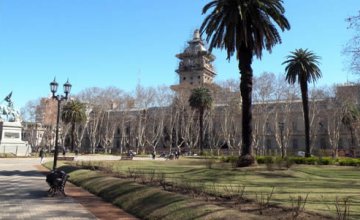
Rosario city tour
Located 320 kilometers from the Autonomous City of Buenos Aires, it discovers its beauty amidst the busy urban life.


Rosario’s Delicacies
Here we present our four selected tables in the city. Whether regional or ecumenical, whether strongly Argentinian or European, all of them, proudly from Rosario.
Travel agency and activities in Rosario

Rosario Golf Club

Pedraza Viajes y Turismo

Teatro Mateo Booz

Publitour Viajes
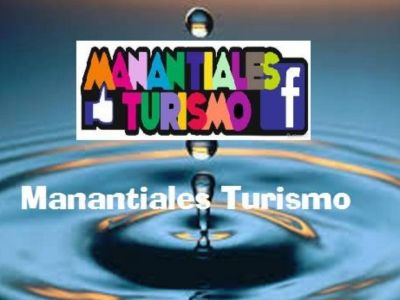
Viajes y Turismo Manantiales

Desde Rosario Turismo

Sam Travels & Markets SRL

View more tourist services
Hotels and accommodations in Rosario

Apart Hotel Los Tilos
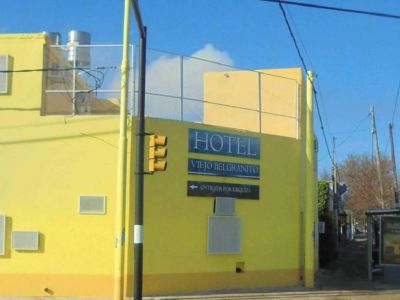
Viejo Belgranito
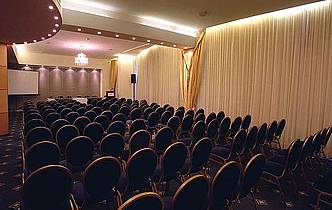
Plaza Real Suites Hotel
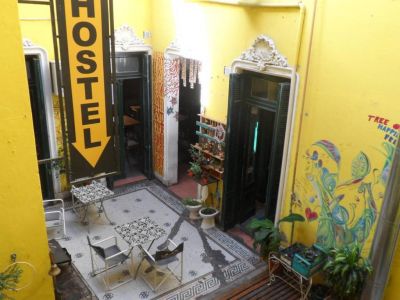
Freedom Hostel Rosario
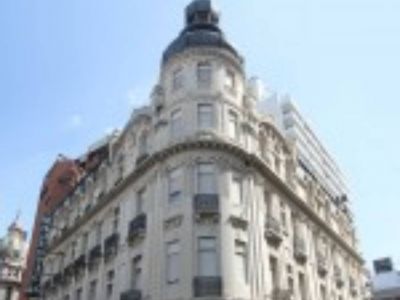
Majestic Rosario
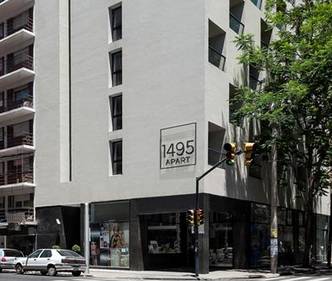
A.C.A. - Centro Turístico Timbúes
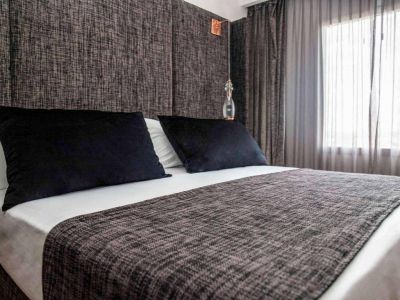
Mercure Hotel

View more lodging
Terminos y condiciones
- Travel blog
- North America
- United States
- South Carolina
- South America
London Bridge vs Tower Bridge – Travel Guide & Things to…
Etretat, france – a great place to visit, barcelona spain fourth most visited city in europe, notre dame an oldest cathedral in paris.

- Destinations
Things To Do In Rosario Argentina

The third largest city in Argentina , Rosario is not that far from Buenos Aires and provides plenty of things to do for visitors. The port city offers a wonderful combination of natural and man-made attractions that provide families with plenty to see and do during their stay. What follows are some of the more interesting places to visit in Rosario.
Che Guevara Statue
The controversial revolutionary leader Che Guevara was born in Rosario and you can see his birthplace along with his impressive statue. The building itself is a private apartment, so there is nothing to see inside, but the statue remains an impressive site which is honored by the community.

Explore the Parana River
The beautiful river located next to the city offers a great adventure if you plan to kayak or take a cruise. The river and the river delta offer many wondrous natural sights, including several islands that are home to birds and other wildlife. There are beaches for you to enjoy along the river bank, plus, you can take a motorboat tour to see the canals and rural life that makes this one of the more interesting places to visit.
Monumento a la Bandera
You can’t miss this stunning location in the center of the city. The monument is a tribute to the national flag of Argentina and provides a great place to start your tour. The wide-open space of the pavilion offers a stunning view of the city itself. Plus, there is also the eternal flame and large flag which add to the splendor of the area. The tower itself provides a great place to take photos and you can watch the flag-raising at 8:15 am each morning.
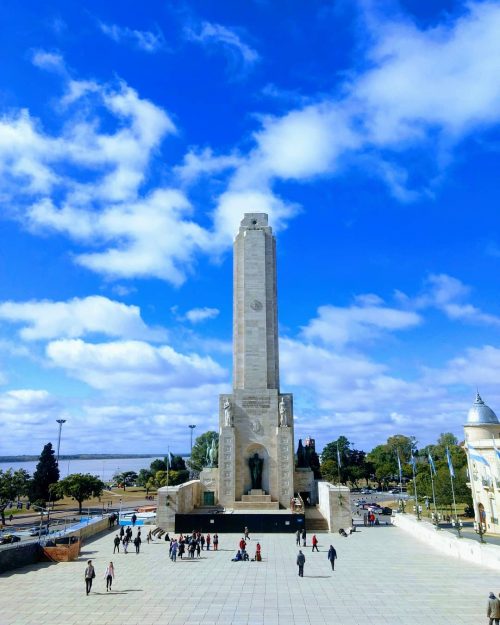
Museo de Arte Contemporaneo
You’ll find arguably the most important artwork in all of Argentina inside this remarkable museum. Called MACRO for short, this museum is located inside an old grain silo complex, each silo having its own color which makes it a remarkable site. A glass elevator takes you to the top and you can see the 10-stories of artwork, mostly provided by local artists, that make this museum a wonder to behold.
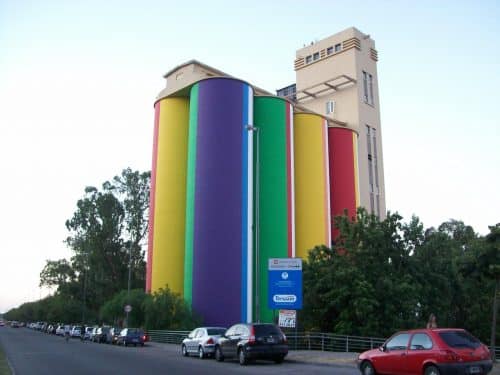
Parque Urquiza
The waterfront park is located not far from the Monumento a la Bandera and provides a great, natural scene where you can take a breath and prepare for your next adventure. This location offers good meals from the local vendors, a playground for the kids, and several bars and restaurants that you can take advantage of during the evening hours. Plus, there is an amphitheater which occasionally offer performances and an astronomical observatory.
You can also go to the Isla Espinillo, an island that offers horseback riding, water sports, and many other activities that make for a welcome change of scenery when staying in Rosario. The city itself is quite modern and fashionable, which means that it is a great place to visit, especially if you have already been to Buenos Aires and want to see more of the country. For tourists, Rosario offers a host of things to do that you and your family will enjoy.
RELATED ARTICLES MORE FROM AUTHOR
First day in the tiny town of minca, colombia, the guide to eating in colombia, the 5 best beaches in south america, leave a reply cancel reply.
Save my name, email, and website in this browser for the next time I comment.
This site uses Akismet to reduce spam. Learn how your comment data is processed .
Recent posts
World’s top tropical beaches, london bridge vs tower bridge – travel guide & things to do, random article, london bridge vs tower bridge – travel guide & things to..., editor picks, popular posts, taj mahal, india (agra) the symbol of love, amazon rainforest, feel the rainfall of leaves, popular category.
- North America 41
- United States 32
- Historical Places 23
- South America 17
- Privacy Policy
Things to do in Rio, during Carnival
What to do in the poblado area of medellin, colombia.

Photos from Rosario

Blogs from Rosario
Latest blog posts from rosario.
- Meet the Team
- Work with Us
- Czech Republic
- Netherlands
- Switzerland
- Scandinavia
- Philippines
- South Korea
- New Zealand
- South Africa
- Budget Travel
- Work & Travel
- The Broke Backpacker Manifesto
- Travel Resources
- How to Travel on $10/day
Home » South America » Argentina » Backpacking Guide
EPIC Backpacking Argentina Travel Guide (Updated 2024)
Dreaming about exploring the wilds of Argentina? Me too amigo, me too.
This is a land of contrasts: a place where scorching deserts and lush jungles melt into each other. Fine wine costs a couple of dollars – and fine people sip mate in the streets . It’s home to sacred landscapes of Patagonia, football, meat, empanadas, hikes of every difficulty level, and ridiculous levels of enthusiastic energy.
There are reasons why backpacking Argentina is so popular amongst us travellers. Adventures are extreme, the diversity of landscapes is incomprehensible, and the people are sexy – I mean – vivacious .
But, Argentina is ENORMOUS … So if you’re visiting Argentina for a flustered quickie or planning a complete road trip, you gotta be prepared.
I’ve been lucky enough to backpack around South America with my Argentinian partner too… So I’ve roped in Seba G Vivas: Argentina native and lifelong enthusiast. Together, we’re going to guide you through this magnificent country to show you the must-visits AND off-the-beaten-path highlights we’ve discovered in 25+ years of trips around Argentina.
This epic backpacking Argentina travel guide has the best budget tips and travel tricks, lovingly gathered over our lifetimes, in the most passionate nation in the world . From our favourite cheap accommodation, the low down on hikes, to the boring stuff like travel insurance and safety, you’re safe with us.
No country has left an impression on me quite like exploring Argentina. So I, LauraMcBlonde, and my beautiful Argentino partner are taking you on a wild road trip from the desert to trekking Patagonia.
Vamos! We’re going backpacking Argentina…
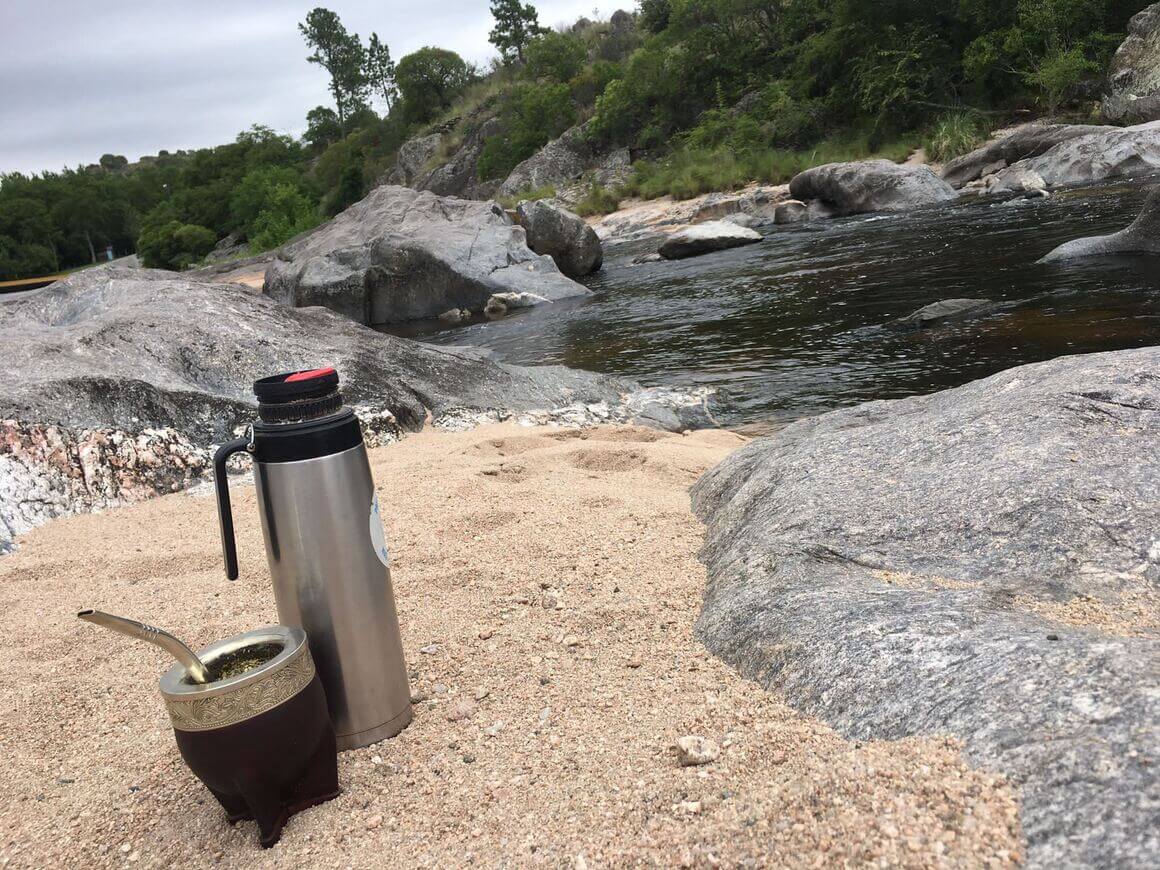
Why Go Backpacking in Argentina?
If you tried to describe Argentina with a couple of words, it wouldn’t be possible. The 8th largest country in the world hosts some of the most dramatic and distinct landscapes. So whatever type of backpacker you are, Argentina has something for you.
Snowy Patagonian mountains run alongside miniature mountain villages. Humid rainforests and dry deserts crash into each other. Then you’ll find highly developed cities.
The Southern South American country borders friendly neighbours like Brazil, Chile, and Bolivia. So it’s a no-brainer to make Argentina part of your backpacking South America adventure.
And amazingly, Argentina is cheap as shit! So it really is a broke backpacker’s dream destination. You just have to know the tricks.
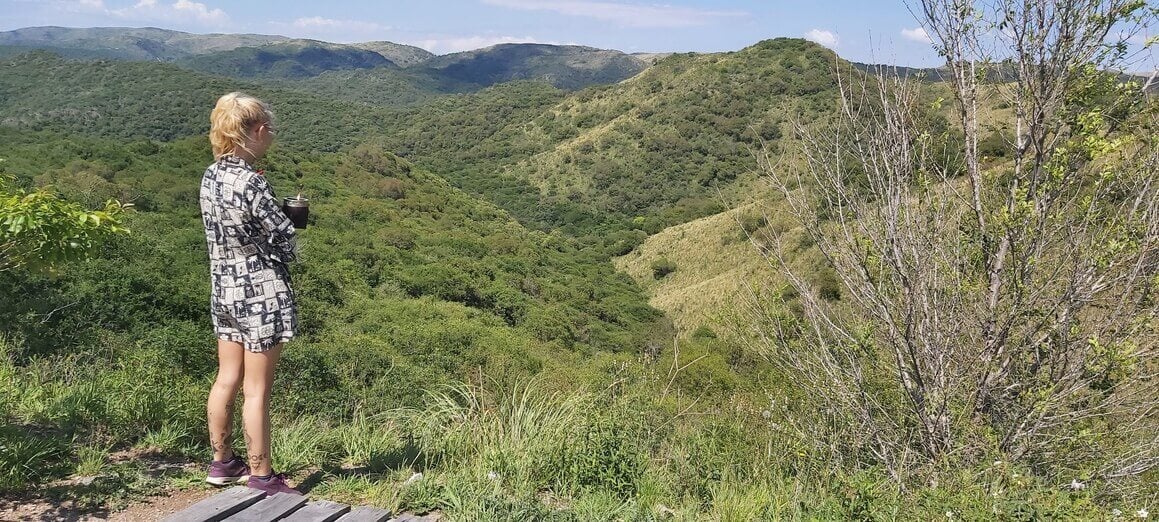
More than that, Argentina has a special place in my heart. The locals don’t do anything by halves and that passion transcends to everything in their beloved country. They LOVE and they HATE Argentina, in equal measure, passionately .
The energy that the people have is electric. Whether it’s a football game, a music concert or an Argentinian festival , people have a particular way of sharing emotions; those very high and very low vibrations.
Best Travel Itineraries for Backpacking Argentina
Best places to visit in argentina, 10 top things to do in argentina, backpacker accommodation in argentina, some unique experiences in argentina, argentina backpacking costs, best time to travel to argentina, staying safe in argentina, how to get into argentina, how to get around argentina, argentinian culture, working in argentina, faqs about backpacking in argentina, final advice before visiting argentina.
There are top things to do in Argentina all over the country. Even if you just keep your Argentina itinerary within places to stay in Buenos Aires , you’re in for an adventure. But once you get out of the capital, you see the country unfold.
Backpacking Argentina itineraries involve long travel distances ; bear this in mind when planning your trip. Flights are expensive and bus journeys are long .
If you’re only planning on visiting Argentina for 1 or 2 weeks – or even with a one-way ticket – it’s impossible to get around the whole country. Pinning a few must-see destinations may be useful.
14-Day Travel Itinerary for Argentina – The Northern Cities
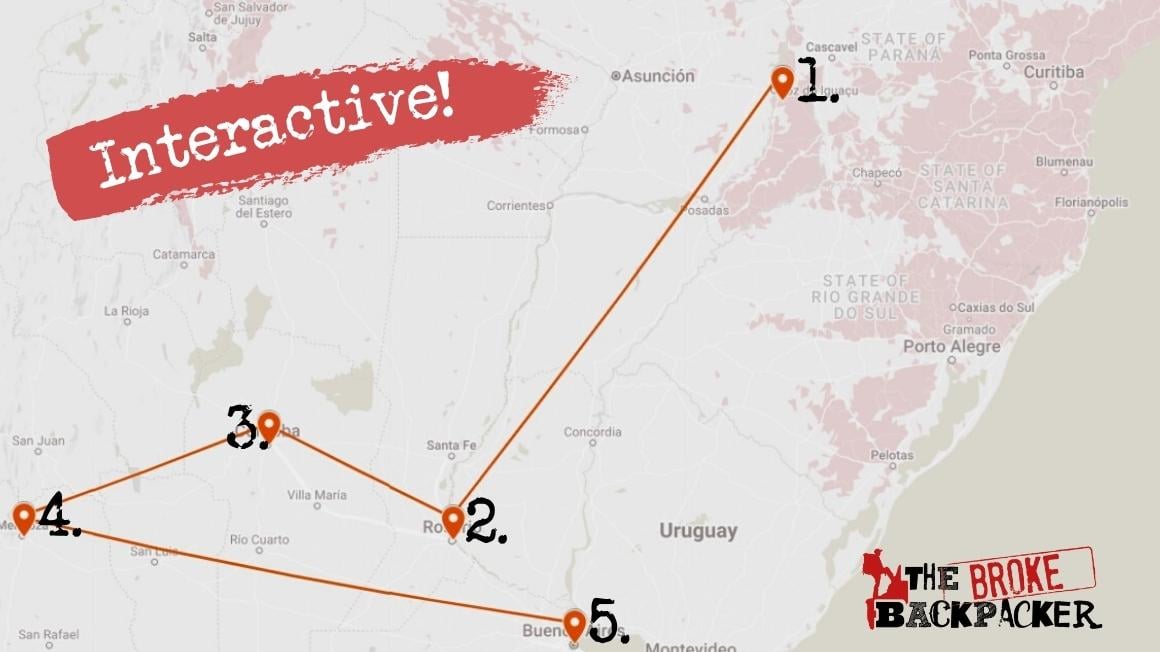
With 2 weeks in Argentina, you can cover the most culturally significant cities in Northern Argentina: Buenos Aires , Rosário , Córdoba , and Mendoza . This 14-day backpacking Argentina itinerary starts at the iconic Iguazú Falls and ends in Buenos Aires. But it can be done in reverse.
If you’re flying into and out of Buenos Aires , or you’re short on time, you may want to connect to Puerto Iguazú on a round-trip flight to avoid the long-distance bus.
To see the incredible example of the power of nature, spend 1 or 2 nights at Iguazú Falls . You can also see it from the Brazilian side, but I’m biased, right?
Take a bus ride to Rosário , one of the most progressive South American countries. Delight your senses with outstanding street art, culture, and playtime – I mean nightlife .
You won’t be disappointed by Córdoba : a city with very modern values. Stay in the city of Cordoba for a few days, then – if you can – get out and explore the region of Córdoba.
The Sierras de Córdoba is a mystical place to explore. Camping here is one of the biggest pleasures.
From here, the journey to the wine capital of Argentina, Mendoza , is easy. Go wine-hopping from vineyard to vineyard. The nearby Andes mountains also offer skiing, hiking, and climbing.
Then finally, Buenos Aires awaits you. This chaotic city has no shortage of attractions. Be sure to visit the charming neighbourhoods of Recoleta , San Telmo , and Palermo .
1-Month Travel Itinerary for Argentina – The Culture Route
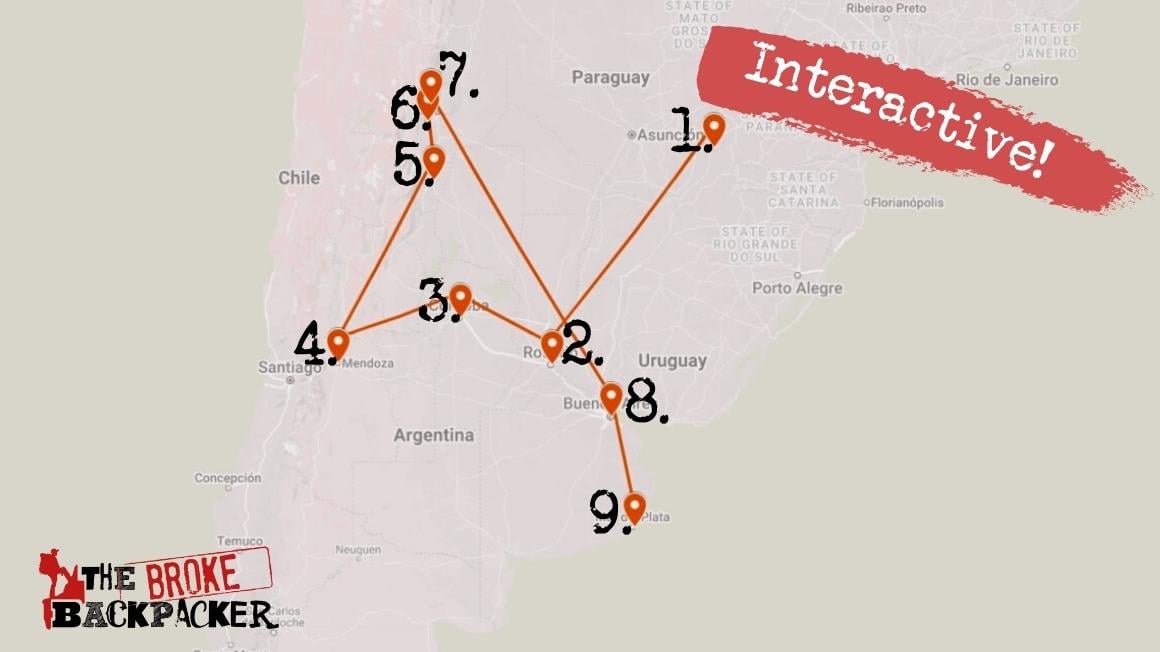
Now we’re really digging deep into what Argentina has to offer. This 4-week backpacking Argentina itinerary expands further on the previous 2-week itinerary but now you could have time for Salta and Jujuy . End your trip on the beach at Mar del Plata .
On your way North from Córdoba or Mendoza , you can make a stop in San Miguel de Tucumán to break up a long bus journey. Dive into some of the nation’s history at the Casa Histórica and the Casa de Gobierno .
You’ll notice the landscape become arider and desert-like until the scenery crescendos into surreal formations and colours. From here on out, simply looking out the window at the alien-like views is entertainment enough.
As well as being one hell of a wine region, Salta has an extraordinary landscape of rock formations. Set a few days aside for getting lost within it.
Then, you’re the most North West as Argentina goes in the state of Jujuy . Tred through raw Argentina. Enjoy the traditional life with a backdrop of natural wonders: Quebrada de Humahuaca and the Pucará de Tilcara .
If you’re heading out of Buenos Aires, Mar del Plata is the best place to wind down or party on down. Whatever kind of beach vibe you crave, you’ll find it here.
3-Month Travel Itinerary for Argentina – The Whole Cow
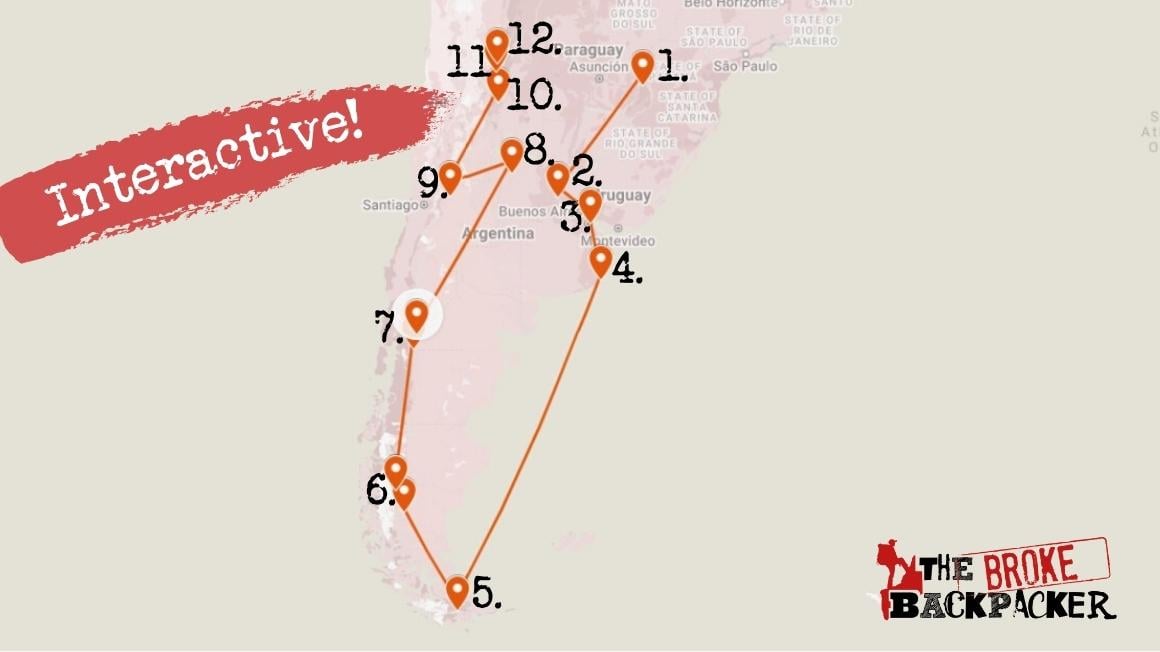
Now, this is my kinda trip! With a 3-month backpacking Argentina itinerary, you can delve deep into the heart of this special nation.
You’ll be able to experience nearly every shade of its coloured and marvellous geography: mountains, deserts, coastlines, vineyards… well, as much as 3 months allows. As well as having the previous destinations on your hit list, now you have plenty of time to explore Patagonia too!
Don’t miss some of the best places to see in Argentina: El Bolsón , Bariloche , El Chaltén , and El Calafate . You may well find that you just don’t want to leave!
It wouldn’t be a justified backpacking Argentina travel guide if I didn’t recommend that you take at least one trek. You have plenty of the best hikes in the world to choose from: the mighty Fitz Roy and Cerro Torre , climbing atop the Perito Moreno Glacier , or at the ends of the Earth in Tierra del Fuego in Ushuaia.
On this trip through Argentina, You’ll also have plenty of time to simply soak in the energy that the country gives off. Take the days (and nights) to enjoy fine food, wine, and fine company. By travelling slowly , that’s when you get the full Argentina experience.

A new country, a new contract, a new piece of plastic – booooring. Instead, buy an eSIM!
An eSIM works just like an app: you buy it, you download it, and BOOM! You’re connected the minute you land. It’s that easy.
Is your phone eSIM ready? Read about how e-Sims work or click below to see one of the top eSIM providers on the market and ditch the plastic .
Of course, this massive country is jam-packed with incredible sights. You can make a list as long as your arm of the best places to visit in Argentina. But let’s go over some highlights.
Backpacking Buenos Aires
Buenos Aires is a city unique in itself. You could spend weeks, months, YEARS here and still feel like a newbie.
It’s a marvel. The city’s full of energy, wonderfully designed, and there is rarely a dull moment. To start backpacking Argentina, Buenos Aires is an exciting place to springboard in.
The city is huge, and most people question safety in Buenos Aires from terrible rumours. But staying in the Microcentro (where most of the attractions are anyway) proves safe enough for thousands of tourists a year.
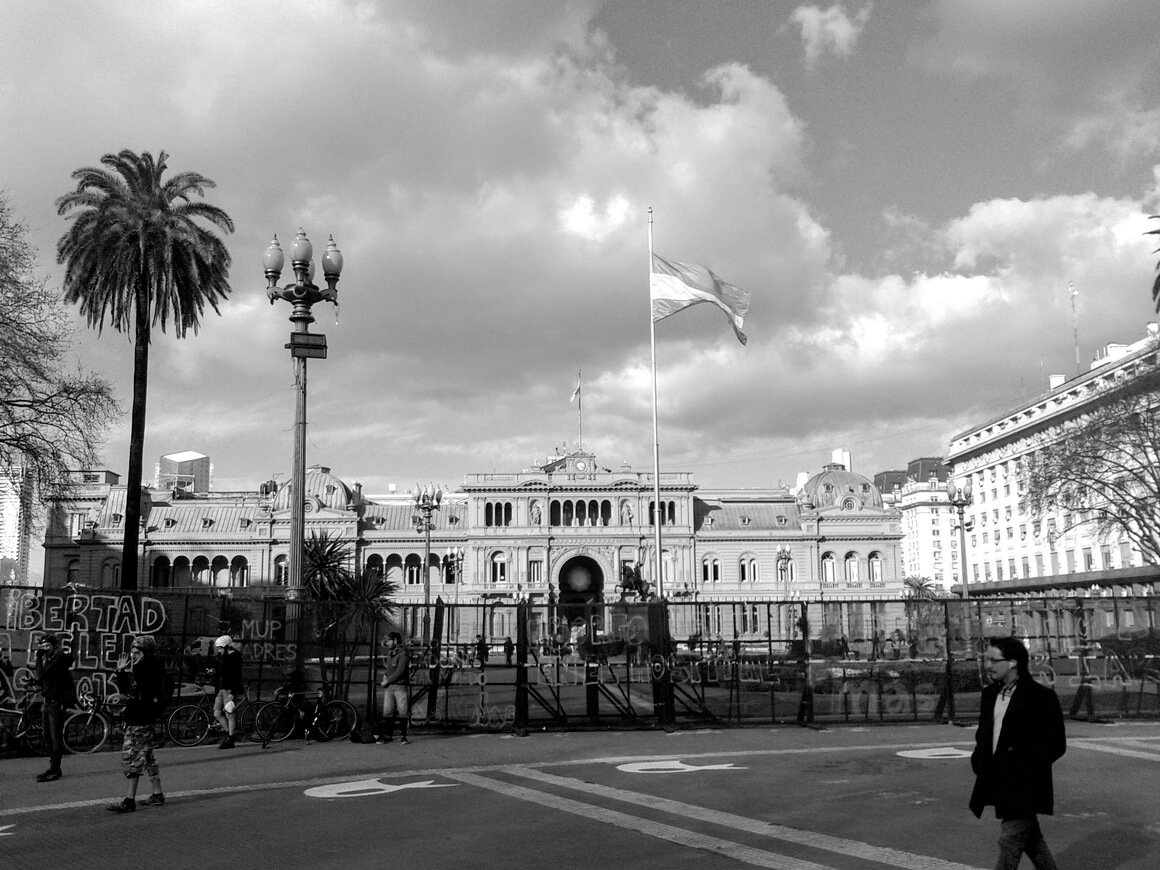
You’ll find Obelisco rising in the middle of the bustling Avenida 9 de Julio to remind you where you are. Several cultural landmarks, like the Casa Rosada and Palacio Barolo , are around this area.
Living the hostel life in Buenos Aires, you’ll meet great people. It’s the place for tip-offs about THE local snack shops too.
Recoleta is class but attracts mostly affluent travellers – the cemetery is weirdly amazing. Palermo SoHo is the hipster part of town and features some of the coolest street art I have ever seen.
La Boca is admittedly cool but overhyped and a bit shady after dark. I recommend staying in San Telmo instead, and just peaking in as a better option.

Backpacking Iguazú Falls
Iguazú Falls is probably the most engrossing waterfall on the planet (and I’ve seen a few stunning waterfalls). The sheer power of this waterfall makes it an intimidating and awe-inspiring sight. Around 275 cascades orchestrate this majestic power.
As you walk along the crest of the falls, witnessing tons of water spilling over the precipitous edge, you’re gonna get wet. (You dirty-minded bastard – not that kind.)
Iguazú Falls is split between Brazil and Argentina and both sides will give you a different taste. The Argentinian side traverses the top of the falls and gives a more up-close and personal experience. The Brazilian side is closer to the bottom of the falls but makes a fuller panoramic view.
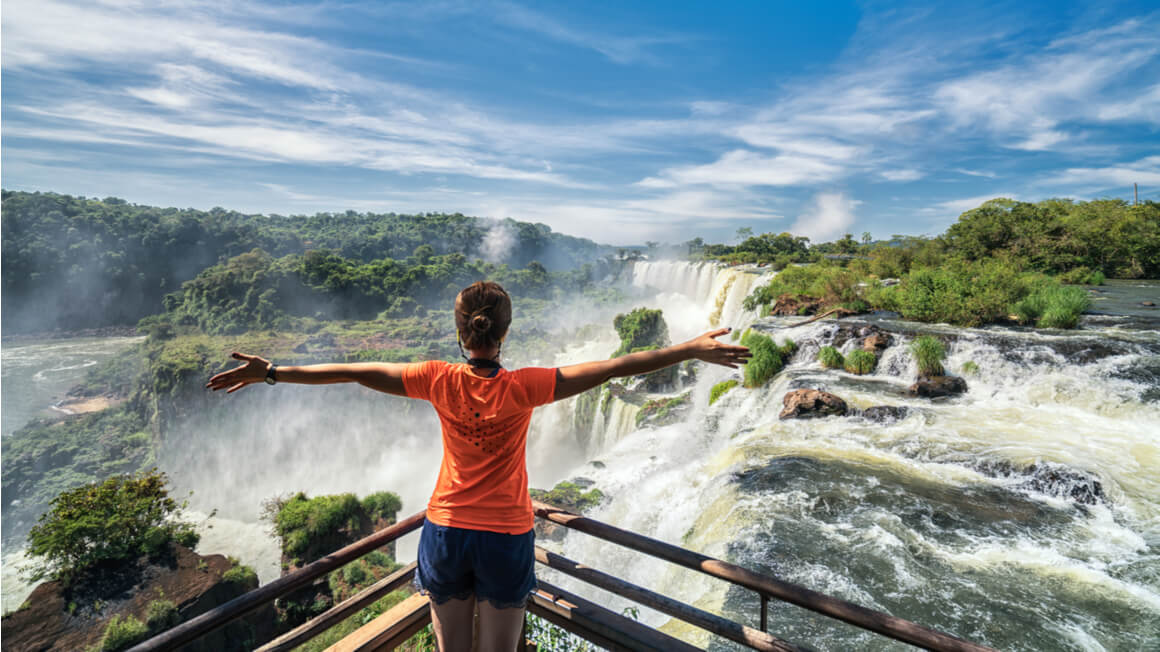
The most magnificent sight is the Garganta del Diablo – The Devil’s Throat . Many people (*cough, cough* the Argentinians) claim it is the best part of the park.
There’s an argument over which side is better: Brazil or Argentina? But this is a backpacking Argentina guide… Of course, I’m going to say Argentina!
Accommodation wise: stay in the Argentinian city of Puerto Iguazú . The city pretty much exists solely as a means to visit the falls. Staying in one of the hostels in Iguazu Falls is where you’ll find the best vibes.
Backpacking Rosário
Rosário doesn’t have the sheer amount of landmarks that Buenos Aires does. What Rosário does have is heaps of culture. Here is one of the most liberally minded and socialist populations in all of South America.
The city is evolving and transforming. Artists, activists, rebels, and youngsters are all drawn to this place to pay homage to idols – like Che Guevara, Lionel Messi – or to become their own (in a sense).
The most important landmarks are the Monumento a la Bandera and the house of El Che Guevara . Both are nationalistic in nature and iconic stops in the city.
Rosário is also the city with the most green spaces in the whole of South America! Check out the Parque Independencia , which is also one of the largest city parks in the whole country. If you’re visiting during warmer seasons, there’s even a stretch of sandy beach along the Paraná River called Balneario La Florida to take your icy beer.
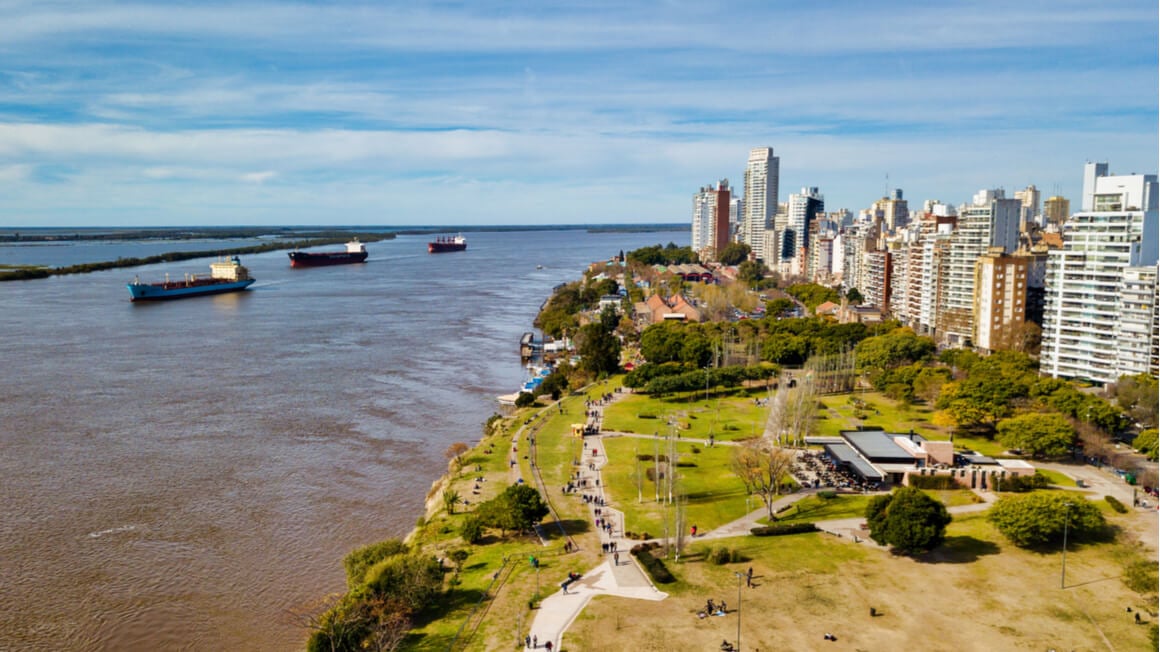
Tourist attractions aside, Rosário really shines when it comes to the people. People are very open-minded and receptive to foreigners. If you happen to make friends with a Rosárino (a person from Rosário), then you’ll be treated very well – first to an Asado , then to a long night of socials in the Pichincha neighbourhood.
If you’re lucky, you may even get a chance to find a lover for the night. It’s common knowledge that Rosárinos are gorgeous.
Backpacking Mar del Plata
Mar del Plata is every Porteño’s (a person from Buenos Aires) favourite summer getaway. This large city boasts some of the best beaches in Argentina and gets rammed in the peak seasons around November to March.
Most people, obviously, journey to Mar del Plata to relax on the beach. The most popular ones are Playa Varese , Playa de los Ingleses , and Playa Grande .
In the summer, these sandy stretches become absolutely bonkers as locals play and pass around drinks and joints. At night, many people go to the bars around Alem Street and stay up all night long only to repeat the process the following day.
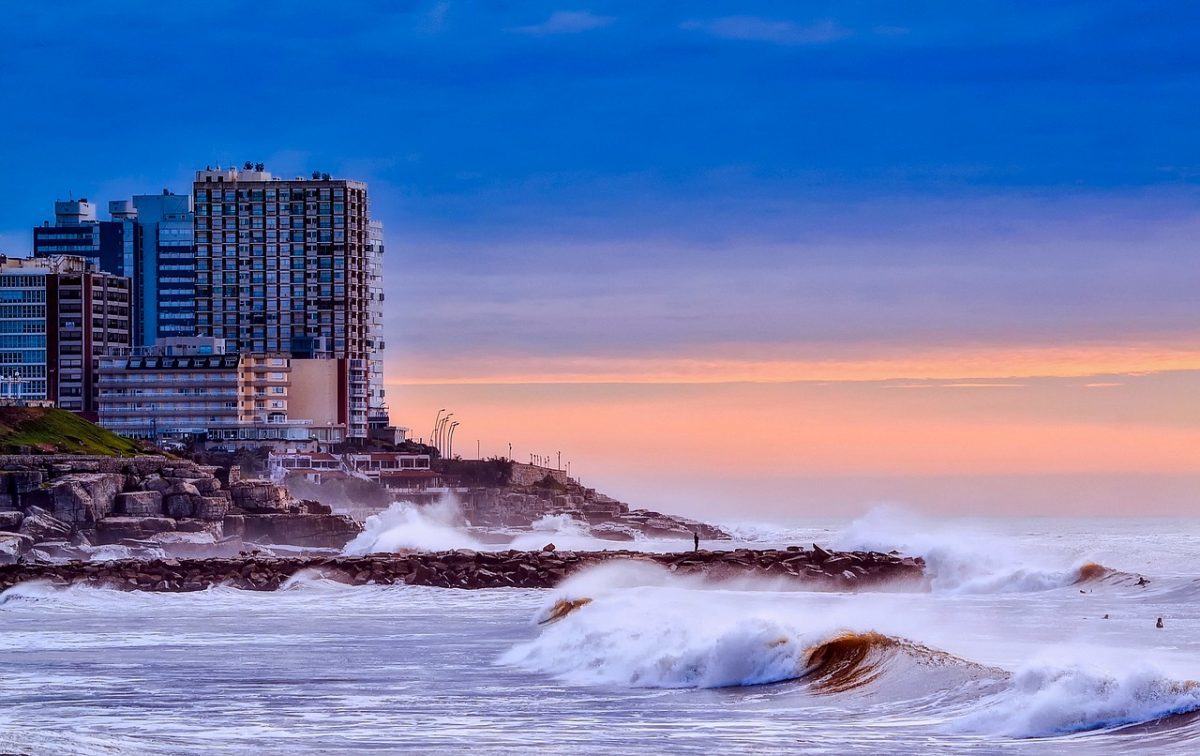
If you want a slightly calmer experience then head north or south to the small coastal towns of Pinamar and Miramar , respectively. Both are way more chilled and attract more families. You’ll find much cheaper accommodation in these areas too.
If you visit Mar del Plata during the rainy off-season, then there is still plenty to do. There are several ecological museums and zoological facilities around the city to visit. Most of these offer predominantly maritime exhibits.
Backpacking Córdoba
Córdoba is the second-largest city in Argentina and is most known for its colonial architecture, scholastic history, and surrounding mountainous landscape. The city is an eclectic mix of the old and the modern. Young travellers and students rain on this city.
Jesuits “founded” the modern city of Córdoba and they established several places of learning. Because of this, Córdoba’s nickname is La Docta or “the learned one.” Scattered throughout are some of Argentina’s prominent historical sites: the Manzana de los Juristas , the Cathedral of Córdoba , and the Capuchin Church .
Go museum crazy in Córdoba. The Evita Fine Arts Museum , which was formerly a palace, is loved by many. Ultra-modern Caraffa Fine Arts Museum is also worth visiting. Backpacker hostels in Cordoba and cool budget accommodation are in abundance.
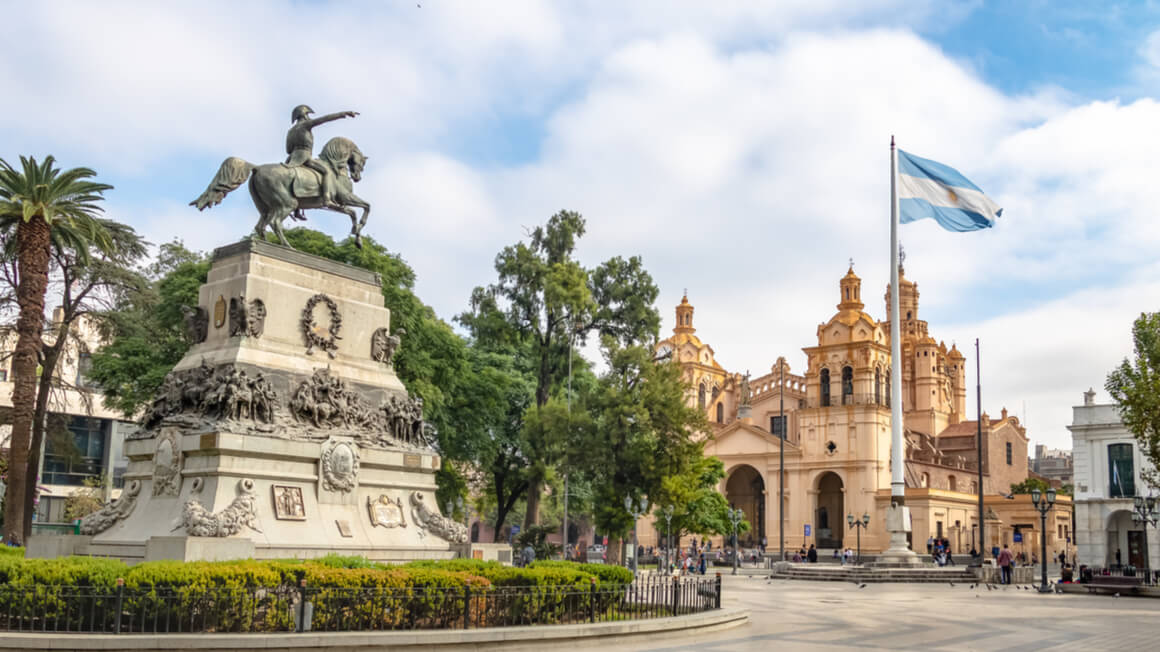
Outside of the city of Córdoba is my favourite place in Argentina – Las Sierras de Córdoba (sorry Paraná, I still love you). I’m just a sucker for camping and road trips.
Charming villages around the mountains, like La Falda , La Cumbrecita , and Villa General Belgrano , are beautiful and have very European sensibilities. The Quebrada del Condorito and Traslasierra Valley areas make incredible hikes.
Argentinians from all over the country flock here with their Asado equipment to retreat from everyday life. Large inland lakes and rivers capture the hearts of many. Picturesque Mar Chiquita serves as a nice retreat for Córdobians.
Nearby Salinas Grande couldn’t be more different. This is a huge salt flat at the base of the mountains.
Backpacking Salta
Salta is a thriving commune and backpacker hangout smack bang in the middle of the desert. This desert also doubles as one of Argentina’s premier wine regions (woohoo!).
I’m not going to beat around the bush here; it’s a journey to get here. You can make a stop in San Miguel de Tucumán – for some history – and Cafayate . Cafayate is the initial gateway to one of the most gorgeous landscapes in Northern Argentina: the Valles Calchaquí .
If you have your own car, you’re laughing. This region – running north all the way to Jujuy – makes the best road trip with its blood-red stone formations canyons that snake throughout it. Cuesta del Obispo is a road I won’t forget in a hurry.
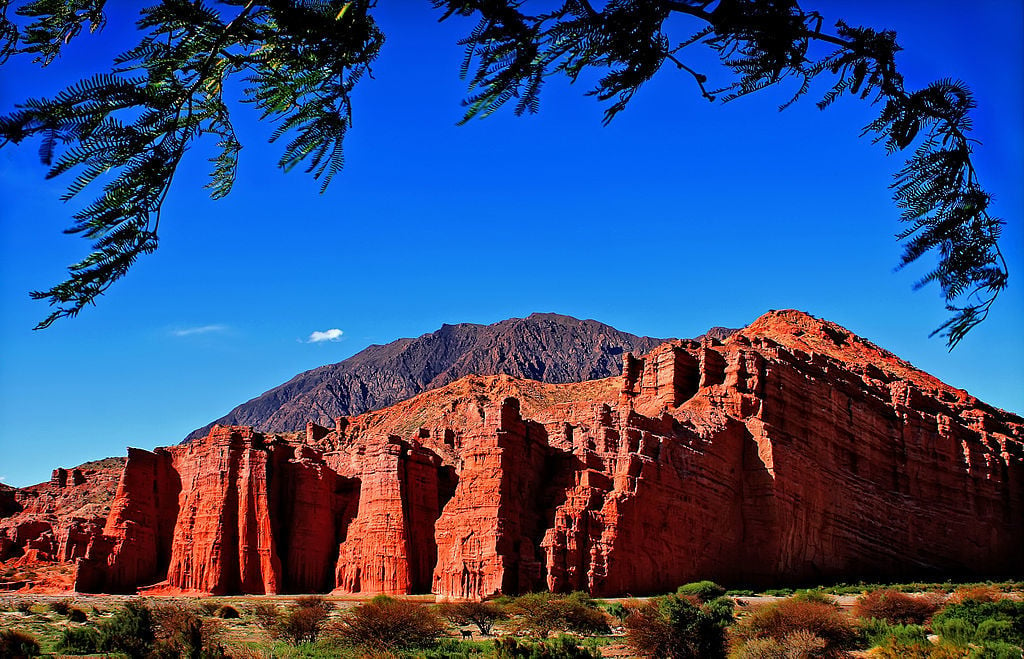
In the Valles Calchaquí, adventure opportunities are plentiful. Who knew backpacking Argentina in Salta can involve paragliding, mountain biking, climbing, rafting, rappelling? Pump some adrenaline, then warm your soul with some winey goodness.
There are numerous wineries around Salta offering different styles and vintages. The harsh climate in this region has a noticeable effect on the grapes, producing bold and hearty tastes.
Inside the city – if religious sights interest you – there are plenty. The gorgeous Iglesia San Francisco and Catedral de Salta , as well as museums of colonialism and archaeology, are prominent features. You can summit several of the surrounding hills via train or cable car as well; each one offers astounding panoramas of the city.
Salta definitely still has a soul and heartbeat that could rival any larger city too. Streets are busier with people more so than cars. Bars are abundant and full of life.
Backpacking Jujuy
North of Salta is San Salvador de Jujuy in the province of Jujuy. Though the regions of Salta and Jujuy appear very similar, they are, in fact, quite different.
Tourism in the region of Jujuy focuses less on winemaking and more on the surrounding landscape. The Quebrada de Humahuaca is one of the most beautiful places in Argentina and hiking through its Seven-Coloured Hills is a once in a lifetime opportunity.
This region isn’t totally desolate either: just over the mountains, you’ll actually find a cloud rainforest. Verdant Calilegua National Park will grant visitors the opportunity to spot jungle wildlife – especially those of the feline variety like jaguar, puma, and ocelot.
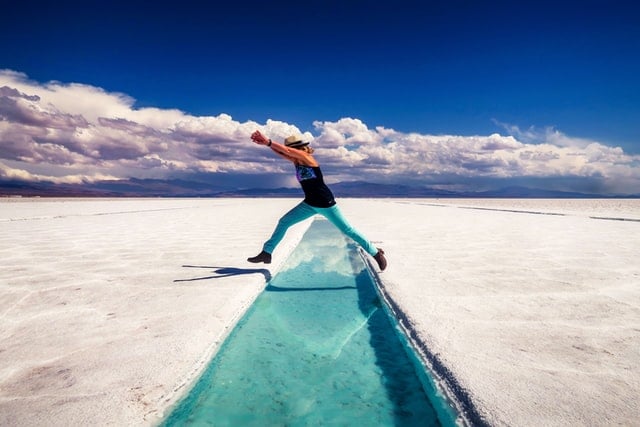
The main towns of the Jujuy province are San Salvador de Jujuy, Purmamarca , and Tilcara . All of them are quite similar and any one of these would make a fine base for exploring the region.
Of the three, Tilcara is the northernmost town and offers great archaeological attractions. The most popular site is the Pucara , which is a mighty pre-Inca fortification built upon a hill.
In addition, there are several other museums around Tilcara that do a great job of representing the local indigenous culture. The town itself has its own unique charm with mud and stone buildings, which give the entire town a very mystical desert feel.
Backpacking Mendoza
The mighty Andes! Here, you’ll find some of the superlatives of South America including the highest mountain on the continent. Home to the Malbec wine grape – “the best in the world”. (According to the Argentinos, obviously).
The city of Mendoza isn’t much to speak of. It’s a bit lacklustre. There are a couple of interesting attractions like the Cerro de la Gloria , Plaza España , and the Parque San Martín .
Most of the action is found outside of the city. This is why you want to make sure to know where to stay in Mendoza .
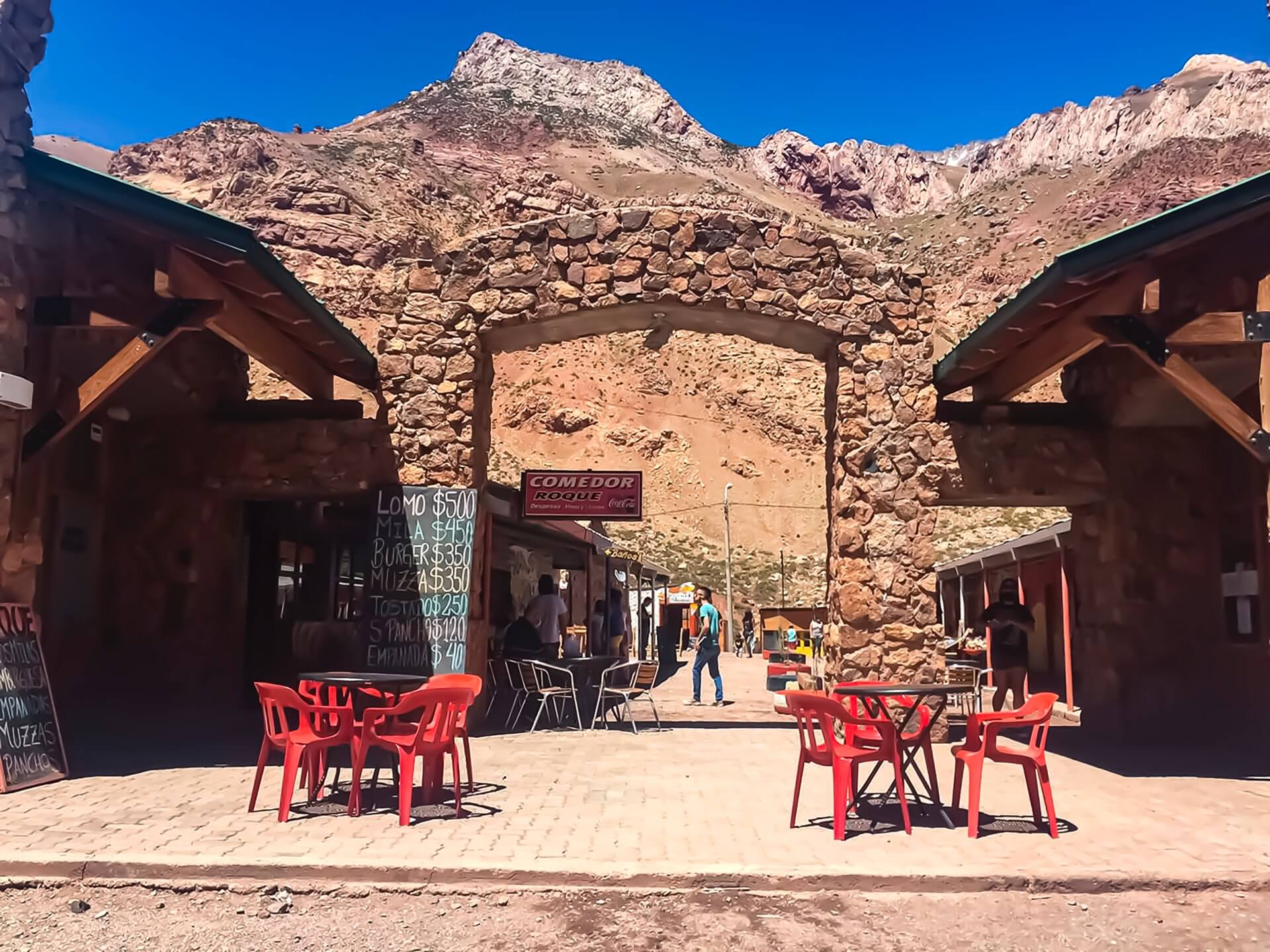
Being so close to the Andes, Mendoza has a myriad of alpine activities to participate in. In the winter, you can take to the mountains with your skis in resorts like Las Leñas .
In the summer, hardy adventurers can climb the gargantuan Aconcagua . This mountain is not for beginners though; attempting it shouldn’t be taken lightly. There are a couple of nice hostels in Mendoza as well.
The Wine Region is Mendoza’s real claim to fame. Don’t forget the name, Malbec : adored by many worldwide, this beauty of a grape is cultivated and celebrated here. A tour around the many wineries is essential in Mendoza.
Mendoza does act as a bit of a crossroads. Many who have been backpacking around Chile enter Argentina via Mendoza. The city is the meeting point for many important backpacking routes in Argentina as well.
If you’re travelling from the east, be sure and drop by the Argentinian national parks of Talampaya and/or Sierra de las Quijadas . Both offer spectacular desert scenery that rivals the beauty found in the Valles Calchaquí region.
Backpacking Río Negro
Okay, this is a biggie! So let’s break it down into two of the hottest destinations to visit while travelling in Argentina.
On the doorstep of Patagonia and the Andes are the beloved destinations of Bariloche and El Bolsón . I’m not messing, these are surreal fairytale places. There’s no wonder why people flock here.
Bariloche is Argentina’s idea of an Alpine retreat. This magical village nestles within the Nahuel Huapi National Park and has mountain splendour aplenty. With so much on offer, choosing the right place to stay in Bariloche can totally change your experience.
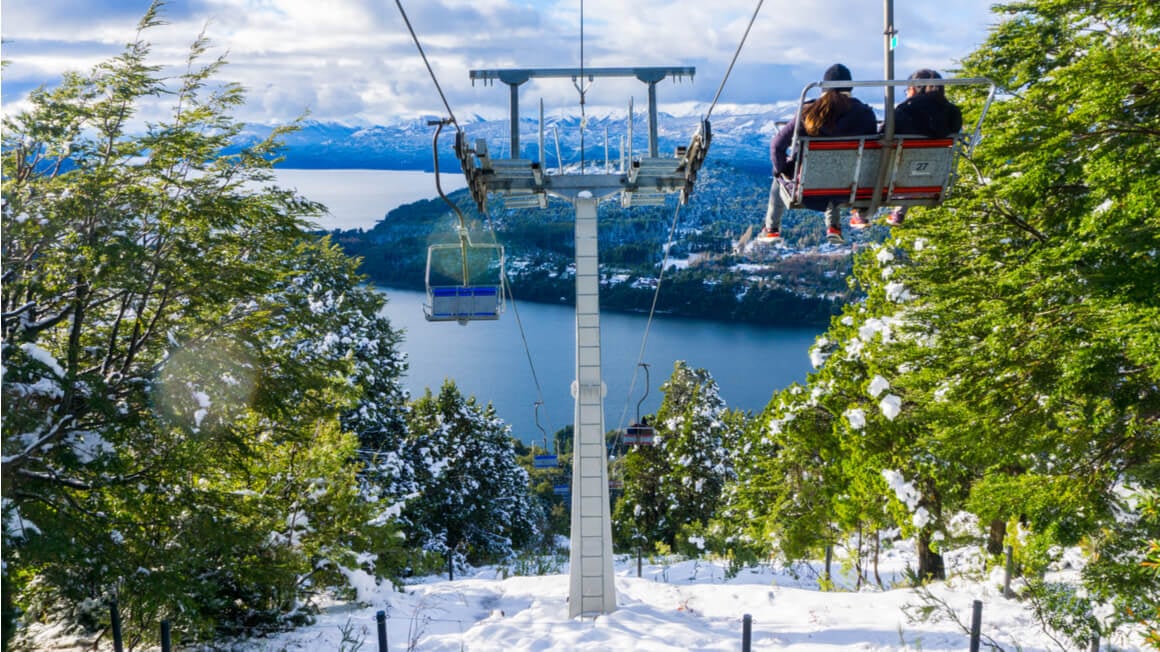
And within this magic-looking land, there is an abundance of outdoorsy adventures. There’s no shortage of world-class mountain activities to slap on your Argentina Itinerary:
- Paragliding
- Snowshoeing
- And more…
Here is South America’s largest ski resort – Cerro Catedral . The younger folk arrive by the busload and spend the nights partying hard too. Staying in a good hostel in Bariloche is where you’ll find the best vibes – and the best routes to the bars.
In the summer, after the snow melts, trekking is super popular. Take advantage of the mountain refuges for the most mind-boggling views. Climbing to Refugio Frey was my favourite!
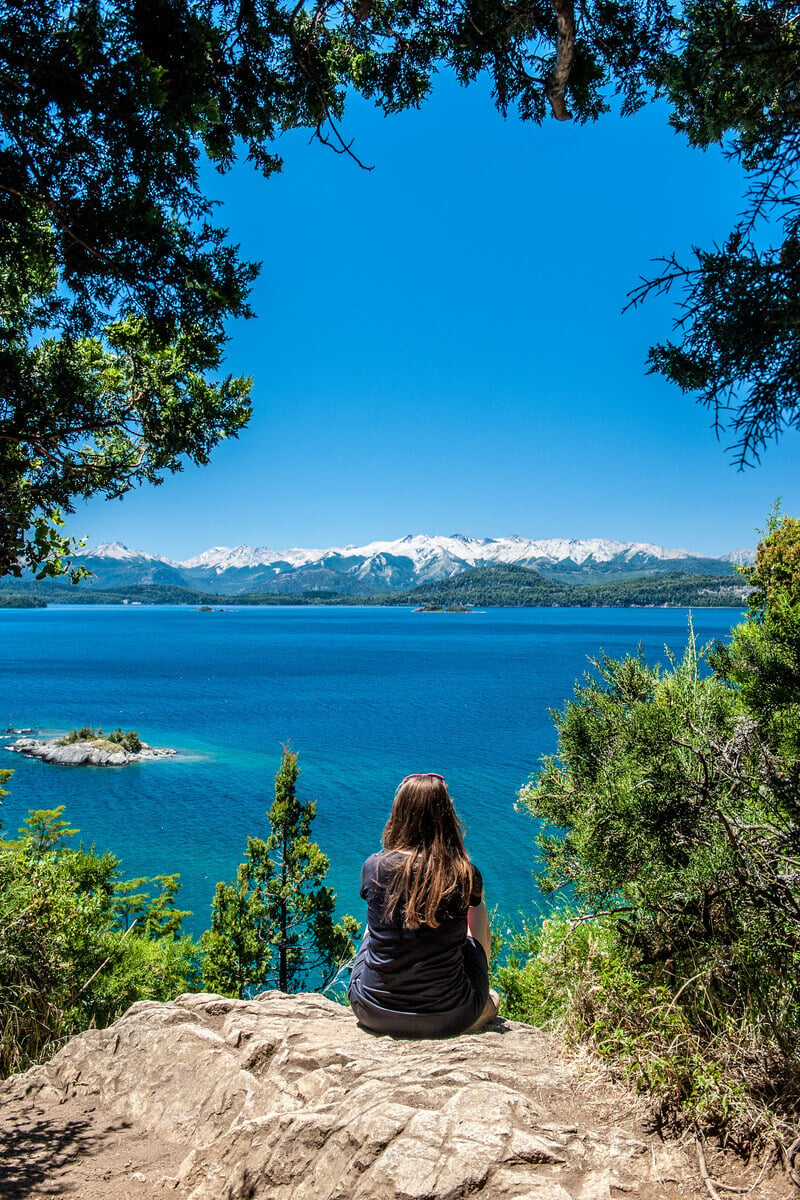
Nahuel Huapi National Park is insane year-round. Don’t miss the opportunity to venture to the lakes and islands and absorb the flora and fauna.
6 hours south of Bariloche is El Bolsón. Tucked away in the secluded Piltriquitron Mountains, people come to escape the stresses of modern living.
El Bolsón boasts some of the highest quality food in Argentina. You could spend your entire trip exploring the organic farmer’s markets and it wouldn’t be a minute wasted. Go ahead and double your body weight in ice cream.
The idyllic conditions mean breweries are overflowing in El Bolsón and brewmasters are getting damn creative. Honestly, I had the most delicious beer here, it made Germany look weak. (Sorry scary Germans, please don’t fight me.)
And, of course, take a day or more to hike around Cerro Piltriquitrón, El Cajón Azul , or Rio Azul .
Backpacking Patagonia
Finally, backpacking Patagonia! Let me tell you about some of my favourite stops: Perito Moreno, El Chaltén, and El Calafate .
Perito Moreno (not to be confused with the Perito Moreno Glacier which is 400 miles south) is not the most adrenaline-pumping place. It’s the location that really sells it.
Positioned halfway between El Bolsón and El Chaltén, it’s perfect to break up a bloody long bus journey. It’s also ideal to cross the border with Chile.
Check out the Cueva de las Manos : a UNESCO site of prehistoric painted hands and depictions of local wildlife, upwards of 13,000 years old! Personally, I thought it was super cool.
El Chaltén is the heart of Patagonia! Its close proximity to Los Glaciares National Park makes it an unmissable stop.
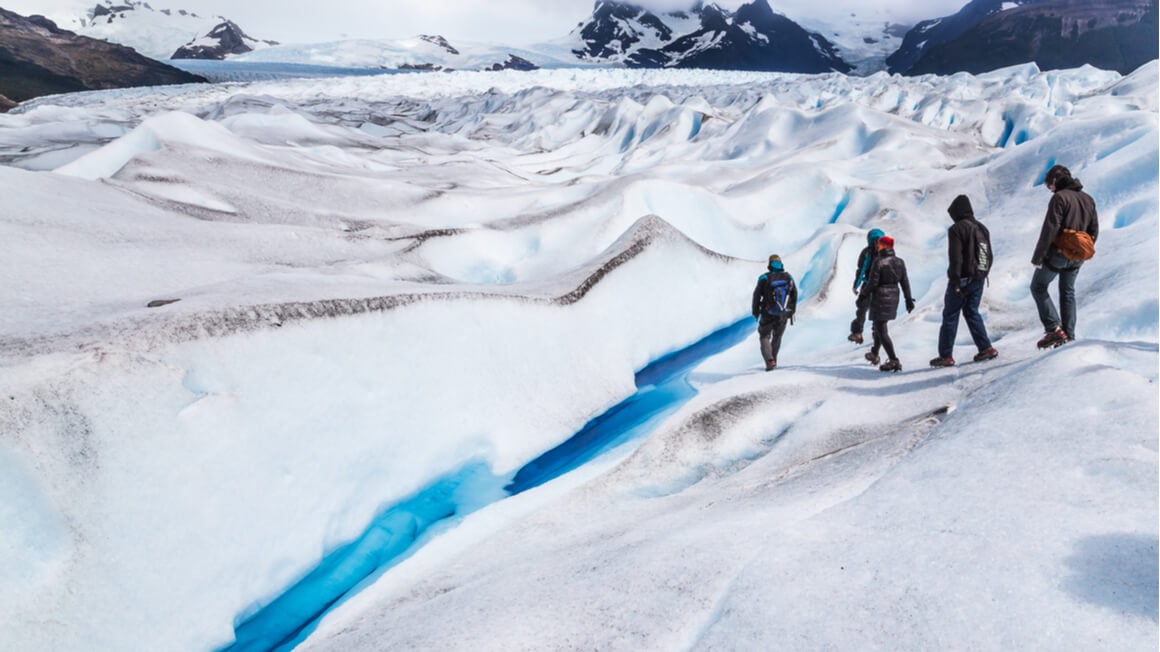
The region’s most notable peaks – Fitz Roy and Cerro Torre – tower in the distance and attract hikers and climbers year-round seeking to brave the malicious conditions. You have a plethora of world-class trails in El Chaltén to hike.
Traversing the epic Patagonian Ice Field is something you won’t forget for the rest of your life. Though this is NOT for novices; those who embark on this trek must be ultra-prepared. There’s no doubt you will feel on top of the world if you make it, though.
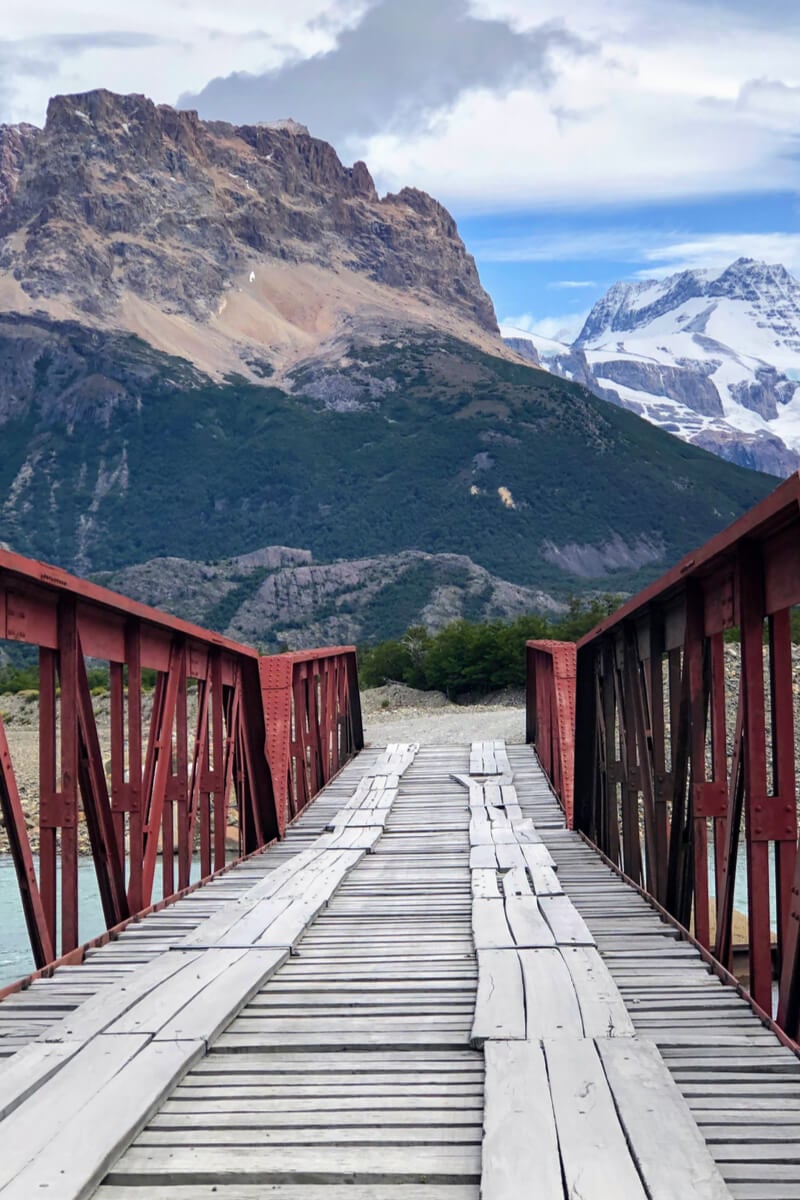
A few hours drive from El Chaltén is El Calafate : the jumping-off point to see the mighty Perito Moreno Glacier . It’s actually 50 miles away from El Calafate but – in Argentina terms – this is “close”.
If you’re kitted out you can walk across the glacier. It’s easily one of the most beautiful things I’ve ever seen. The Perito Moreno Glacier strikes an indescribable cobalt blue that gives you the chills – inside and out. End your expedition with the most satisfying beer you’ve ever drank.
If you’re a museum nerd (like me) the Glaciarium is the place to learn about the big-ass ice block. Inside the ice bar, you can grab a fernet and coke (a love or hate it kinda alcoholic drink).
A little more off the beaten track are the periphery Glaciares, Upsala and Speazzini .
Getting Off the Beaten Path Travel in Argentina
Even within the most heavily touristed regions, like Buenos Aires or Patagonia, there are areas that visitors rarely see. So travelling off the beaten path while backpacking Argentina is easy . There are endless places to stop and watch the world go by.
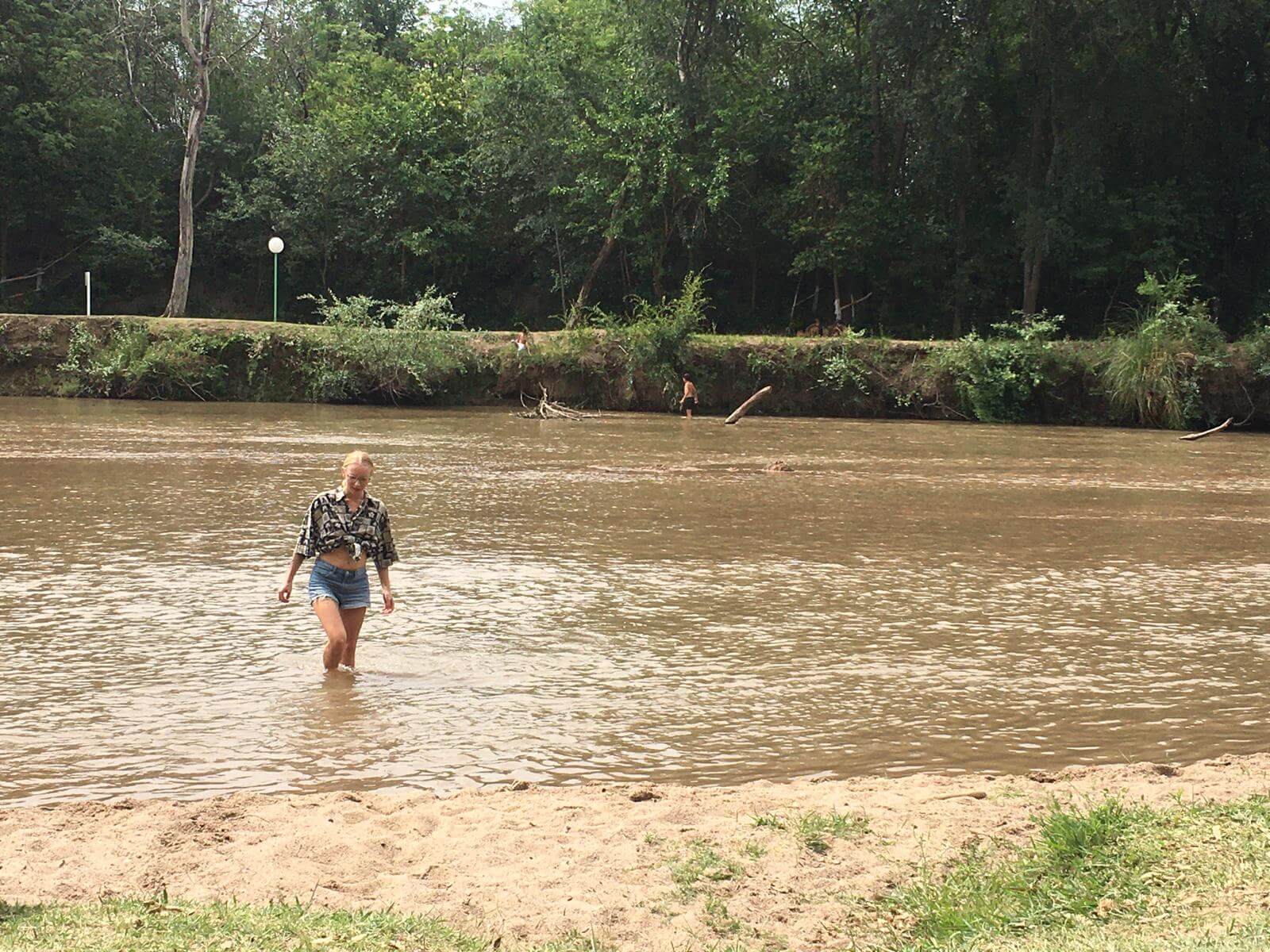
There are plenty of places to see incredible wildlife, flora, and fauna in Argentina. Though this is the part where I’m going to tell you to be very mindful if you’re taking part in animal tourism .
Puerto Madryn will satisfy your beach cravings. It’s also a place to spot whales, dolphins, sea lions, and penguins.
In the northeast, the swampy region of Iberá Wetlands is Argentina’s most ecologically diverse location. It’s overflowing with phenomenal natural sights.
Peninsula Valdes is a place of extreme marine diversity. Scientists compare it to Ecuador’s Galapagos Islands. Capybara, giant anteaters, howler monkeys, anacondas, marsh deer, caimans, and more, all call this place home.
Not many people make it to Ushuaia – Tierra del Fuego. Mostly because it’s damn far and expensive to get to. But if you make it to the Land of Fire , get ready for some of the best hikes in the world . Explore Tierra del Fuego National Park and scale the Martial Glacier .
Ushuaia is the best launching point to take a trip to Antarctica too. Though be warned: they are ridiculously expensive.
I had some of the best nights of my life just bouncing around the hometowns of the locals in places like Paraná and Santa Fe ; share mate , indulge in empanadas, and try every kind of beer.

We’ve tested countless backpacks over the years, but there’s one that has always been the best and remains the best buy for adventurers: the broke backpacker-approved Osprey Aether and Ariel series.
Want more deetz on why these packs are so damn perfect? Then read our comprehensive review for the inside scoop!
Of course, you’re going to find great things to do in Buenos Aires . But backpacking Argentina is much more than the capital city.
So get out there and create your unique Argentina itinerary!
1. Go to an Asado
The most cultural Argentino experience is the Asado . The gathering is centred around slabs of meat, cooked to perfection, on a type of grill called a parrilla .
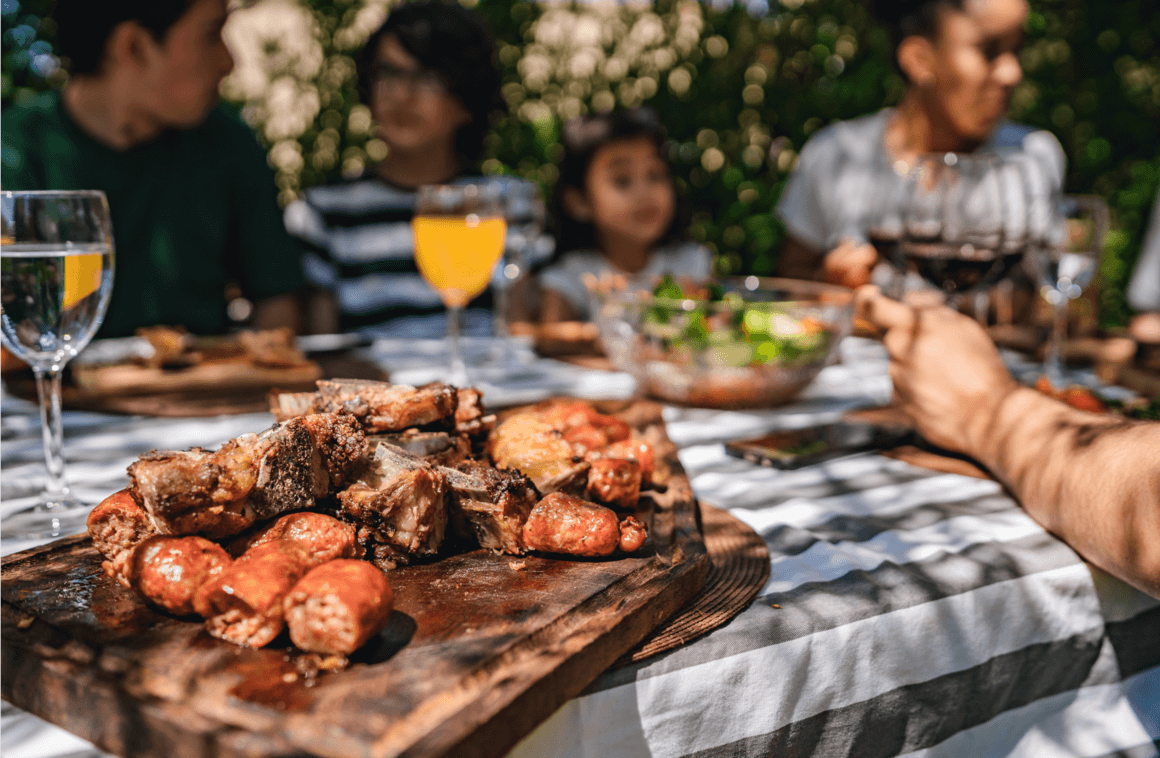
But Asado is not just about the food: it’s more about the company. It’s a very social experience and definitive of who Argentinians are.
Plus, dessert usually involves dulce de leche. That alone is worth selling your soul for.
2. Join the insanity of a football match
I’m from the UK – and I thought we were football crazy – until I went to Argentina. If you love football, this is basically a pilgrimage. If you don’t like football, you’re still in for a hell of an experience.
Players are idolized, deified even – as is the case with Diego Maradona and Lionel Messi – by the masses. Get yourself to a match and prepare for the most energy you’ve ever seen in your life.
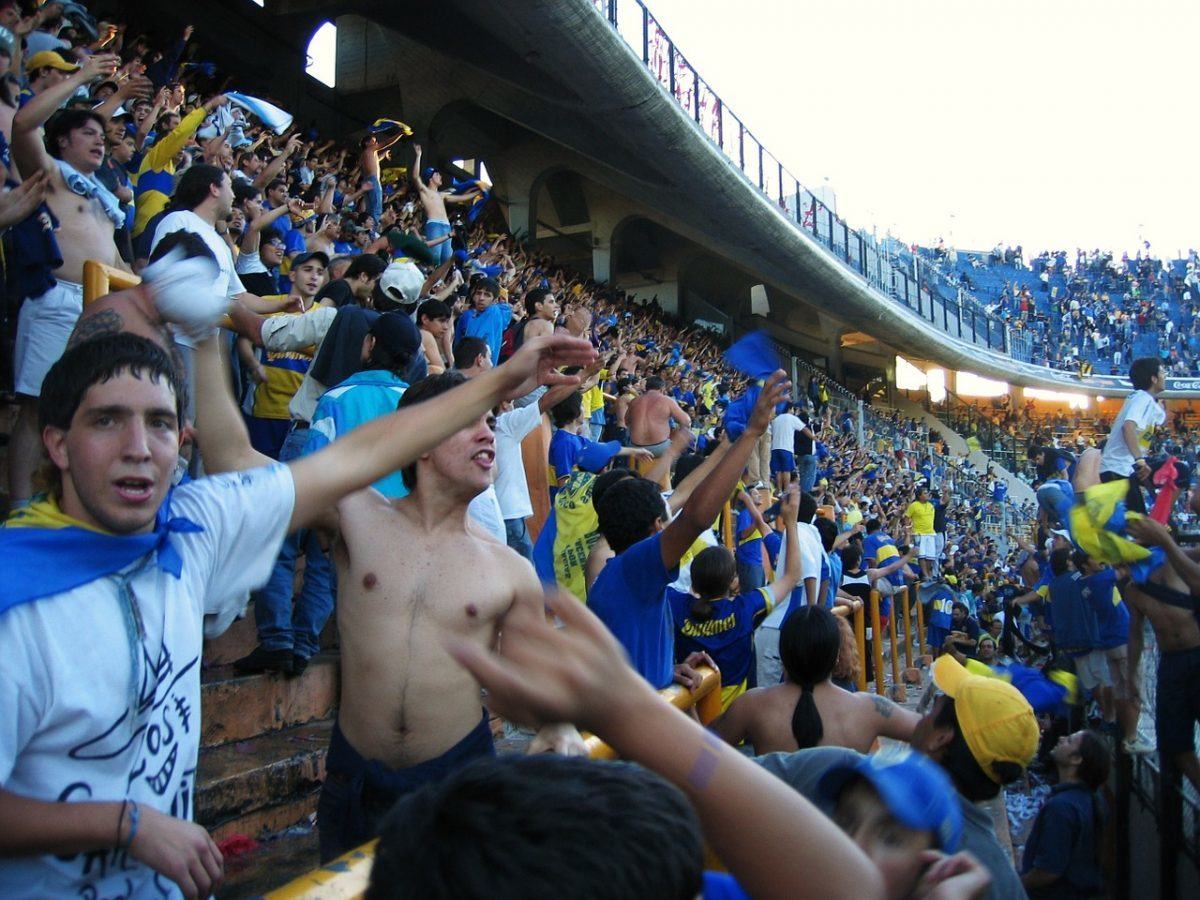
3. Bike the wineries in Mendoza
Mendoza is one of the premier wine productions in the world! What a pleasure it is to say that some of the tastiest (and best priced!) wine is right here!
Take a wine-tasting tour to learn the real value of the honoured Malbec grape. Enjoy a glass or 2, or 3… in this fantastical wine region is a guaranteed good time.
4. Experience Iguazú Falls
Iguazú Falls is one of the mightiest scenes on this planet. Grab a rain jacket and walk amongst the towering falls as they plummet 250 feet into the void.
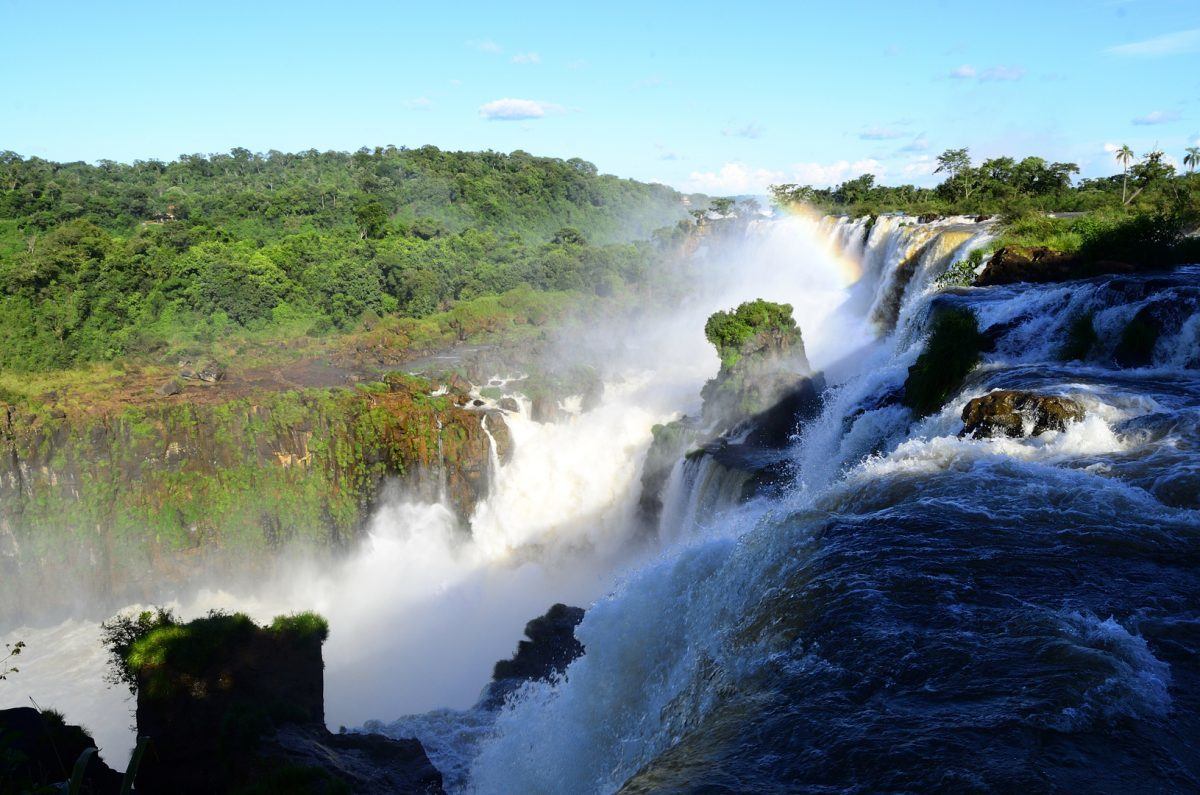
5. Get your walking shoes on!
Who can talk about travelling in Argentina without recommending hiking in Patagonia ? The treks attract walkers from all corners of the world for a reason!
There is really no shortage of trekking opportunities. Grab your boots and take to Cerro Torre, Fitz Roy, and incredible national parks to marvel at their awesomeness.
6. See the life of the Gauchos
Gauchos are Argentina’s version of the cowboy and their relationship with the nation is a long and dramatic one. Visit an estancia and hear about the history that they have of roaming and protecting the nation.
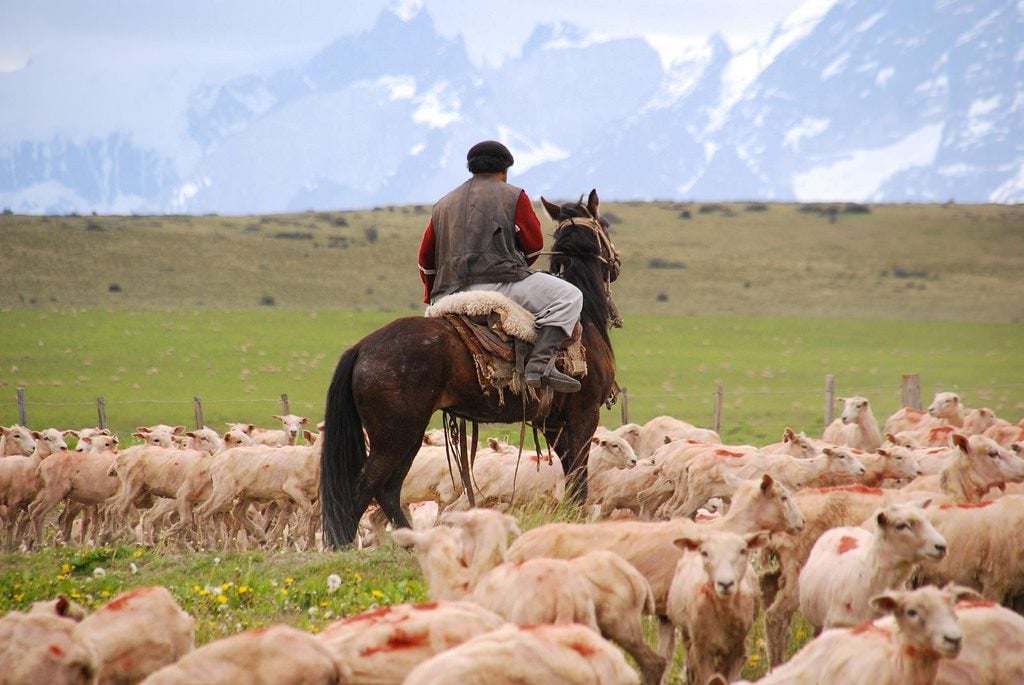
7. Take your mate everywhere
There’s nothing like finding a beautiful spot to just sit and watch the world go by. Then you can do that the Argentinian way too: with your mate (pronounced ma-tey). Mate is usually shared, so it’s a great way to get to know people and share your experience. But even alone, your mate is your friend.
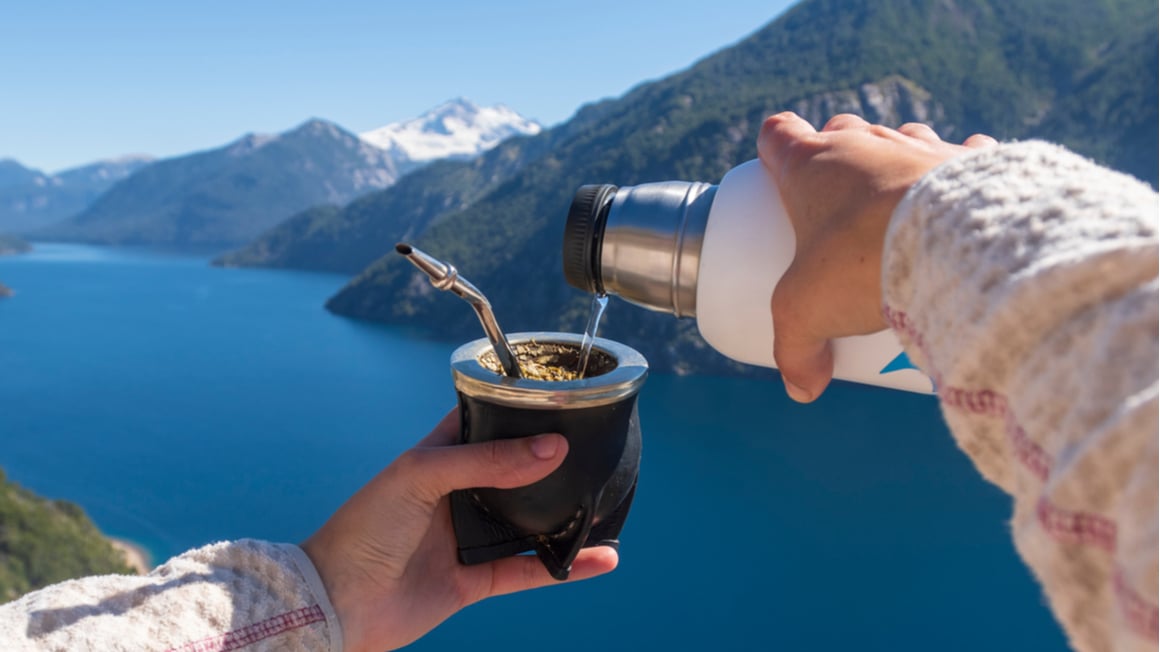
There are stunning parks, mountains, and rivers aplenty in Argentina that become perfect places to take your mate and watch the world go by.
8. Take a road trip
No backpacking route in Argentina would be complete without a road trip. One of the best places to do this is through its finest desert landscapes; some of the biggest deserts in the world in fact!
The Quebrada de Humahuaca road and the Seven Coloured Hills that run through Valles Calchaquí region are both a wild ride. If you have your own transport, you can stop as you please and soak in the splendour.
9. Watch wildlife in Iberá Wetlands or Peninsula Valdes
These are some of the least visited tourist attractions in Argentina due in part to their remoteness. Neither should be missed though as they contain some of Argentina’s most spectacular wildlife!
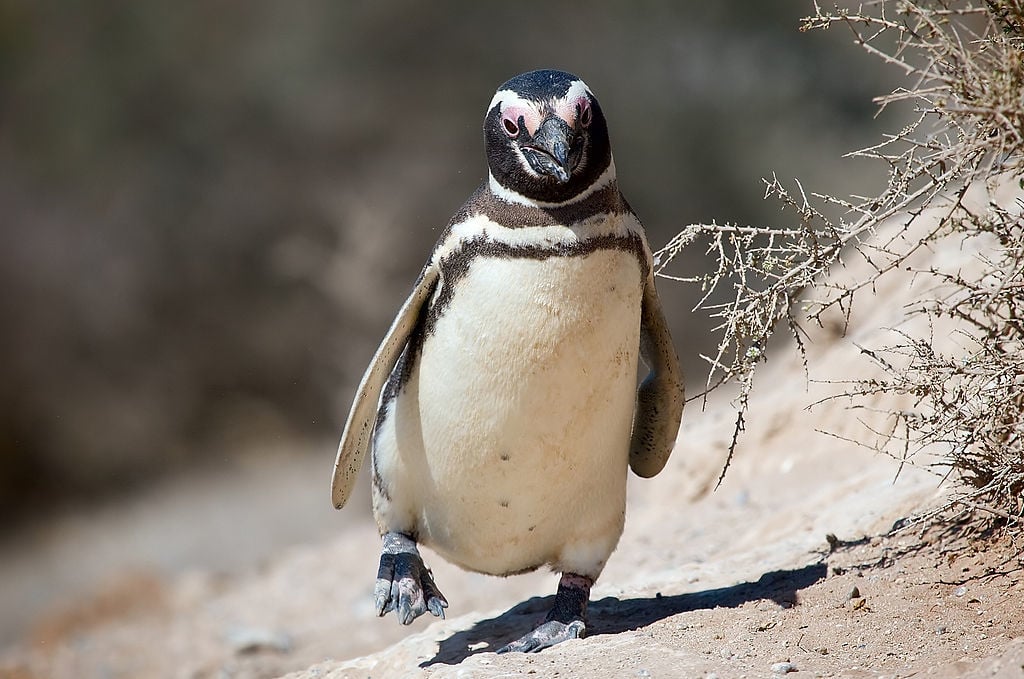
10. An Argentinian
Hey, listen, most backpackers are gonna tell you love and sex while travelling is always something good to partake in. But when I talk about the passion that the Argentinians have, just imagine how that transcends to love …
And the sex? No way… Go find out for yourself.

Wanna know how to pack like a pro? Well for a start you need the right gear….
These are packing cubes for the globetrotters and compression sacks for the real adventurers – these babies are a traveller’s best kept secret. They organise yo’ packing and minimise volume too so you can pack MORE.
Or, y’know… you can stick to just chucking it all in your backpack…
There are a ton of budget backpacker lodges in Argentina! You’ll have no problem finding a place to stay while backpacking Argentina. Of course, there’s an abundance of hostels in Buenos Aires and budget accommodation is ample all over the country.
Many hostels can fill up quite quickly during their respective peak seasons. For example, lodging in Bariloche may be harder to find during the winter when the ski lodges are open.
Conversely, the hostels in Patagonia are busier in the summer when conditions are prime for trekking. In these cases, booking in advance could be beneficial.
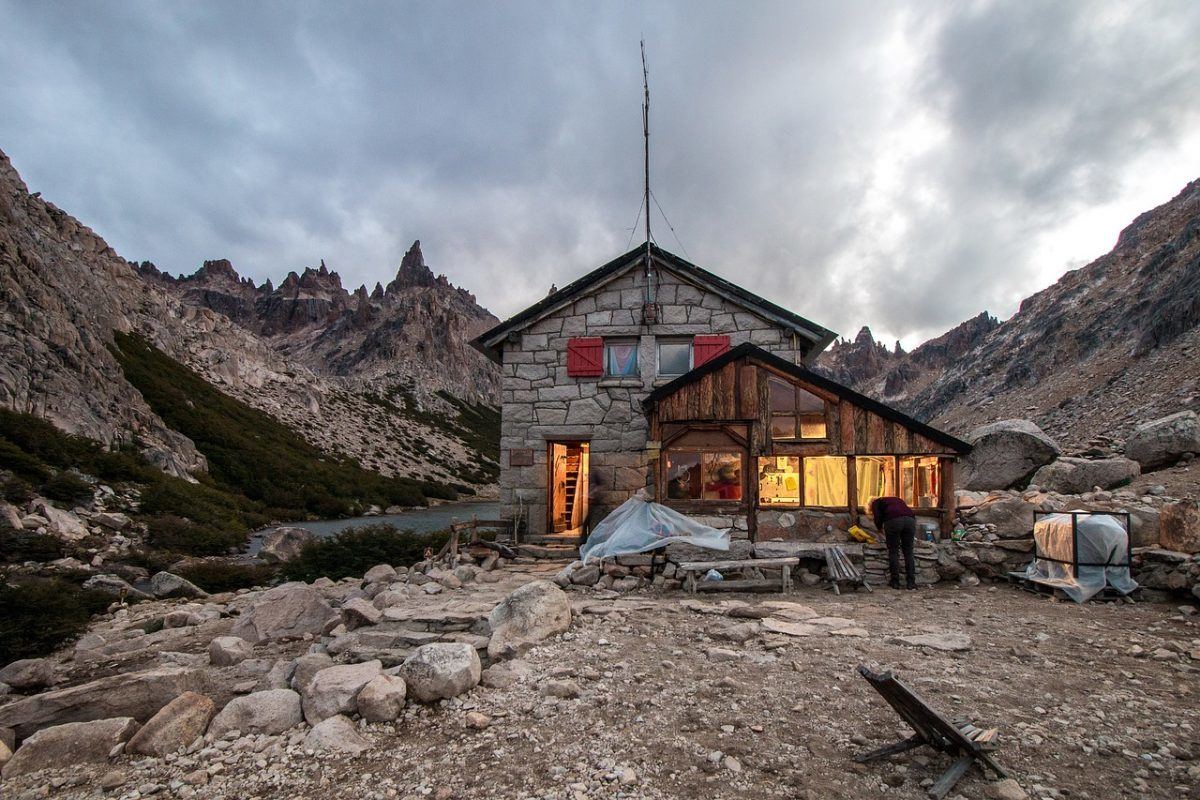
For the best budget accommodation and the best vibes while staying in Argentina, look no further than Couchsurfing . The Argentinians definitely know how to host a guest.
When I’m not Couchsurfing, Airbnb is always my next choice. Having the option to cook your own food saves loads of money. Plus, I’m an introvert: I need my own space from time to time.
Estancias , which are like farm stays or ranches, are another popular form of accommodation in Argentina. This is a great way to experience life in rural Argentina. They can be a bit pricier than a hostel but you can’t get the kind of Argentina experience you can by staying with gauchos from a hostel.
Best Places to Stay in Argentina
Look, you’re going to find great places to stay in Argentina, no matter where you go. But these are some of the absolute best.
Argentina is a paradise for outdoors lovers. There are so many different types of landscape in this country: mountains, tundra, desert, forest, swamp, and more are all represented here. The possibilities for unique adventures are endless.

Things go wrong on the road ALL THE TIME. Be prepared for what life throws at you.
Buy an AMK Travel Medical Kit before you head out on your next adventure – don’t be daft!
Trekking in Argentina
Hikers have probably had a big heart over Argentina ever since they thought about planning a trek abroad . From multi-day treks to little day hikes, the explorer within us will not be disappointed.
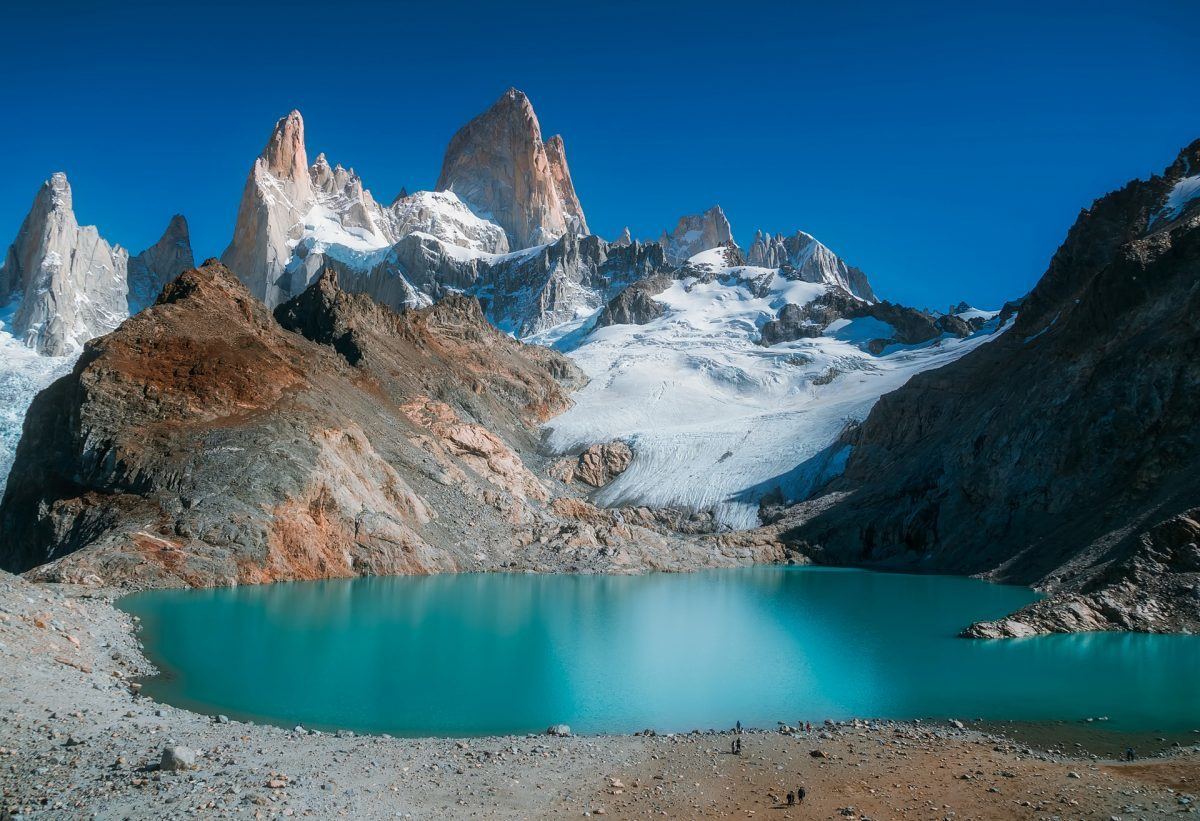
If you’re going to one of Argentina’s many wildernesses or outdoor parks, then I suggest buying all of the necessary camping gear. You’ll save some money that way and avoid paying for rentals via tour operators.
Consider buying a tent and a sleeping mat, or ditch both by investing in a hammock. A good backpacking stove is also a good idea for saving money and creating the best views for your meals.
The Best Treks in Argentina
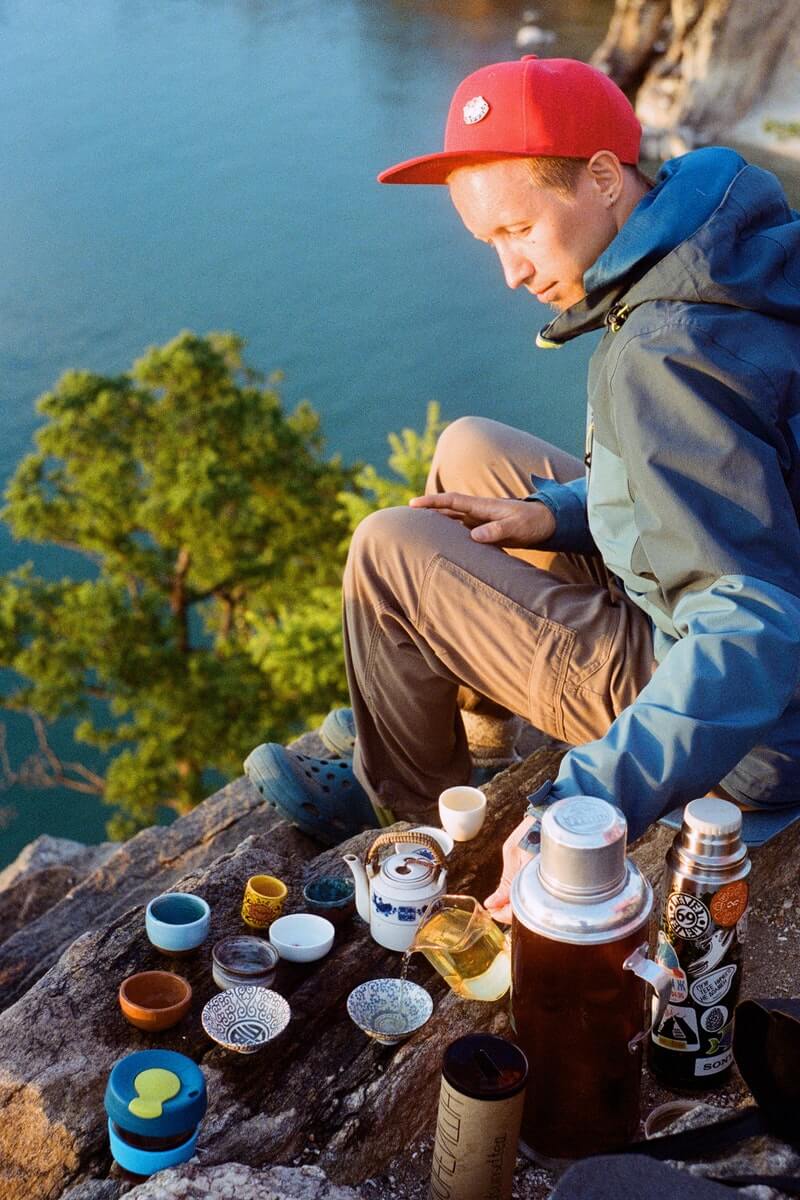
- Los Gigantes (1-2 days, 14 miles) – Big hike into one of the most beautiful portions of the Sierras de Córdoba. Accomplishable via a single (long) day or a multi-day trek.
- Cerro Champaquí from Villa Alpina (12-14 hours, 12 miles) – Reach the summit of the highest peak in the Sierras de Córdoba. May involved overnight camps depending on fitness and itineraries.
- Quebrada de las Conchas (4-5 hours, 6 miles ) – Amazing trek into the Quebrada de las Conchas region of Cafayate. Some of the most stunning desert scenery in Argentina.
- Hut-to-Hut in Bariloche (4 days) – This Spectacular hike affords some of the best views of Nahuel Huapi National Park and its lakes. Tents are optional since you can stay exclusively in the refugios.
- Villa O’Higgins to El Chaltén (2-3 days, 21 miles ) – One of the greatest ways to experience Patagonia. Walk from Villa O’Higgins in Chile to El Chaltén in Argentina. You’ll see some superlative mountain, forest, and lake scenery along the way.
- Laguna de los Tres (8-10 hours, 16 miles) – Hike to one of the most recognized places in all of Patagonia, the Laguna de los Tres at the base of the infamous Monte Fitz Roy.
- Laguna Torre (7-9 hours, 15 miles) – Another must-do hike in El Chaltén, this time to Laguna Torre at the base of the diabolical-looking Cerro Torre.
Hitchhiking in Argentina
Travelling by hitchhiking in Argentina is a pretty common form of transport. There are few roads and lots of drivers heading in the same direction as you, so you can find a good spot easily enough. Just note that hitching in the north of Argentina and hitching in the south are two very different experiences.
The north hosts the larger cities and criminal activity is a little higher here. I hate to say it, but there have been a number of hitchhiking-related crimes – so drivers can be a little cautious. But when you find a ride, drivers are friendly and chatty.
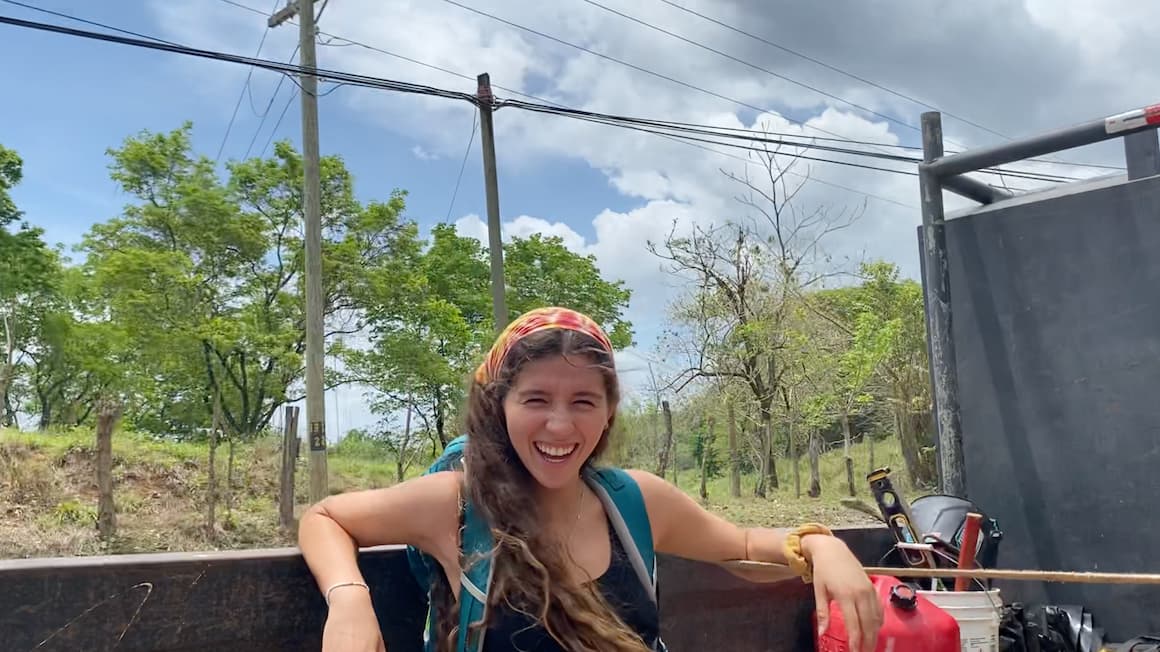
Hitching in the south of Argentina is a matter of finding a ride in the first place. Roads in this part of the country are sparse and there are fewer drivers around.
Drivers are usually more concerned about dealing with treacherous roads and not about picking up hippies. Trying to find a ride in Patagonia in any season outside of summer can be a bleak and very uncomfortable experience.
I would also say to not expect a free ride. Discuss with the driver beforehand about what you’re doing and maybe, at the very least, offer to buy some lunch.
To put it frankly, Argentina is cheap as holy shit right now. In some areas, it even compares to the likes of Southeast Asia. What is a shit situation for local people is shouting us broke backpackers from the rooftops.
I can write a whole essay about the cost of backpacking Argentina. It’s constantly in financial crisis . On top of this, with the effects of the pandemic, the economy has taken its biggest hit.
The Argentinian Peso is constantly suffering inflation. This has led to the black market money exchange in Argentina.
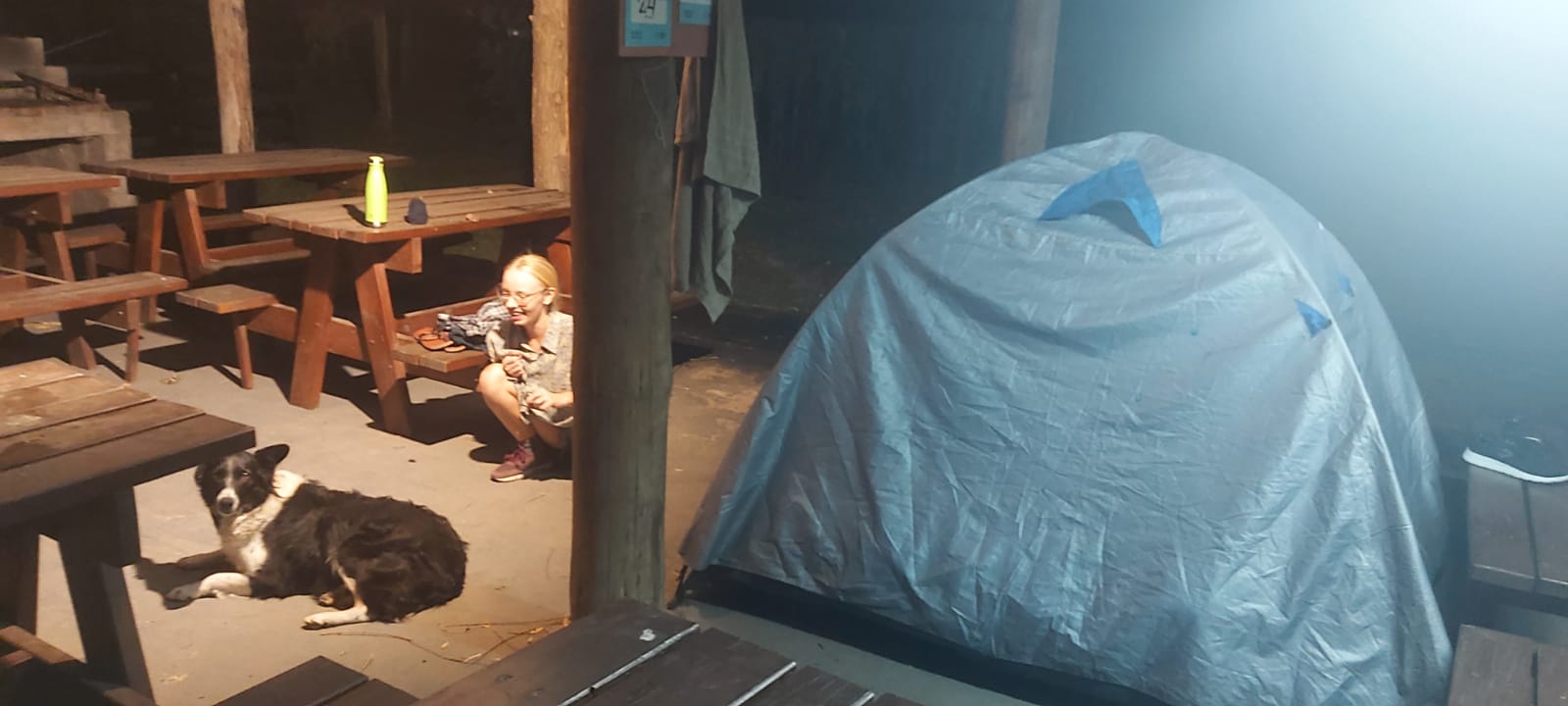
As always, Couchsurfing and camping are the best ways to save on lodging. You can find a camping pitch for less than $5 USD per tent.
Finding cheap food is the least of your concerns. It’s everywhere. Tell me empanadas are $0.35 cents each and I’m rolling out the joint.
Eating out is definitely affordable. A meal for 2 at restaurant, bottle of wine, AND a tip for the staff for less $10 USD is easy. (Tipping isn’t necessary – and I’m not usually a tipper either – but I had to leave a tip for this price.)
Long-distance buses are generally pretty cheap. Overnight buses are super comfy saving your accommodation. 😉 Avoid internal flights if you are on a tight budget while backpacking Argentina.
Obviously in the more remote areas, like Patagonia, prices are higher than in the rest of the country. If you’re going there, you can expect a higher budget. It’s beautiful though so totally worth it.
With some consciousness, a broke backpacker’s budget of $10 USD is easily doable here. If you feel like letting go a bit, a $40 USD daily budget will see you to a very good time.
So budget travel in Argentina is alive and well! Your money will go far here and you can help out a lot of people with your tourism.
A Daily Budget in Argentina
So let’s put it simply. Here’s a quick breakdown of the daily costs of travel in Argentina.
Money in Argentina
The currency in Argentina is the Argentine Peso. With constant inflation in Argentina, you’re going to be seeing a lot of it. Knowing the tricks with this is one of the hottest travel tips for South America right now.
As of writing this (December 2023) here are the current exchange rates for the Argentinian Peso:
The official rate is roughly 800 Argentinian Pesos = $1 USD
The “Dólar Blue” rate is 960 Argentinian Pesos = $1 USD
This brings us to the black market in Argentina . You will notice a drastic difference between exchanging money “officially” and exchanging money on the black market – also known as the “Dólar Blue” .
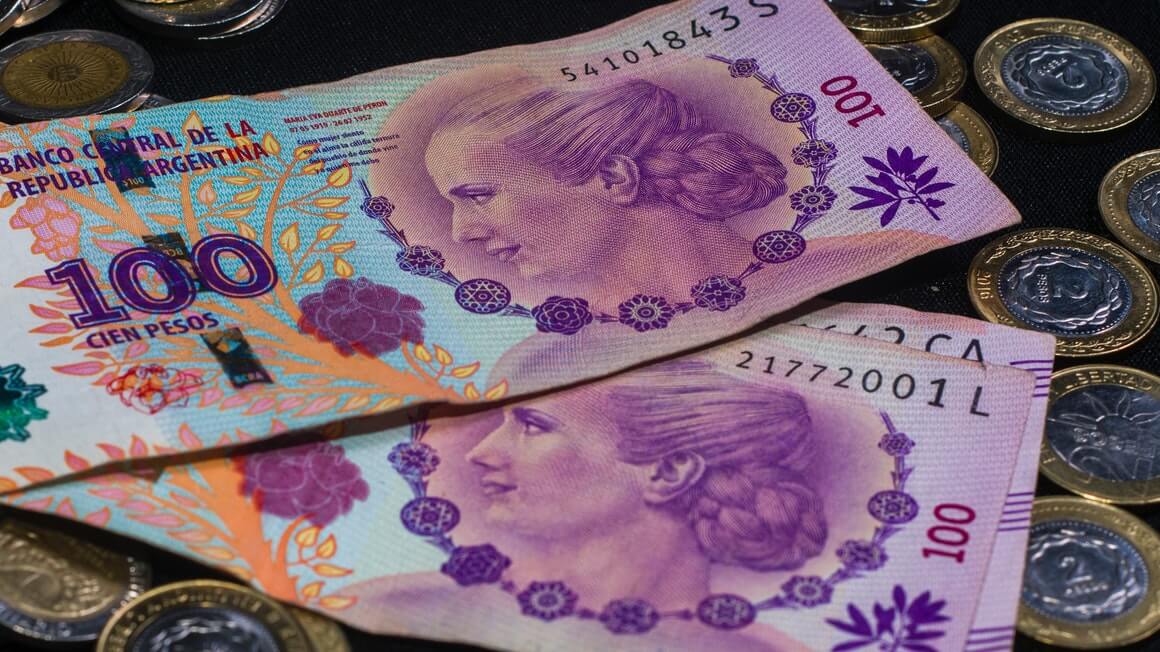
The best way to exchange money on the black market is to bring money in USD and exchange money when you arrive. You’ll find people selling, and you can always ask for advice when you arrive. The locals are using USD to save money from inflation so they’re more than happy to help you out.
Of course, there is a risk in arriving with loads of dollars: Argentina, is not the place to be prancing around with a fat stack – unless you feel like losing it. So hide your cash well while travelling.
You can retrieve money through Western Union at the black market rate. Beyond this, as far as I know, any other way to exchange money means you’re going to get ripped off.
There are ATMs in most places. But I wouldn’t recommend using them. If you’ve no other option – they’re there.
For all matters of finance and accounting on the road, The Broke Backpacker strongly recommends Wise – The Artist Formerly Known as Transferwise! Our favourite online platform for holding funds, transferring money, and even paying for goods, Wise is a 100% FREE platform with considerably lower fees than Paypal or traditional banks.
But the real question is… is it better than Western Union?
Yes, it most certainly is.
Travel Tips – Argentina on a Budget
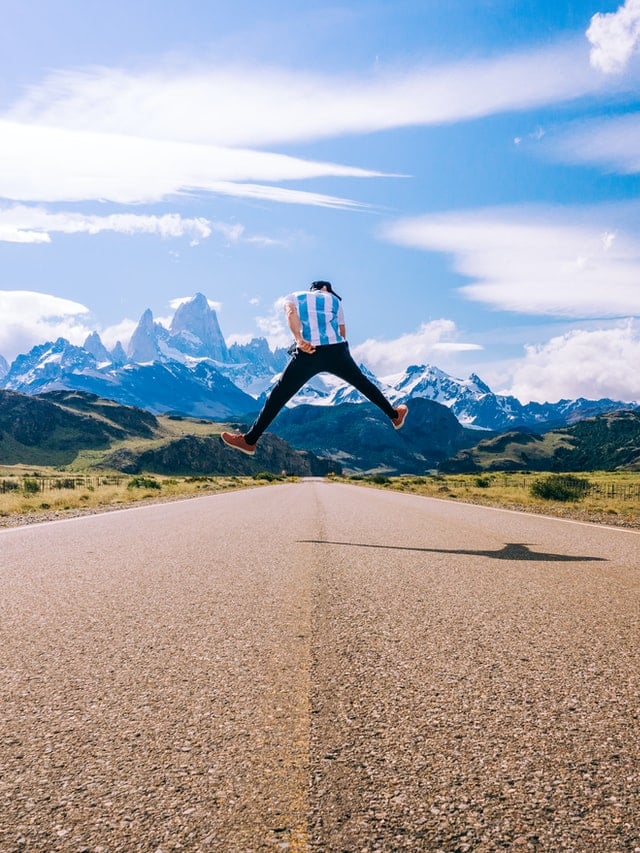
- Camp : Argentina is one gorgeous country to camp, especially in the rural areas. It has been known to even pitch tents in people’s yards (and maybe get invited to an asado). Having a good backpacking tent is your first step to outdoorsy goodness.
- Cook your own food: If you are on a tight budget, you can save money by cooking your own food. Having a portable backpacking stove is a badass trick too.
- Book your transportation early: Both plane and train tickets are much cheaper if you purchase them in advance. This rule doesn’t apply to buses, you can book them the same day or even hour.
- Couchsurf: Argentinians are awesome but I wouldn’t stay anywhere without solid positive reviews. You know this shitty world means that travelling as a woman means we have more personal safety to consider. That being said, Couchsurfing makes real friendships and you see this country from the local perspective.
Why You Should Travel to Argentina with a Water Bottle
We’re globally aware of the plastic problem now, and it can seem overwhelming sometimes to change your habits. But little by little, we can make a difference.
One of the easiest ways to reduce single-use plastic in your life is by carrying a filtered water bottle. You don’t have to worry about the safety of the water, nor do you have to lean on buying plastic bottles every day. It’s one simple step to continue on the road of being a responsible traveller .
Plus, now you don’t have to PAY for water either! Because that really is absurd… Travel with a filtered water bottle and never waste a cent nor some poor fish’s life again.

Drink water from ANYWHERE. The Grayl Geopress is the worlds leading filtered water bottle protecting you from all manner of waterborne nasties.
Single-use plastic bottles are a MASSIVE threat to marine life. Be a part of the solution and travel with a filter water bottle. Save money and the environment!
We’ve tested the Geopress rigorously from the icy heights of Pakistan to the tropical jungles of Bali, and can confirm: it’s the best water bottle you’ll ever buy!
If you haven’t realised by now – Argentina is a massive country and spreads across multiple latitudes. Climate is extremely varied in Argentina; it has regions of excessive heat and humidity, bone dry deserts, highly unpredictable sub-arctic, and everything in between.
But generally, Argentinian weather is generally warm and wet in the summer (December – February) and cold and dry in the winter (June – August). Patagonia is the exception to this rule as it is warm(ish) and dry(ish) in the summer.
Summers are hot in the northeastern corner of Argentina . It can be almost unbearable at times actually. Buenos Aires, Mar del Plata, Rosario, Iguazú Falls, and Córdoba all fall under this category. Winter in these locations will be pleasingly mild and relatively dry.
Northwestern Argentina is predominantly a desert climate so summers here will be very hot while the winters can be quite cold. They are treated to nice summer thunderstorms from time to time. But as it’s the mountains, it can vary a lot.
Finally, the climate in Patagonia is just nutty and very location dependent. Some parts of the region have predictable weather and others are a complete wild card. Summers are generally drier but not exempt from thunderstorms. Winters are almost always cold and snowy.
Honestly, backpackers can visit Argentina at any time of the year; when you go is really dependent on what you want to do. Argentinian winters are great for skiing, and Buenos Aires will be nice and cool. Summer can be super hot and wet, but everyone is in very high spirits.
What to Pack for Argentina
A backpacking South America packing list can look a little different from packing lists for other continents. My mosquito net is my prized possession.
But on every adventure, there are 6 things I never go travelling without:

Snoring dorm-mates can ruin your nights rest and seriously damage the hostel experience. This is why I always travel with a pack of decent ear plugs.

Hanging Laundry Bag
Trust us, this is an absolute game changer. Super compact, a hanging mesh laundry bag stops your dirty clothes from stinking, you don’t know how much you need one of these… so just get it, thank us later.

Sea To Summit Micro Towel
Hostel towels are scummy and take forever to dry. Microfibre towels dry quickly, are compact, lightweight, and can be used as a blanket or yoga mat if need be.

Monopoly Deal
Forget about Poker! Monopoly Deal is the single best travel card game that we have ever played. Works with 2-5 players and guarantees happy days.

Grayl Geopress Water Bottle
Always travel with a water bottle! They save you money and reduce your plastic footprint on our planet. The Grayl Geopress acts as a purifier AND temperature regulator. Boom!
So you’ve heard the rumours. But let’s get it straight: it IS safe to travel Argentina .
Of course, crime is an issue in South America. But crime is an issue everywhere in the world. The vast majority of travellers in Argentina will tell you they had no problems at all by following common-sense travel safety practices .
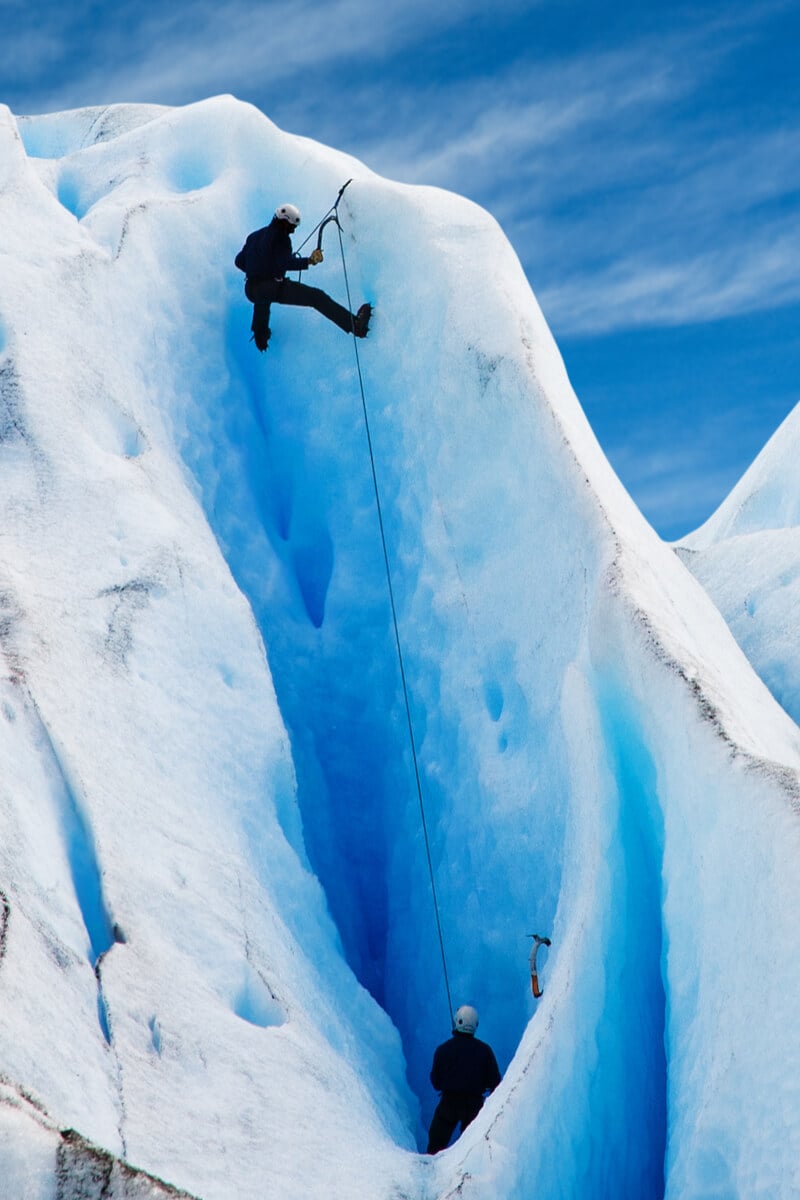
There are certain areas that hold higher risk than others. Large urban cities have the highest crime rate – obviously. But most crime is petty in nature involving pickpockets, scams, and theft of unattended items; violent muggings are not frequent occurrences.
It’s worth asking locals about neighbourhoods you should avoid. Here is a map outlining the safer and more unsafe areas of Buenos Aires . There’s nothing of interest to a traveller outside of the “safe zones” anyway, so you won’t miss a thing.
It should be noted too that drunk driving is a problem in South America. Road accidents are common – please take extra care around the roads. I would go out on a whim and say this is the most dangerous part of travelling in Argentina.
Sex, Drugs, and Rock ‘n’ Roll in Argentina
You know I said the Argentinians are passionate people? Well, that goes for partying too!
First off: the party doesn’t start until well after the sun goes down. Most bars and clubs won’t open until midnight and will only close after the sun has risen. Their partying gusto puts Europe to shame – if you can avoid the shitty cachenge music.
Obviously, this is South America, so cocaine is rife and cheap. This is not like cocaine at home – you’re not snorting as much soap powder here – so be very cautious with your limits.
You’ll also find plenty of other pills and powders around if you keep your eyes and ears open. Just be careful when you are buying drugs on the road. Speak with someone you trust and if it feels weird, it probably is.
One of my (many) favourite things about Argentina is LEGAL WEED! Yes, you heard me right.
The law regarding marijuana has been relaxing for years and most stoners have taken to growing their own plants. It even goes so far as some people being legally permitted to grow and distribute now. Fuck yeah, Argentina!
And now for the sex part: Argentinians are famous for that one. It seems like people are falling in love with Argentinians left, right, and centre! They’re just intensely beautiful and passionate people.
Loving and being loved by them is an experience like no other. So if you’re ready to jump into the dating pool, Argentina could well be the place to do it.
Travelling to Argentina is fairly simple. If you’re travelling from outside of South America by air, chances are you’re landing in Buenos Aires. If you’re arriving from inside South America by air, chances are, it’s still Buenos Aires .
There are plenty of land crossings from neighbouring countries to Argentina. All of these are very easy to conduct. The bus companies are so used to doing these routes so it’s usually a very smooth process.
There is an entry port by boat from Uruguay too. Though this isn’t that common a route.
Entry Requirements for Argentina
Most Western nations can travel to Argentina visa-free for 90 days , depending on your country of origin. For many, the fees have also been waivered! One more reason to visit Argentina.
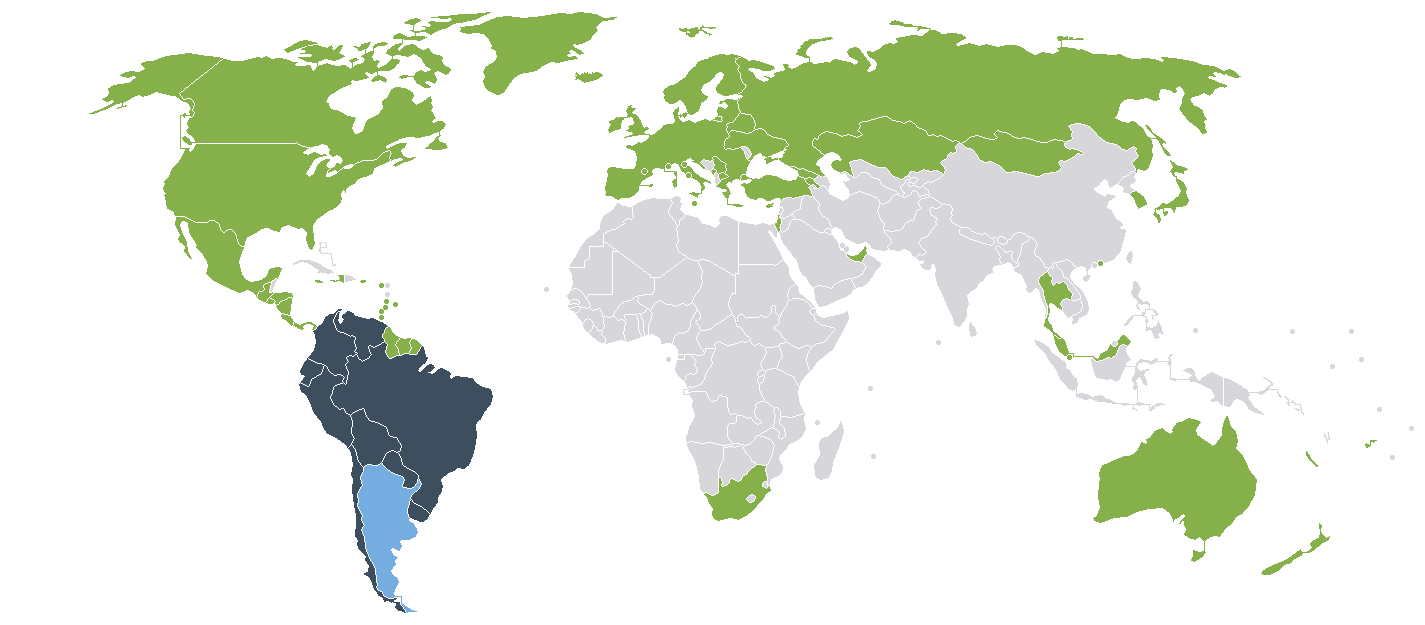
Some nationalities will need to apply for an Argentinian visa prior to arriving. Referring to the map below: those from the nations that are not blue or green will need to contact their local embassy before visiting Argentina.

Get 15% OFF when you book through our link — and support the site you love so dearly 😉
Booking.com is quickly becoming our go-to for accommodation. From cheap hostels to stylish homestays and nice hotels, they’ve got it all!
Travelling between destinations in Argentina is not a quick affair. So no matter which forms of transport you choose, get comfy and enjoy the ride.
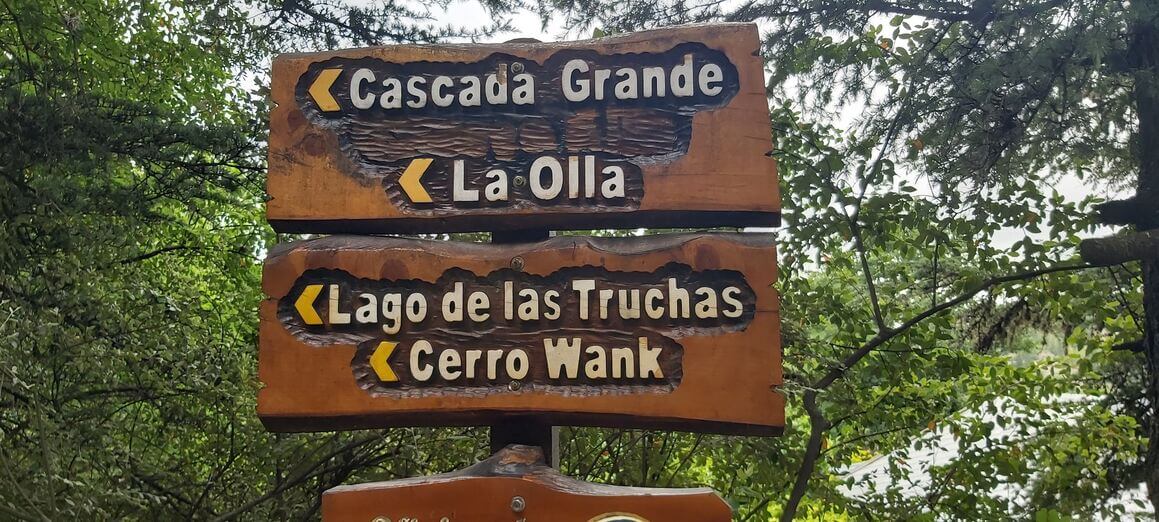
Buses are your new best friend for getting around Argentina! Locally known as the colectivo , they’re comfortable, reliable, and really reasonably priced. Depending on how you like to travel, there are multiple ways to get between major Argentinian destinations.
The best option for travelling in Argentina is undoubtedly driving. Having your own car opens up all kinds of possibilities to enjoy the road less travelled.
Car sharing is very common. One of the best travel apps for Argentina is Carpoolear , which works exactly like BlaBlaCar in Europe. It’s usually a bit cheaper and faster than the bus and, if you’re lucky, sometimes they’ll drop you exactly to where you want to go.
Long-distance buses usually have food and a toilet available – though you’d be wise to bring extra snacks and toilet paper with you.
There are 3 different classes: cama , semi-cama , and servicio común . Cama (meaning bed ) is sleeping class with seats that recline to a completely horizontal position. Semi-cama has semi-reclining seats and servicio común has little reclining, if any at all.
You can purchase bus tickets online but it’s usually cheaper to buy them at the bus terminal. Just use the websites to get an idea of which companies are running to where and the time schedules.
There are a limited amount of long-distance train routes available to those backpacking in Argentina. Most trains connect the larger eastern cities like Buenos Aires, Córdoba, and Mar del Plata.
Flying within Argentina can be expensive, but sometimes it’s a mandatory affair. If you want to visit far-flung places like Patagonia or the Valdes Peninsula and have limited time, you’re going to have to fly.
Buy plane tickets ahead of time to save money. Local airlines like Aerolíneas Argentinas are your go-tos.
Take note that Argentinian nationals pay less for flights than foreigners. Remember this when you think a plane is unusually cheap or falsely advertised.
Onwards Travel from Argentina
Argentina shares friendly borders with all its neighbours. Whether you’re heading to backpack Bolivia , Chile, Uruguay, Brazil, or Paraguay, it should never be a hassle.
If you’re heading overland to continue on the South America journey, you have plenty of border crossings to choose from:
You can catch a ferry in Buenos Aires to the lovely Uruguayan town of Colonia, which is just across the Rio de la Plata. There is a slow ferry (3 hours) and a quicker speedboat (1 hour) available.
Both Argentina and Chile share Patagonia, so you can continue your mountain exploration at one of the many crossings here! Many people hop back and forth across the border easily when backpacking in Patagonia and never experience a single problem.
There aren’t many international airports in Argentina. If you’re leaving South America, you’ll probably be heading to Ezeiza Airport in Buenos Aires .
Getting Insured BEFORE Visiting Argentina
It’s no joke: travelling without insurance in Argentina is risky. Even with all the best intentions, you simply can’t prepare for everything.
In a worst-case scenario situation, the last thing you want to think about is how you’re going to pay for healthcare. So having good travel insurance before you set off on your adventure can literally be a life-saver.
ALWAYS sort out your backpacker insurance before your trip. There’s plenty to choose from in that department, but a good place to start is Safety Wing .
They offer month-to-month payments, no lock-in contracts, and require absolutely no itineraries: that’s the exact kind of insurance long-term travellers and digital nomads need.

SafetyWing is cheap, easy, and admin-free: just sign up lickety-split so you can get back to it!
Click the button below to learn more about SafetyWing’s setup or read our insider review for the full tasty scoop.
Argentinians are very confident and engaging people, so much so that they can even seem intense or intimidating. Really, they’re just very social people. You’ll find everyone, of all genders, greets with a kiss on the cheek – and you won’t be exempt from their kisses.
Argentinians can be boisterous – their personalities fill the room. They waste no time in expressing their mind or feelings. But it’s not to be coarse or arrogant; that’s just their way. Truthfully, they’re some of the most admirable people that I’ve met.
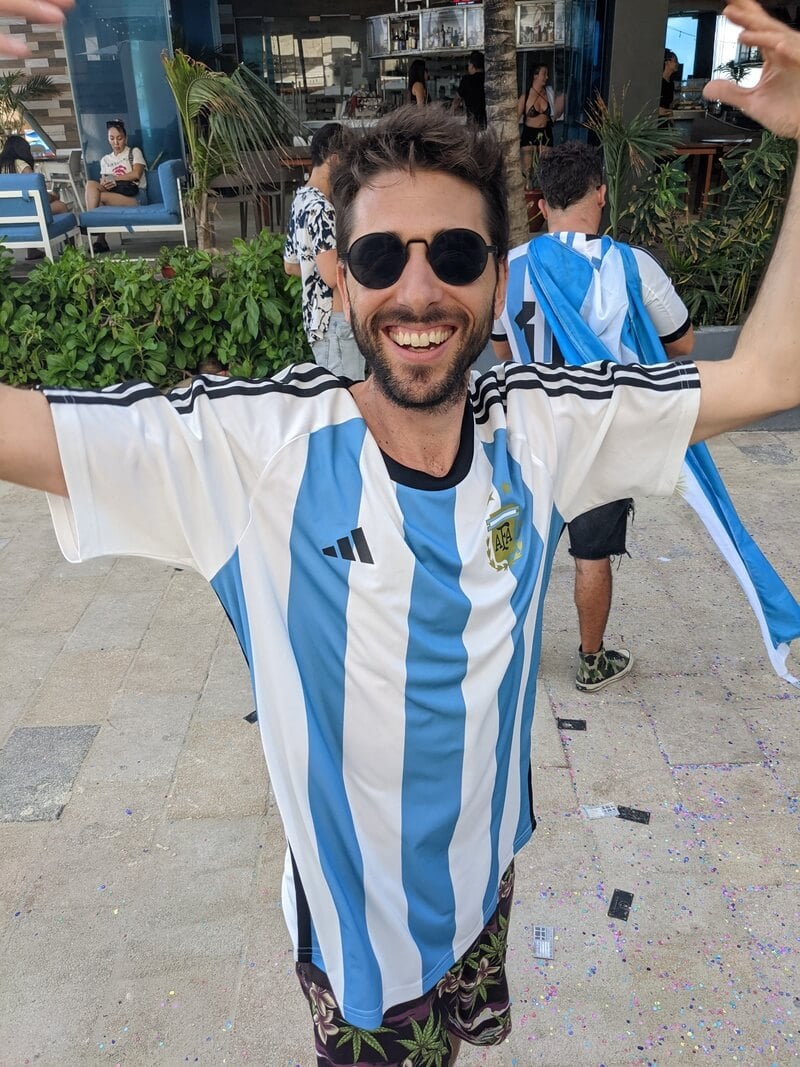
They have little regard for poking fun at you, their friends, or themselves. It’s nothing personal. Actually, it’s their way of showing they like you.
Mate (pronounced ma-tey) is a big part of the culture, especially in the Northern regions. The drink is usually shared between groups and they take it everywhere they go. Being from the UK, my tea culture blended perfectly well with this.
The country is a melting pot of ethnicities and races and its people have taken the best features from their European, Latin, and Indigenous ancestors. Seriously, Argentinians are absolutely beautiful people.
If you want to jump into the dating pool, then be ready to jump into the deep end . They are passionate beyond measure and they will speak from the heart.
G auchos are South American “cowboys” and a national symbol of Argentinian heritage. Before they were forced to fight wars for independence, they were peaceful landkeepers.
Today, football is almost a religion in Argentina. You won’t go a day without seeing shrines to Lionel Messi and Diego Maradona and you literally can’t turn a TV on without a football match appearing. Now imagine all that boisterous energy in their thousands at a football match…
Useful Travel Phrases for Argentina
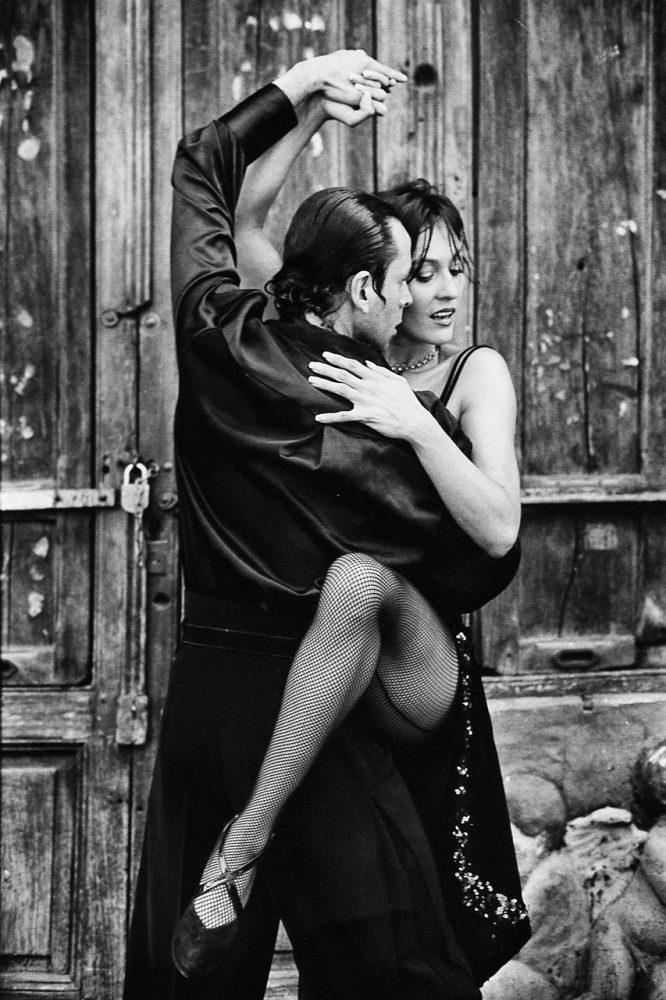
Argentinians speak a very distinct form of Spanish called Castellano Rioplatense . This dialect is different from conventional Spanish. For example, the pronoun tú is replaced with vós .
Argentinians also use slang or Lunfardo – in excess. Lunfardo has no official recognition and is used only in casual conversation. They speak fast and rhythmically, so even if you’re a Spanish speaker, expect a little adjustment phase.
It’s one of the best countries to learn a new language . If you can master communicating in Spanish in Argentina, you’re ready for the rest of South America.
Most Argentinians study English in high school thanks in part to its usefulness and also to the substantial British population. Many locals can communicate with you via English but they love it when you speak whatever Spanish you can muster.
At the very least, learning a few local expressions is useful. So to make your life easier, here are a few helpful Argentinian phrases with English translations.
- Hola – Hello
- Gracias/de nada – Thanks/you’re welcome
- Dónde está…? – Where is…?
- Como te llamas? – What’s your name?
- Buenos dias/buenas tardes/buenas noches – Good morning/afternoon/night
- Cómo andás? – How’s it going?
- Por favor – Please
- Que hora es? – What time is it?
- Cuanto cuesta? – How much does it cost?
- Claro! – Sure/of course!
- Dale! – Let’s go!
- Buenas ondas – Good stuff
- Que es esto? – What is this?
What to Eat in Argentina
There is no way I can open ‘what to eat in Argentina’ without addressing Asado. It’s basically the common friend of the whole nation. The social gathering all centres around MEAT.
The Asado involves excessive quantities of cow, cooked slowly, tenderly , with love, on a parrilla (a grill). It’s more than a barbecue: it’s an art form.
You know it’s the weekend when that hearty smell hits your nose wherever you are in the country. The parrilla is literally part of the house and they get their use out of it.
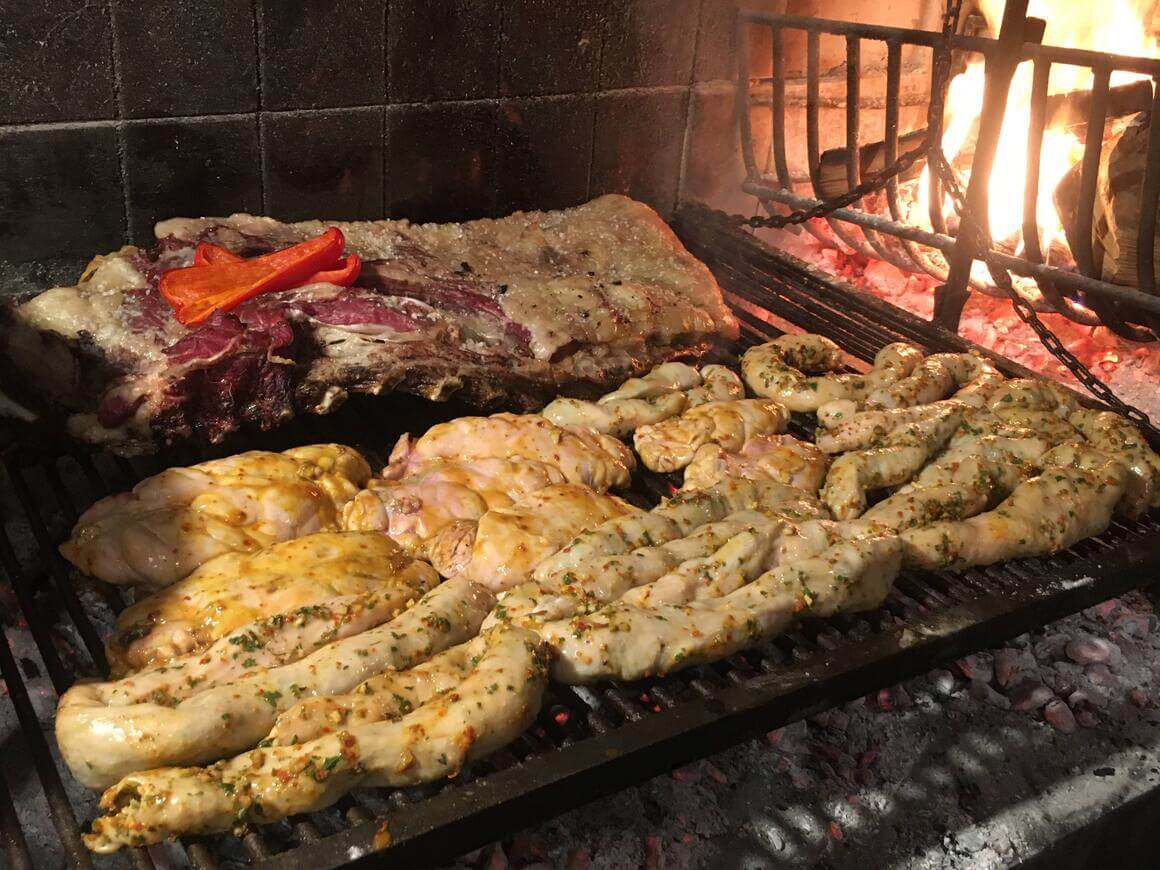
It may or may not be served with salad. But the best Asados are served with chimichurri – a kind of homemade condiment.
Yerba mate is a type of drink. But really, mate is the name of the cup; the yerba is the herb they put inside and drink with hot water, kind of like tea. It’s packed with caffeine and they share the same mate with everyone. Consider it an honour when they pass the mate your way.
If you’ve never tried dulce de leche before, get ready to gain a few kilos. This caramelised condensed milky goodness is everywhere in Argentina: ice cream, alfajores, on bananas, damn even straight off the spoon.
Empanadas are a staple of the diet. These stunning, stuffed pastry pockets come in all flavours. They cost next to nothing so bounce street to street sampling everyone’s soul food.
As a flexitarian, I was kind of revolted by the quantity of meat I saw (and ate) when I arrived in Argentina. But honestly, when I actually looked I was surprised: veggie options are definitely on the rise. I found it easier to avoid meat here than in other countries. It’s the cheese that’s almost impossible to avoid.
For your pleasure, I’ve created a list of 10 of the must-try foods in Argentina.
Must-Try Dishes in Argentina
- Empanadas – Pastries you’ll find everywhere
- Choripan – chorizo sausage sandwich
- Milanesa – fried breaded meat, like schnitzel
- Chipa – cheesy bread balls
- Dulce de leche – caramelised condensed milk
- Asado – meaty Argentinian goodness
- Provoleta – cheese perfect for grilling
- Chimichurri – homemade sauce
- Alfajores – dulce de leche, biscuit, chocolate…say no more
- Yerba Mate – hot infusion drink that’s shared
A Brief History of Argentina
Argentina is a young nation with a brief and turbulent history. Prior to the arrival of Europeans in the 16th century, the land was sparsely populated by native tribes.
The natives repel Spanish conquistadors somewhat successfully until the early 16th century. But this is the beginning of a long and sad story.
Sadly, as we know, European colonization was only a matter of time. The indigenous people were almost completely wiped out by the Spanish invaders.
By the 18th century, a stable settlement of the Spanish Empire is established in the area around the Rio de la Plata . Though brief in existence, this “viceroyalty” soon morphs into the first iterations of the Argentinian Republic.
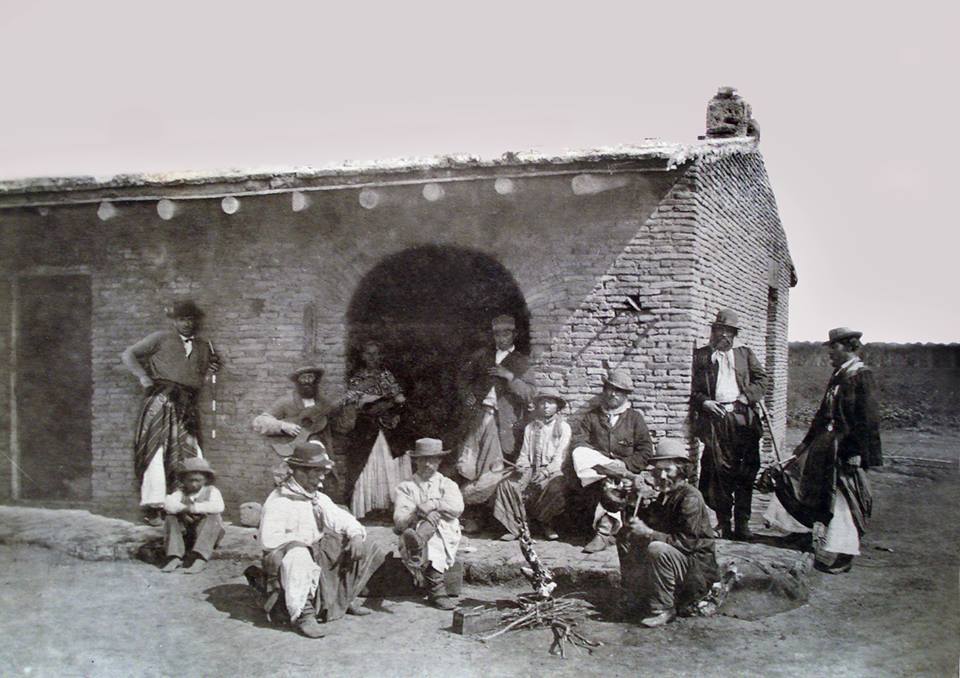
In the early 19th century, Argentina was marked by internal conflicts between federalists and unitarians. Juan Manuel de Rosas was one of the leading figures of this time and was supremely polarizing.
In Buenos Aires, a series of successions and coups opposed him. An official democratic constitution declaring nationhood would finally be ratified in 1853.
Over the next few generations, Argentina is juggled between liberal and conservative parties. Having lost the territories of Uruguay, Paraguay, and Bolivia to the Wars of Independence, Argentina began to expand southward into the desert and Patagonia. By the turn of the 19th century, Argentina resembles its current form.
In the first half of the 20th century, the economy boomed and people emigrated in droves. But key events of this era – World Wars and the Wall Street Crash – leave Argentina in tatters. During WWII, Juan Peron would stage a coup and set Argentina down the path of internal strife yet again.
Since the 1950s, Argentina has suffered brutal dictators and great political upheavals. Although much more stable and safe, the economy and population still suffer the effects. Though, democratic rule has been restored.
Due to the consequences of war, slavery, and colonisation, Argentina is a multi-national country. Today, it is a mixing pot of cultures.
Argentina is a diamond in the rough for the digital nomad lifestyle : reasonable costs of living, cafe culture, widely available, good internet connection; all features that should make remote workers raise their eyebrows. But for some reason, Argentina has not become a digital nomad hub… yet .
Finding regular work in Argentina will be difficult. Unemployment is high and work visas are hard to come by. If you do somehow manage this, don’t expect spectacular wages.
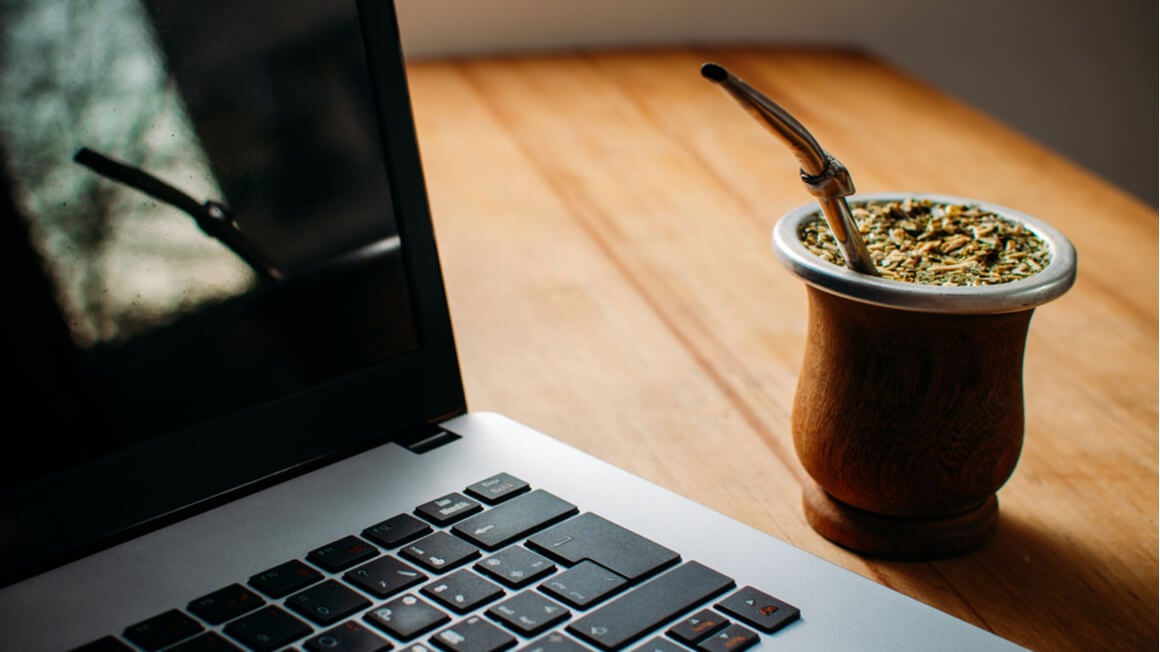
Most people that do work in Argentina are English teachers. Most work 20-30 hours each week with an institute, though some people manage to do just fine with private lessons. To increase your odds of scoring a gig teaching English abroad , it’s always a good idea to get a TEFL certificate.
Broke Backpacker readers also get a 50% discount on TEFL courses with MyTEFL .
Alternatively, Global Work and Travel have a TEFL course in Buenos Aires where you are almost guaranteed a job afterwards. If you haven’t found a job within two weeks, you’ll be assisted in finding one until you do!

Volunteer in Argentina
Volunteering abroad is an amazing way to experience a culture whilst giving something back. Most nationalities can volunteer on a tourist visa for up to 90 days, but long-term stays will have more specific requirements.
Argentina offers a variety of opportunities for backpackers to volunteer. Projects in Argentina range from teaching to agriculture to pretty much everything!. In my personal opinion, the province of Cordoba, in the mountain area, is a very good option combining great weather and people who are cool and receptive to volunteering.
Volunteer programs run through reputable work exchange programs are usually very well-managed and trustworthy. However, whenever you are volunteering, do stay vigilant, especially when working with animals or children.
If you want to find volunteering opportunities in Argentina, I recommend platforms like Worldpackers and Workaway . Although they have their flaws, they are the best way to get your foot in the door of the volunteering community.
Psst… Broke Backpacker readers get a $10 discount when you sign up for Worldpackers. Use the discount code BROKEBACKPACKER .
Is it expensive to travel in Argentina?
No! Argentina is super cheap. If you get a little bit familiar with the black market, you’ll find your money goes far here. Patagonia is the most expensive region in the country. You might see your daily spending creeping up faster if you visit here.
How much time do you need to backpack Argentina?
I would recommend at least 2 weeks for backpacking Argentina. In this time, you could see a few highlights. But it’s a huge country that could be explored for a lifetime. So taking as long as possible to really dive into this country is my real recommendation!
What is the best way to travel around Argentina?
Buses! Or the Colectivo as it’s known in Argentina. Whether you’re travelling long-distance, intercity, overnight, or just to the end of town, buses are going to be your trusty buddy through it all.
Is football popular in Argentina?
Is the pope Catholic? Yes… he is. Football is basically a religion in Argentina. You couldn’t avoid it if you wanted to. I’ve never seen a nation more obsessed with the game.
Argentina is one of those countries that leaves a big, fat print on a traveller’s heart. It is extreme; from the shores of the Atlantic to the tallest tips of Patagonia, this immense country has so much to teach you.
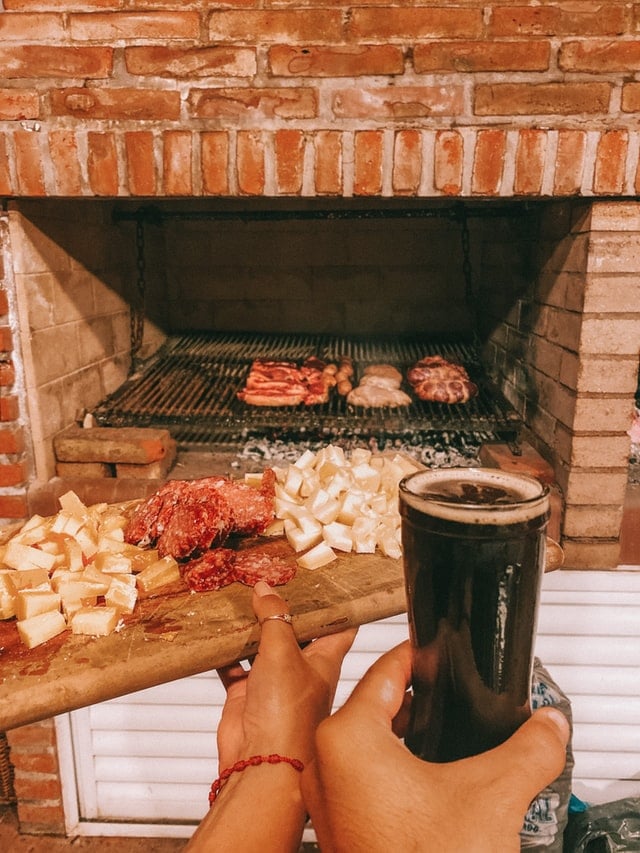
There is one summary I can make after backpacking Argentina. All the things that the Argentinians are most passionate about – Asado, football, mate, wine – they’re all things that are not done alone: they are shared experiences. I think that’s why the energy of this place is so special.
The country is one big melting pot. And you quickly feel like part of the mix.
Your money as a tourist can go far here. But remember, we have a duty, as people of the world, to travel responsibly. You can make a difference to people’s lives with the way you travel through Argentina.
Argentina is a bloody big country. There’s no way you can get round to all of it. But I would love to hear about your experiences and your best travel tips in the comments.
Travelling Argentina is screaming out to the adventurers. So book that ticket! Help out some good people and eat all the empanadas possible.
Now, prepared with your backpacking Argentina travel guide in hand, you’re about to take on the meatiest, most enthusiastic, highly PASSIONATE experience of a lifetime! You’ll find me there. Let’s share a mate.
- We’ve also got where to stay in Buenos Aires covered with our epic guide.
- You’ll also wanna stay in the best hostels in Buenos Aires too!
- Our ultimate South America packing list as all the info you’ll ever need.
- Sort out your backpacker travel insurance before your trip.
- Get your international SIM card organised to avoid hassle.
- Argentina is just the start of your awesome backpacking trip around South America .
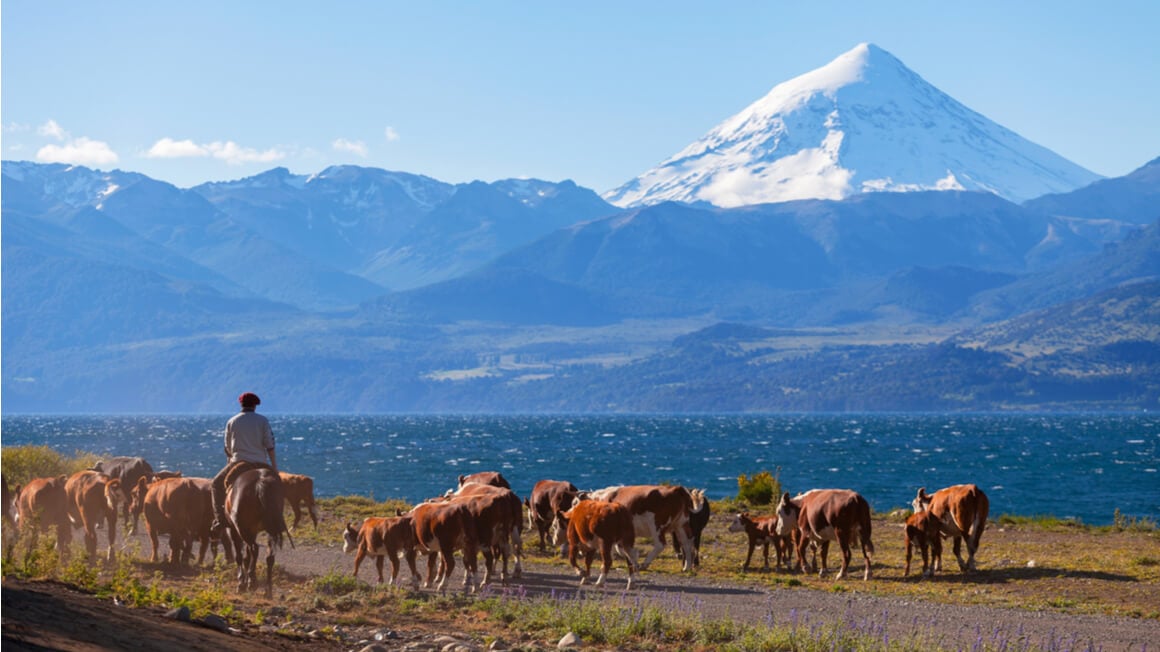
And for transparency’s sake, please know that some of the links in our content are affiliate links . That means that if you book your accommodation, buy your gear, or sort your insurance through our link, we earn a small commission (at no extra cost to you). That said, we only link to the gear we trust and never recommend services we don’t believe are up to scratch. Again, thank you!

Share or save this post

Just got perfect Guide to keep the important things in mind before travelling to Argentina Thanks.
Very comprehensive guide! However the peso is worth 0.026 dollars now (January 2019), which means travelling in Argentina is even cheaper than it was last year.
Leave a Reply Cancel reply
Your email address will not be published. Required fields are marked *
Save my name, email, and website in this browser for the next time I comment.
Notify me of followup comments via e-mail.
- South America
- Travel Planning Guide
Travel Budget for Rosario Visit Rosario on a Budget or Travel in Style
- Rosario Costs

- Rosario Hotel Prices
- Best Business Hotels in Rosario
- Best Family-Friendly Hotels in Rosario
- Best Hotels for One Week in Rosario
- Best Hotels for a Weekend Getaway in Rosario
- Best Luxury Hotels in Rosario
- Best Romantic Hotels for Couples in Rosario
- Best Hotels for One Night in Rosario
- Best Hotels for First Time Visitors in Rosario
- Is Rosario Expensive?
- How much does a trip to Rosario cost?
- Argentina Costs
- Puerto Iguazu
- Mar del Plata
- Buenos Aires, Argentina
- San Miguel de Tucuman
- San Carlos de Bariloche
- Puerto Madryn
- El Calafate
- How much does it cost to travel to Rosario? (Average Daily Cost)
- Rosario trip costs: one week, two weeks, one month
Is Rosario expensive to visit?
- How much do I need for a trip to Rosario?
- Accommodation, Food, Entertainment, and Transportation Costs
- Travel Guide
How much does it cost to travel to Rosario?
You should plan to spend around $9.05 (AR$7,817) per day on your vacation in Rosario. This is the average daily price based on the expenses of other visitors.
Past travelers have spent, on average for one day:
- $3.84 (AR$3,315) on meals
- $2.66 (AR$2,301) on local transportation
- $6.22 (AR$5,370) on hotels
A one week trip to Rosario for two people costs, on average, $127 (AR$109,434) . This includes accommodation, food, local transportation, and sightseeing.
All of these average travel prices have been collected from other travelers to help you plan your own travel budget.
- Travel Style: All Budget (Cheap) Mid-Range Luxury (High-End)
- Average Daily Cost Per person, per day $ 9.05 AR$ 7,817
- One Week Per person $ 63 AR$ 54,717
- 2 Weeks Per person $ 127 AR$ 109,434
- One Month Per person $ 272 AR$ 234,502
- One Week For a couple $ 127 AR$ 109,434
- 2 Weeks For a couple $ 253 AR$ 218,869
- One Month For a couple $ 543 AR$ 469,004
Are You an Experienced Traveler?
Help other travelers! Answer a quick question about your past travels. Click here: let's do it!
How much does a one week, two week, or one month trip to Rosario cost?
A one week trip to Rosario usually costs around $63 (AR$54,717) for one person and $127 (AR$109,434) for two people. This includes accommodation, food, local transportation, and sightseeing.
A two week trip to Rosario on average costs around $127 (AR$109,434) for one person and $253 (AR$218,869) for two people. This cost includes accommodation, food, local transportation, and sightseeing.
Please note, prices can vary based on your travel style, speed, and other variables. If you're traveling as a family of three or four people, the price per person often goes down because kid's tickets are cheaper and hotel rooms can be shared. If you travel slower over a longer period of time then your daily budget will also go down. Two people traveling together for one month in Rosario will often have a lower daily budget per person than one person traveling alone for one week.
A one month trip to Rosario on average costs around $272 (AR$234,502) for one person and $543 (AR$469,004) for two people. The more places you visit, the higher the daily price will become due to increased transportation costs.
Independent Travel
Traveling Independently to Rosario has many benefits including affordabilty, freedom, flexibility, and the opportunity to control your own experiences.
All of the travel costs below are based on the experiences of other independent travelers.
Rosario is a very affordable place to visit. Located in Argentina, which is a very affordable country, visitors will appreciate the lower prices of this destination. It falls in the average range in the country for its prices. Budget travelers enjoy spending long periods of time exploring Rosario in depth.
Within South America, Rosario is a very affordable destination compared to other places. It is in the top 10% of cities in South America for its affordability. Very few cities in the region are as affordable as Rosario.
For more details, and to find out if it's within your travel budget, see Is Rosario Expensive?
How much money do I need for a trip to Rosario?
The average Rosario trip cost is broken down by category here for independent travelers. All of these Rosario travel prices are calculated from the budgets of real travelers.
Accommodation Budget in Rosario
Average daily costs.
Calculated from travelers like you
The average price paid for one person for accommodation in Rosario is $3.11 (AR$2,685). For two people sharing a typical double-occupancy hotel room, the average price paid for a hotel room in Rosario is $6.22 (AR$5,370). This cost is from the reported spending of actual travelers.
- Accommodation 1 Hotel or hostel for one person $ 3.11 AR$ 2,685
- Accommodation 1 Typical double-occupancy room $ 6.22 AR$ 5,370
Hotel Prices in Rosario
Looking for a hotel in Rosario? Prices vary by location, date, season, and the level of luxury. See below for options.
Find the best hotel for your travel style.
Actual Hotel Prices The average hotel room price in Rosario based on data provided by Kayak for actual hotel rooms is $64. (Prices in U.S. Dollars, before taxes & fees.)
Kayak helps you find the best prices for hotels, flights, and rental cars for destinations around the world.
Recommended Properties
- Roberta Rosa De Fontana Suites Budget Hotel - Kayak $ 51
- Hotel Casino Pullman City Center Rosario Luxury Hotel - Kayak $ 168
Transportation Budget in Rosario
The cost of a taxi ride in Rosario is significantly more than public transportation. On average, past travelers have spent $2.66 (AR$2,301) per person, per day, on local transportation in Rosario.
- Transportation 1 Taxis, local buses, subway, etc. $ 2.66 AR$ 2,301
Flights to Rosario
Rental cars in rosario, food budget in rosario.
While meal prices in Rosario can vary, the average cost of food in Rosario is $3.84 (AR$3,315) per day. Based on the spending habits of previous travelers, when dining out an average meal in Rosario should cost around $1.54 (AR$1,326) per person. Breakfast prices are usually a little cheaper than lunch or dinner. The price of food in sit-down restaurants in Rosario is often higher than fast food prices or street food prices.
- Food 2 Meals for one day $ 3.84 AR$ 3,315
Entertainment Budget in Rosario
Entertainment and activities in Rosario typically cost an average of $3.08 (AR$2,663) per person, per day based on the spending of previous travelers. This includes fees paid for admission tickets to museums and attractions, day tours, and other sightseeing expenses.
- Entertainment 1 Entrance tickets, shows, etc. $ 3.08 AR$ 2,663
Alcohol Budget in Rosario
The average person spends about $1.77 (AR$1,525) on alcoholic beverages in Rosario per day. The more you spend on alcohol, the more fun you might be having despite your higher budget.
- Alcohol 2 Drinks for one day $ 1.77 AR$ 1,525
Related Articles
Rosario on a budget.

Food and Dining
Transportation, more related articles.
We've been gathering travel costs from tens of thousands of actual travelers since 2010, and we use the data to calculate average daily travel costs for destinations around the world. We also systematically analyze the prices of hotels, hostels, and tours from travel providers such as Kayak, HostelWorld, TourRadar, Viator, and others. This combination of expenses from actual travelers, combined with pricing data from major travel companies, gives us a uniqe insight into the overall cost of travel for thousands of cities in countries around the world. You can see more here: How it Works .
Subscribe to our Newsletter
By signing up for our email newsletter, you will receive occasional updates from us with sales and discounts from major travel companies , plus tips and advice from experienced budget travelers!

Search for Travel Costs
Some of the links on this website are sponsored or affiliate links which help to financially support this site. By clicking the link and making a purchase, we may receive a small commission, but this does not affect the price of your purchase.
Travel Cost Data
You are welcome to reference or display our travel costs on your website as long as you provide a link back to this page .
A Simple Link
For a basic link, you can copy and paste the HTML link code or this page's address.
Travel Cost Widget
To display all of the data, copy and paste the code below to display our travel cost widget . Make sure that you keep the link back to our website intact.
- Privacy / Terms of Use
- Activities, Day Trips, Things To Do, and Excursions
- English (EN)
- Español (ES)
Is Rosario Safe? Crime Rates & Safety Report
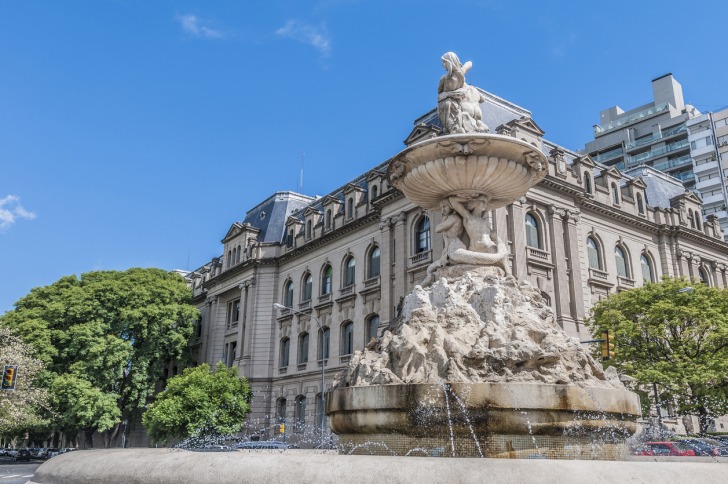
Argentina : Safety by City
- Buenos Aires
- Puerto Iguazu
- Puerto Madryn
- San Miguel de Tucuman
Nestled along the Paraná River, Rosario is a hidden gem in the heart of Argentina’s landscape.
Located in the province of Santa Fe, this bustling metropolis has a rich history and even richer architecture.
Travel websites describe it as a city that prides itself on a dynamic cultural scene, with bustling markets and lively festivals, and your travel agent may already be rushing to book your flight.
But if we look away from what the websites say, we may see things just a bit differently.
The locals may offer a bit of a different perspective, as would the U.S. Embassy, for that matter.
And on that note, let’s take a look at just how safe Rosario, Argentina is for travelers.
- Warnings & Dangers in Rosario
OVERALL RISK: HIGH
According to the official website of the U.S. Embassy in Argentina, the city has a Level 2 travel advisory, which means that visitors should "exercise increased caution." Rosario has earned a Level 2 due to its high rate of violent crimes related to the trafficking of narcotics.
TRANSPORT & TAXIS RISK: MEDIUM
The two main ways of traveling through Rosario are buses and taxis, and they are both fairly reliable. Buses cover most areas of the city and are relatively safe; if you take a taxi, your best bet would be booking one to ensure you find a car in time and avoid getting scammed by an untrustworthy driver. To avoid getting scammed by your taxi driver, you should map out your trip beforehand to ensure that the driver is not driving you in circles, and you should make sure that the meter is on throughout your entire trip.
PICKPOCKETS RISK: HIGH
Rosario's petty crime rate is high, especially in the busier parts of the city. If you plan on visiting this city, you should avoid carrying large sums of money around the city and keep your essentials - like your phone and wallet - close at all times. Additionally, make sure that you do not showcase expensive items (e.g., jewelry or watches) when traveling around Rosario.
NATURAL DISASTERS RISK: HIGH
Similar to most areas in Argentina, Rosario has a high risk of natural disaster. According to the Othering & Belonging Institute at UC Berkeley, the country ranks 55 out of 180 countries in the Global Climate Risk Index 2021. The country faces high risks of storms, floods, and drought. Additionally, due to Argentina's high earthquake risk, tourists and visitors should be aware that an earthquake may hit Rosario during their visit.
MUGGING RISK: HIGH
Rosario's high violent and property crime rate is one of the reasons this city is not a usual tourist destination. Being the third-largest city in the country, Rosario has a violent crime rate that is five times higher than the national average and is struggling with a continuing rising crime rate. Last year, Lionel Messi's sister-in-law fell victim to a violent mugging in Rosario, in which the perpetrators used firearms to commit the crime.
TERRORISM RISK: LOW
The overall terrorism threat in Rosario and the rest of the country is low. However, before visiting this area, you should know that due to Argentina's overall high crime rate and the fact that Rosario is in the top three most violent cities in the country, there is still a small chance of a terrorist attack directed at a specific person or organization.
SCAMS RISK: HIGH
Scams are another type of crime to be aware of if you plan on visiting Rosario. These scams can take many forms, and here is one example. First, be aware of a stranger asking you to take a photograph of them with their camera. The way this scam goes, they will drop the camera, blame you for breaking it, and demand that you pay for the damages. This type of scam puts the victim in an uncomfortable situation, and the scammers know this. Other scams involve the scammer "befriending" you for the sake of stealing your money, or taxi drivers overcharging.
WOMEN TRAVELERS RISK: MEDIUM
Rosario is a relatively safe destination for solo female travelers, but precautions are essential. This means avoiding going out alone at night, especially around certain parts of the city. Plan your trip ahead of time to avoid getting lost or finding yourself in the dangerous parts of the city. It is also advised that you avoid carrying large sums of money or expensive items when traveling alone.
TAP WATER RISK: MEDIUM
Rosario's tap water is continuously treated and meets the local and national safety standards. However, the water in Argentina contains minerals that may be foreign to visitors, thus possibly causing some stomach issues. Because of this, you should only drink store-bought water or use a water purifier if you think this may be a concern.
- Safest Places to Visit in Rosario
It’s true that Rosario does not pride itself on being Argentina’s safest city or biggest tourist destination.
But one thing it does pride itself on is Parque de la Independencia.
This quaint neighborhood, which includes the actual Parque , houses the Museum of Fine Arts, and Rosario’s hidden gem – the National Flag Monument.
And on that note, next on our list of the most interesting spots for tourists and visitors is the National Flag Monument, which lies at the city shore and hides a fascinating artifact – the tomb of Manuel Belgrano, the monument’s creator.
If you plan on visiting Rosario, the National Flag Monument is a must-see.
Another spot worth visiting is Barrio Santa Fe. Located in the north of the city, this classy neighborhood is a hotspot for visitors who wish to enjoy a picturesque view, do some shopping, go to a movie theater or enjoy a meal at a nice restaurant.
Barrio Santa Fe houses multiple embassies and, through its architecture, distinguishes itself from other areas of the city.
- Places to Avoid in Rosario
Due to the high crime rate in Rosario, it’s advised that you do your research before taking a trip here.
This means informing yourself ahead of time of the areas you should avoid.
For example, tourists and visitors should stay away from the slums.
Known by the locals as the “villas,” these have a negative reputation for their high rate of violent crime.
These villas are generally located outside the city, though one may come across them even close to the city center.
If you plan on visiting Rosario, there is one thing to understand – the dangerous places are scattered throughout the city.
Some areas – such as the villas – should be avoided at all costs.
Other areas, however, are moderately safe for travel during the day.
To be cautious, avoid going out past dusk, and venturing into unknown areas.
- Safety Tips for Traveling to Rosario
- Avoid the villas at all costs : Located mainly on the outskirts of the city, the villas (or slums) are some of the most dangerous areas in and around Rosario. Mixing poverty with gangs and drug crime, the slums are a hotbed for criminal activity, and you should avoid them at all costs.
- Don’t carry valuables or large sums of money : While this may be a good tip when traveling to any new city, it is especially good when visiting Rosario. The residents of Rosario are no strangers to muggings, thefts and robberies, especially in the more dangerous parts of the city.
- Keep your car doors locked : Rosario has a high rate of muggings and robberies, and visitors can fall victim to these while stopped in traffic at a stop light. Always make sure that your windows are up, and your doors are locked when the car is stopped.
- Stay away from large crowds : Rosario’s petty crime (like theft) happens mainly in busy places; avoid crowds as much as possible.
- Remain skeptical of strangers : Rosario has a reputation for its high rate of scams. Avoid sharing personal information with strangers, and generally steer clear of people who look in need, as they may be trying to scam you.
- Be aware of your surroundings: Avoid going out alone, especially in unknown areas. Preferably, travel with someone who is familiar with the city and culture.
- Sign up for STEP : The U.S. Department of State advises visitors to enroll in the Smart Traveler Enrollment Program (STEP)” to receive Alerts and make it easier to locate you in an emergency.”
- Plan according to your health needs : The water, food, and temperatures may be different from what you’re used to. Plan accordingly.
- Avoid taking any substances : As mentioned earlier, it’s imperative that you are aware of your surroundings at all times, which you can’t do unless you’re sober as a judge the entire trip.
- Hope for the best, prepare for the worst : Make sure you have the numbers for the local police, embassy, and consulate in your contacts; you may need them – let’s hope you don’t.
- So... How Safe Is Rosario Really?
In short, Rosario is not a safe city for locals or visitors.
In fact, Argentina’s U.S. Embassy has designated this city a Level 2 (Exercise Increase Caution) warning.
Rosario’s growing crime rate has placed this city in the top 3 most dangerous cities in the country.
With a population of 1.3 million residents, Rosario’s homicide rate is five times higher than the national average, with 22 homicides per 100,000 people.
- How Does Rosario Compare?
- Useful Information
U.S. visitors and tourists do not require a visa to visit Argentina as long as their trip does not extend 90 days. However, all international visitors are required to have a valid passport to travel to Argentina.
The currency in Rosario - and the rest of Argentina - is the Argentine Peso. One US dollar is worth 834.292 Argentine Pesos. Similarly, one Argentine Peso is worth 0.0012 U.S. dollars.
Located in the Southern Hemisphere, Argentina has multiple climates, from a temperate climate to a subpolar one. The coldest months in Rosario are June and July; the warmest months are January, February, and December. Rosario experiences its rainiest time of the year in January, February, October, November, and December.
Built only two decades ago, in 2003, the Rosario - Islas Malvinas International Airport offers local and international flights to and from the city. Most of the flights are between Rosario and Panama City, and most of the airlines that fly out of this airport are Aerolineas Argentinas and Gol Areos Ltda.
Travel Insurance
Although acquiring travel insurance is not a mandatory requirement for traveling to Rosario, it's advisable that you do so, anyway. Ideally, opt for the type of insurance that covers unexpected medical expenses. As stated above, it's wise to hope for the best and prepare for the worst.
Rosario Weather Averages (Temperatures)
- Average High/Low Temperature
Argentina - Safety by City
- Where to Next?
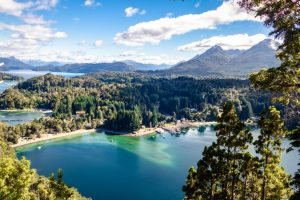
Share Your Experience Cancel reply
Your Review
Title of your review
Article Contents
- Rosario : Safety by City
- Overall Risk
- Transport & Taxis Risk
- Pickpockets Risk
- Natural Disasters Risk
- Mugging Risk
- Terrorism Risk
- Women Travelers Risk
- Tap Water Risk
- Weather Averages (Temperatures)
- User Reviews
- Share Your Experience
Popular Destinations

Safety Index
Recent reviews & comments.
- Claire Gardner on 10 Safest Cities in Ethiopia
- Dee Parker on 10 Safest Cities in Ethiopia
- Jane Dawson on Helena
- Maya Torres on Helena
- Keanna Litt on Monroe
Popular US States
- Pennsylvania
Unprecedented wave of narco-violence stuns Argentina city

- Show more sharing options
- Copy Link URL Copied!
The order to kill came from inside a federal prison near Argentina’s capital. Unwitting authorities patched a call from drug traffickers tied to one of the country’s most notorious gangs to collaborators on the outside. Hiring a 15-year-old hit man, they sealed the fate of a young father they didn’t even know.
At a service station on March 9 in Rosario, the picturesque hometown of soccer star Lionel Messi, 25-year-old employee Bruno Bussanich was whistling to himself and checking the day’s earnings just before he was shot three times from less than a foot away, surveillance footage shows. The assailant fled without taking a peso.
It was the fourth gang-related fatal shooting in Rosario in almost as many days. Authorities called it an unprecedented rampage in Argentina, which had never witnessed the extremes of drug cartel violence afflicting some other Latin American countries.
A handwritten letter was found near Bussanich’s body, addressed to officials who want to curb the power drug kingpins wield from behind bars. “We don’t want to negotiate anything. We want our rights,” it says. “We will kill more innocent people.”
Shaken residents interviewed by the Associated Press across Rosario described a sense of dread taking hold.

World & Nation
The prison that helped build ‘the city at the end of the world’
At the southernmost tip of Argentina’s Patagonia sits ‘the prison of the end of the world.’ The country banished prisoners here in the early 1900s to colonize the region.
Feb. 12, 2024
“Every time I go to work, I say goodbye to my father as if it were the last time,” said 21-year-old Celeste Núñez, who also works at a gas station.
The string of killings offer an early test to the security agenda of populist President Javier Milei , who has tethered his political success to saving Argentina’s tanking economy and eradicating narcotrafficking violence.
Since taking office Dec. 10, the right-wing leader has promised to prosecute gang members as terrorists and change the law to allow the army into crime-ridden streets for the first time since Argentina’s brutal military dictatorship ended in 1983.
His law-and-order message has empowered the hardline governor of Santa Fe province, which includes Rosario, to clamp down on incarcerated criminal gangs that authorities say orchestrated 80% of shootings last year. Under the orders of Gov. Maximiliano Pullaro, police have ramped up prison raids, seized thousands of smuggled cellphones and restricted visits.
“We are facing a group of narco-terrorists desperate to maintain power and impunity,” Milei said after Bussanich was killed, announcing the deployment of federal forces in Rosario. “We will lock them up, isolate them, take back the streets.”
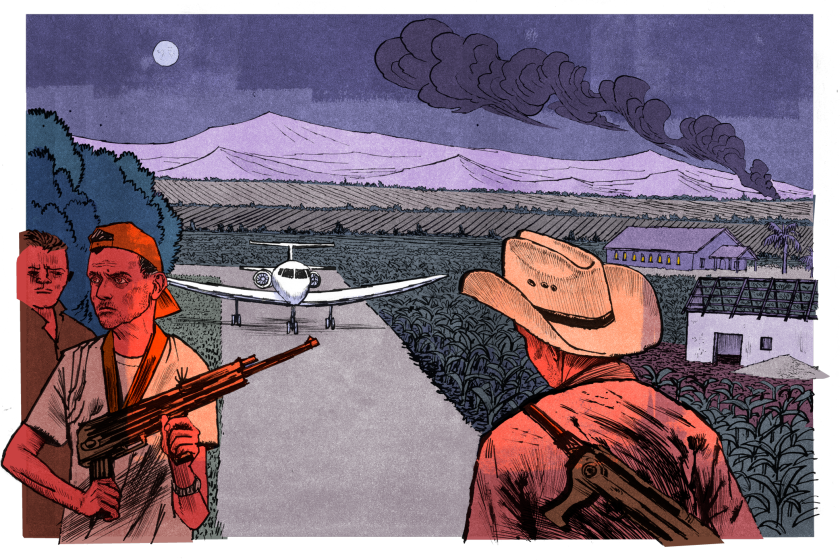
How a Mennonite farmer became a drug suspect
Mennonites are pious Christians who eschew much of the modern world. But in Mexico even they have not escaped the pull of the drug cartels.
Feb. 1, 2024
Milei won 56% of the vote in Rosario, where residents praise his focus on a problem largely neglected by his predecessors. But some worry the government’s combative approach traps them in the line of fire.
Gangs started their deadly retaliations just hours after Pullaro’s security minister shared photos showing Argentine prisoners crammed together on the floor, heads pressed against each other’s bare backs — a scene reminiscent of El Salvador President Nayib Bukele’s harsh anti-gang crackdown.
“It’s a war between the state and the drug traffickers,” said Ezequiel, a 30-year-old employee at the gas station where Bussanich was killed. Ezequiel, who gave only his first name for fear of reprisals, said his mother has since begged him to quit. “We’re the ones paying the price.”
Even Milei’s supporters have mixed feelings about the crackdown, including Germán Bussanich, the father of the slain gas station worker.
“They’re putting on a show and we’re facing the consequences,” Bussanich told reporters.
A leafy city 180 miles northwest of Buenos Aires, Rosario is where revolutionary Ernesto “Che” Guevara was born, Messi first kicked a soccer ball and the Argentine flag was first raised in 1812. But it most recently won notoriety because its homicide numbers are five times the national average.
Tucked into a bend in the Paraná River, Rosario’s port morphed into Argentina’s drug trafficking hub as regional crackdowns pushed the narcotics trade south and criminals started squirreling away cocaine in shipping containers spirited down the river to markets abroad. Although Rosario never suffered the car bombs and police assassinations gripping Mexico, Colombia and most recently Ecuador, the splintering of street gangs has fueled bloodshed.

Argentina’s president announces economy deregulation as thousands protest austerity
Argentine President Javier Milei announces sweeping economic plans, including easing government regulation and allowing privatization of state-run industries.
Dec. 21, 2023
“It’s not close to the violence in Mexico because we still have the deterrence capacity of the government in Argentina,” said Marcelo Bergman, a social scientist at the National University of Tres de Febrero in Argentina. “But we need to keep an eye on Rosario because the major threats come not so much from big cartels but when these groups proliferate and diversify.”
Drug traffickers keep a tight grip over Rosario’s poor neighborhoods full of young men vulnerable to recruitment. One of them was Víctor Emanuel, a 17-year-old killed two years ago by rival gangsters in an area where street murals pay tribute to slain criminal leaders. No one was arrested.
“My neighbors know who’s responsible,” his mother, Gerónima Benítez, told the AP, her eyes shiny with tears. “I looked for help everywhere, I knocked on the doors of the judiciary, the government. No one answered.”
A fearful existence is all Benítez has ever known. But now, for the first time in Argentina, warring drug traffickers are banding together and terrorizing parts of the city previously considered safe.
Imprisoned gang leaders in Latin America have long run criminal enterprises remotely with the help of corrupt guards. But according to an indictment unveiled last week, incarcerated gang bosses in Argentina have been passing instructions on how to kill random civilians via family visits and video calls.
Court documents say the bosses paid underage hit men up to $450 to target four of the recent victims in Argentina’s third-largest city. The killing of Bussanich, two taxi drivers and a bus driver in less than a week in March, federal prosecutors say, “shattered the peace of an entire society.”

Who is Javier Milei, Argentina’s Trump-loving, culture-warring libertarian president-elect?
Argentina’s next president, Javier Milei, is a culture-warring Trump fan who opposes abortion, calls the pope an “imbecile” and says sex education is a Marxist plot.
Nov. 20, 2023
Streets emptied. Schools closed. Bus drivers picketed. People were too terrified to leave their homes.
“This violence is on another level,” 20-year-old Rodrigo Dominguez said from an intersection where a dangling banner demanded justice for another bus driver slain there weeks earlier. “You can’t go outside.”
Panic was still palpable in Rosario last week as police swarmed the streets and normally bustling bars closed early for lack of customers. A diner managed by Messi’s family, a draw for fans, reported quiet nights and less profit. Women in one neighborhood said they carry .22‐caliber pistols. Analía Manso, 37, said she was too scared to send her children to school.
Pope Francis last month said he was praying for his countrymen in Rosario.
Assaults and public threats continue. This month, a sign appeared on a highway overpass warning Argentine Security Minister Patricia Bullrich that gangs would extend their offensive to Buenos Aires if the government doesn’t back down.
Authorities have sought to reassure the public by sending hundreds of federal agents into Rosario. The AP spent a night with police last week as officers patrolled neighborhoods logging suspicious activity and setting up checkpoints.
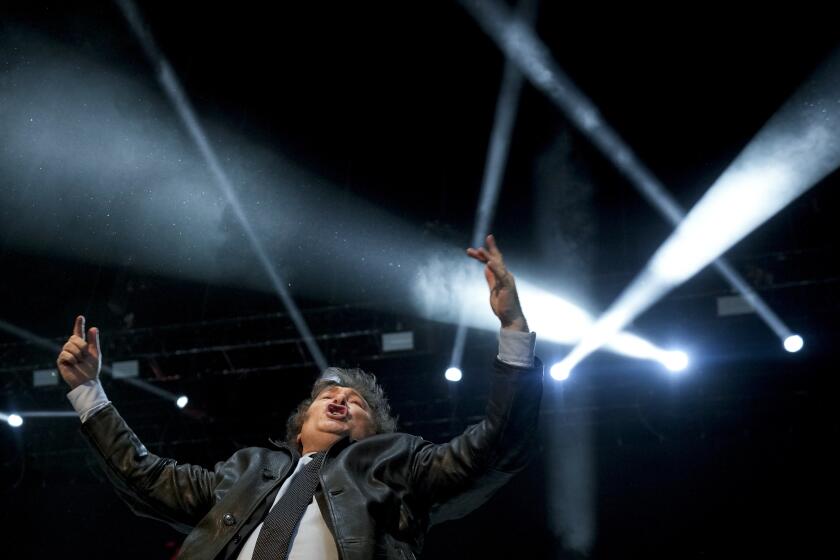
Desperate and disaffected, Argentine voters consider casting their lot with a right-wing upstart
Millions of disaffected voters are planning to cast their ballots Sunday for right-wing populist and self-described anarcho-capitalist Javier Milei.
Oct. 19, 2023
Georgina Wilke, a 45-year-old officer in the Rosario bomb squad, said she welcomes federal intervention, including the military, to get crime under control. “We’ve been hit very hard,” Wilke said.
Omar Pereira, the provincial secretary of public security, said the efforts represent a shift from failed tactics of the past.
“There were always pacts, implicit or explicit, between the state and criminals,” Pereira said, describing how authorities long looked the other way. “What’s the idea of this government? There is no pact.”
But experts are skeptical a tough-on-crime approach will stop drug traffickers from buying control over Argentina’s police and prisons.
“Unless the government fixes its problems with corruption, the crackdown on prisons is unlikely to have any long-term effect,” said Christopher Newton, an investigator at Colombia-based research organization InSight Crime.
For years, Rosario’s 1.3 million residents have watched warily as presidents and their promises come and go while the violence endures.
“It’s like a cancer that grows and grows,” said Benítez from her home, its windows protected by wrought-iron bars.
“We, on the outside, live in prison,” she said. “Those inside have everything.”
Debre and Calatrava write for the Associated Press.
More to Read
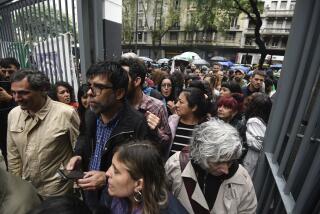
Argentina’s Milei takes chainsaw to the state, cuts 15,000 jobs, prompting protests
April 3, 2024

One of Ecuador’s most notorious gang leaders went missing from prison. What we know
Jan. 11, 2024
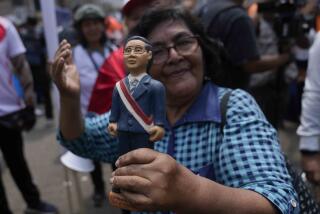
Opinion: Organized crime threatens Latin America’s democracies and fuels migration. The U.S. can help
Jan. 2, 2024
Start your day right
Sign up for Essential California for news, features and recommendations from the L.A. Times and beyond in your inbox six days a week.
You may occasionally receive promotional content from the Los Angeles Times.
More From the Los Angeles Times
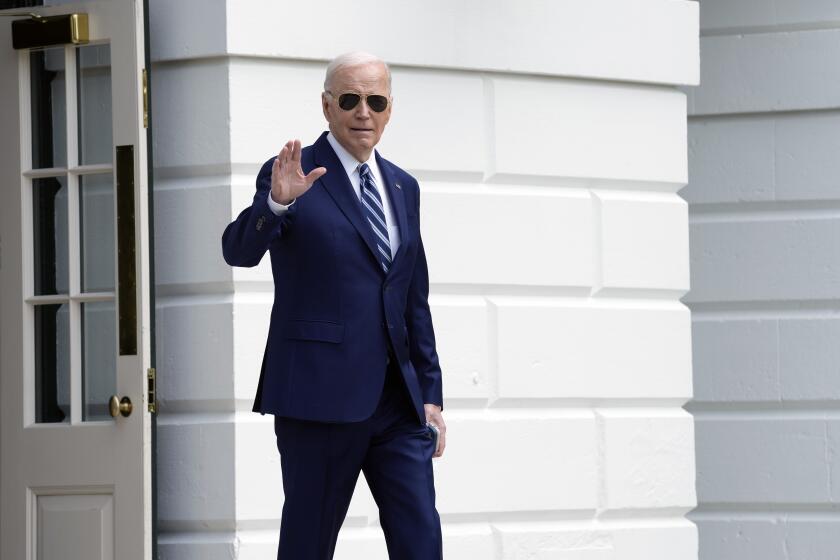
Biden, Mexican President Andrés Manuel López Obrador discuss migration in latest call
April 29, 2024

Panama’s leading presidential candidate is a late entry promising a return to better times

House Republicans send Mayorkas impeachment articles to the Senate, forcing trial
April 16, 2024

Venezuela closes its embassy in Ecuador to protest raid on Mexico’s embassy there
- Election 2024
- Entertainment
- Newsletters
- Photography
- Personal Finance
- AP Investigations
- AP Buyline Personal Finance
- AP Buyline Shopping
- Press Releases
- Israel-Hamas War
- Russia-Ukraine War
- Global elections
- Asia Pacific
- Latin America
- Middle East
- Election Results
- Delegate Tracker
- AP & Elections
- Auto Racing
- 2024 Paris Olympic Games
- Movie reviews
- Book reviews
- Personal finance
- Financial Markets
- Business Highlights
- Financial wellness
- Artificial Intelligence
- Social Media
Unprecedented wave of narco-violence stuns Argentina city
A prison guard sits in a watchtower at the Pinero jail in Pinero, Argentina, Tuesday, April 9, 2024. President Javier Milei has called for harsher penalties against drug traffickers and military intervention. (AP Photo/Natacha Pisarenko)
A chain lock reinforces the locked door of a gas station that started closing shop at night after the killing of a worker at a nearby station a few weeks before, in Rosario, Argentina, Monday, April 8, 2024. The order to kill came from inside Ezeiza Prison from gang leaders who hired a 15-year-old hitman to kill gas station worker Bruno Bussanich on March 9. (AP Photo/Natacha Pisarenko)
A mural of soccer player Lionel Messi covers a building in Rosario, Argentina, Monday, April 8, 2024. The birthplace of Messi and revolutionary Ernesto “Che” Guevara morphed about a decade ago into the country’s drug trafficking hub, as regional crackdowns pushed the trade south. (AP Photo/Natacha Pisarenko)
A child rides a bicycle past a mural of Gabriel Ignacio Romero, a resident who was murdered on the sidewalk outside his home the previous year, in Rosario, Argentina, Monday, April 8, 2024. For the past decade, the 1.3 million residents of Rosario have watched warily as presidents and their promises come and go. What endures, they say, is violence. (AP Photo/Natacha Pisarenko)
Police officer Georgina Wilke drives her patrol car in Rosario, Argentina, late Monday, April 8, 2024. Agents fanned out across hardscrabble areas, spending hours logging neighborhood activity and setting up checkpoints on major thoroughfares. (AP Photo/Natacha Pisarenko)
People hang out at a park in Rosario, Argentina, Monday, April 8, 2024. The birthplace of Lionel Messi and revolutionary Ernesto “Che” Guevara morphed about a decade ago into the country’s drug trafficking hub, as regional crackdowns pushed the trade south. (AP Photo/Natacha Pisarenko)
A resident who did not want to be identified shows the gun she keeps at her home for self-defense as she poses for a photo in Rosario, Argentina, Monday, April 8, 2024. The homicide rate is five times the national average in Rosario. (AP Photo/Natacha Pisarenko)
A mural of Claudio Ariel Cantero covers a wall alongside a supportive message of him written by his family, in Rosario, Argentina, Tuesday, April 9, 2024. Cantero, known as “El Pajaro,” or The Bird, was the leader of the criminal organization called “Los Monos,” or The Monkeys, and was shot to death at a bowling alley on May 26, 2013 in Santa Fe. (AP Photo/Natacha Pisarenko)
Police patrol the streets of Rosario, Argentina, as a family that collects disposed cardboard to resell pushes their children in a shopping cart, late Monday, April 8, 2024. Agents fanned out across hardscrabble areas, spending hours logging neighborhood activity and setting up checkpoints on major thoroughfares. (AP Photo/Natacha Pisarenko)
Geronima Benitez holds a photograph of her son Victor Emanuel, 17, who was murdered by drug traffickers who were never arrested two years ago, at her home in Rosario, Argentina, Tuesday, April 9, 2024. Benítez said her son’s killer still lives down her street and is not convinced a prison sentence would make a difference. “We, on the outside, live in prison,” she said. “Those inside have everything.” (AP Photo/Natacha Pisarenko)
Geronima Benitez wipes her eyes as she speaks about her son Victor Emanuel, 17, who was murdered by drug traffickers who were never arrested two years ago, during an interview at her home in Rosario, Argentina, Tuesday, April 9, 2024. Benítez said her son’s killer still lives down her street and is not convinced a prison sentence would make a difference. “We, on the outside, live in prison,” she said. “Those inside have everything.” (AP Photo/Natacha Pisarenko)
A banner hangs over a bus stop asking for justice regarding the murder of bus driver Cesar Roldan in Rosario, Argentina, Tuesday, April 9, 2024. (AP Photo/Natacha Pisarenko)
Prison guards stand behind the entrance to Pinero jail in Pinero, Argentina, Tuesday, April 9, 2024. Authorities have ramped up prison raids, seized thousands of smuggled cellphones and restricted visits. (AP Photo/Natacha Pisarenko)
A police officer stands guard on a street in Rosario, Argentina, Monday, April 8, 2024. President Javier Milei has promised to prosecute gang members as terrorists and change the law to allow the army into crime-ridden streets for the first time since Argentina’s brutal military dictatorship ended in 1983. (AP Photo/Natacha Pisarenko)
The Pinero jail complex stands in Pinero, Argentina, Tuesday, April 9, 2024. President Javier Milei’s tough-on-crime message has empowered hardline governor Maximiliano Pullaro’s efforts to clamp down on incarcerated criminal groups, which he said planned 80% of shootings in Rosario last year. (AP Photo/Natacha Pisarenko)
Inmates play soccer at Pinero jail in Pinero, Argentina, Tuesday, April 9, 2024. Authorities have ramped up prison raids, seized thousands of smuggled cellphones and restricted visits. (AP Photo/Natacha Pisarenko)
An inmate looks out from a window at Pinero jail in Pinero, Argentina, Tuesday, April 9, 2024. Authorities have ramped up prison raids, seized thousands of smuggled cellphones and restricted visits. (AP Photo/Natacha Pisarenko)
Prison guards stand inside the Pinero jail complex in Pinero, Argentina, Tuesday, April 9, 2024. President Javier Milei has called for harsher penalties against drug traffickers and military intervention. (AP Photo/Natacha Pisarenko)
- Copy Link copied
ROSARIO, Argentina (AP) — The order to kill came from inside a federal prison near Argentina’s capital. Unwitting authorities patched a call from drug traffickers tied to one of the country’s most notorious gangs to collaborators on the outside. Hiring a 15-year-old hit man, they sealed the fate of a young father they didn’t even know.
At a service station on March 9 in Rosario, the picturesque hometown of soccer star Lionel Messi, 25-year-old employee Bruno Bussanich was whistling to himself and checking the day’s earnings just before he was shot three times from less than a foot away, surveillance footage shows. The assailant fled without taking a peso.
It was the fourth gang-related fatal shooting in Rosario in almost as many days. Authorities called it an unprecedented rampage in Argentina, which had never witnessed the extremes of drug cartel violence afflicting some other Latin American countries.
A handwritten letter was found near Bussanich’s body, addressed to officials who want to curb the power drug kingpins wield from behind bars. “We don’t want to negotiate anything. We want our rights,” it says. “We will kill more innocent people.”
Shaken residents interviewed by The Associated Press across Rosario described a sense of dread taking hold.
“Every time I go to work, I say goodbye to my father as if it were the last time,” said 21-year-old Celeste Núñez, who also works at a gas station.
The string of killings offer an early test to the security agenda of populist President Javier Milei, who has tethered his political success to saving Argentina’s tanking economy and eradicating narco-trafficking violence.
A police officer stands guard on a street in Rosario, Argentina, Monday, April 8, 2024. (AP Photo/Natacha Pisarenko)
Since taking office Dec. 10, the right-wing leader has promised to prosecute gang members as terrorists and change the law to allow the army into crime-ridden streets for the first time since Argentina’s brutal military dictatorship ended in 1983.
His law-and-order message has empowered the hardline governor of Santa Fe province, which includes Rosario, to clamp down on incarcerated criminal gangs that authorities say orchestrated 80% of shootings last year. Under the orders of Governor Maximiliano Pullaro, police have ramped up prison raids, seized thousands of smuggled cellphones and restricted visits.
“We are facing a group of narco-terrorists desperate to maintain power and impunity,” Milei said after Bussanich was killed, announcing the deployment of federal forces in Rosario. “We will lock them up, isolate them, take back the streets.”
A mural of Claudio Ariel Cantero covers a wall alongside a supportive message of him written by his family, in Rosario, Argentina, Tuesday, April 9, 2024. (AP Photo/Natacha Pisarenko)
Milei won 56% of the vote in Rosario, where residents praise his focus on a problem largely neglected by his predecessors. But some worry the government’s combative approach traps them in the line of fire.
Gangs started their deadly retaliations just hours after Pullaro’s security minister shared photos showing Argentine prisoners crammed together on the floor, heads pressed against each other’s bare backs — a scene reminiscent of El Salvador President Nayib Bukele’s harsh anti-gang crackdown.
“It’s a war between the state and the drug traffickers,” said Ezequiel, a 30-year-old employee at the gas station where Bussanich was killed. Ezequiel, who gave only his first name for fear of reprisals, said his mother has since begged him to quit. “We’re the ones paying the price.”
Even Milei’s supporters have mixed feelings about the crackdown, including Germán Bussanich, the father of the slain gas station worker.
“They’re putting on a show and we’re facing the consequences,” Bussanich told reporters.
A leafy city 300 kilometers (180 miles) northwest of Buenos Aires, Rosario is where revolutionary Ernesto “Che” Guevara was born, Messi first kicked a soccer ball and the Argentine flag was first raised in 1812. But it most recently won notoriety because its homicide numbers are five times the national average.
Tucked into a bend in the Paraná River, Rosario’s port morphed into Argentina’s drug trafficking hub as regional crackdowns pushed the narcotics trade south and criminals started squirreling away cocaine in shipping containers spirited down the river to markets abroad. Although Rosario never suffered the car bombs and police assassinations gripping Mexico , Colombia and most recently Ecuador , the splintering of street gangs has fueled bloodshed.
“It’s not close to the violence in Mexico because we still have the deterrence capacity of the government in Argentina,” said Marcelo Bergman, a social scientist at the National University of Tres de Febrero in Argentina. “But we need to keep an eye on Rosario because the major threats come not so much from big cartels but when these groups proliferate and diversify.”
Drug traffickers keep a tight grip over Rosario’s poor neighborhoods full of young men vulnerable to recruitment. One of them was Víctor Emanuel, a 17-year-old killed two years ago by rival gangsters in an area where street murals pay tribute to slain criminal leaders. No one was arrested.
“My neighbors know who’s responsible,” his mother, Gerónima Benítez, told the AP, her eyes shiny with tears. “I looked for help everywhere, I knocked on the doors of the judiciary, the government. No one answered.”
A fearful existence is all Benítez has ever known. But now, for the first time in Argentina, warring drug traffickers are banding together and terrorizing parts of the city previously considered safe.
Imprisoned gang leaders in Latin America have long run criminal enterprises remotely with the help of corrupt guards. But according to an indictment unveiled last week , incarcerated gang bosses in Argentina have been passing instructions on how to kill random civilians via family visits and video calls.
Court documents say the bosses paid underage hit men up to $450 to target four of the recent victims in Argentina’s third-largest city. The killing of Bussanich, two taxi drivers and a bus driver in less than a week in March, federal prosecutors say, “shattered the peace of an entire society.”
Street emptied. Schools closed. Bus drivers picketed. People were too terrified to leave their homes.
“This violence is on another level,” 20-year-old Rodrigo Dominguez said from an intersection where a dangling banner demanded justice for another bus driver slain there weeks earlier. “You can’t go outside.”
Panic was still palpable in Rosario last week, as police swarmed the streets and normally bustling bars closed early for lack of customers. A diner managed by Messi’s family, a draw for fans, reported quiet nights and less profit. Women in one neighborhood said they carry 22‐caliber pistols. Analía Manso, 37, said she was too scared to send her children to school.
Pope Francis last month said he was praying for his countrymen in Rosario.
Assaults and public threats continue. This month, a sign appeared on a highway overpass warning Argentine Security Minister Patricia Bullrich that gangs would extend their offensive to Buenos Aires if the government doesn’t back down.
Authorities have sought to reassure the public by sending hundreds of federal agents into Rosario. The AP spent a night with police last week as officers patrolled neighborhoods logging suspicious activity and setting up checkpoints.
Georgina Wilke, a 45-year-old Rosario officer in the explosives squad, said she welcomes federal intervention, including the military, to get crime under control. “We’ve been hit very hard,” Wilke said.
Omar Pereira, the provincial secretary of public security, promised the efforts represent a shift from failed tactics of the past.
“There were always pacts, implicit or explicit, between the state and criminals,” Pereira said, describing how authorities long looked the other way. “What’s the idea of this government? There is no pact.”
A child rides a bicycle past a mural of Gabriel Ignacio Romero, a resident who was murdered on the sidewalk outside his home the previous year, in Rosario, Argentina, Monday, April 8, 2024. (AP Photo/Natacha Pisarenko)
But experts are skeptical a tough-on-crime approach will stop drug traffickers from buying control over Argentina’s police and prisons.
“Unless the government fixes its problems with corruption, the crackdown on prisons is unlikely to have any long-term effect,” said Christopher Newton, an investigator at Colombia-based research organization InSight Crime.
For years, Rosario’s 1.3 million residents have watched warily as presidents and their promises come and go while the violence endures.
“It’s like a cancer that grows and grows,” said Benítez from her home, its windows protected by wrought-iron bars.
“We, on the outside, live in prison,” she said. “Those inside have everything.”

IMAGES
VIDEO
COMMENTS
Visit the Basílica Catedral de Nuestra Señora del Rosario (Rosario's Cathedral) The National Flag Monument's west end leads into a small cathedral devoted to 'Our Lady of the Rosary.'. This church has very humble beginnings: first built in 1730, it was then rebuilt throughout the 19th century.
San Lorenzo 1530. Rosario, Santa Fe. Tel: +54 (0341) 530-2020. Casa Be Suites. Avenida Pellegrini 3675. Rosario, Santa Fe. Rosario, Sante Fe is not a big-name tourist destination in Argentina, despite being the country's 3rd largest city, but it's worth a short visit.
3. Eat Ice Cream. Source: Shutterstock. Helado. Quite unexpectedly, Argentina's ice cream is some of the best in the world. And Rosario is actually the national capital of artisanal ice cream. The helado here is more like Italian gelato than the ice cream in the States, and dulce de leche is a popular flavor.
Rosario is the kind of city we absolutely love. It's not a showcase city like Buenos Aires or the seat of government. But as the birthplace of the national flag and Che Guevara, Rosario sure ain't quaint, either.. Unlike his image plastered across T-shirts and magnets throughout the rest of the world, we couldn't believe how absent Che Guevara's image is in Argentina.
Getting around Rosario by taxi. Taxis are easy to hail on the street; the meter starts at $53, adding $2.65 every 100m (Mon-Sat 10pm-6am, and all day Sun/hols, the rate jumps to $60.56 plus $3 every 100m). Most trips across the centre should be no more than $150-200. Getting around Rosario by bike.
Here in Rosario the Río Paraná dominates the urban landscape, its tea-brown waters setting the scene for riverside dining, drinking, strolling, and chilling out on peaceful river islands. While Buenos Aires bursts with capital city pride, Rosario paddles its feet in the water. Dynamic and confident without being showy, culturally rich and the ...
Rosario. Argentina, South America. Birthplace of the Argentine flag as well as two of the nation's most famous exports, Che Guevara and Lionel Messi, Rosario is still an important river port but has done a great job of regenerating its center. The derelict buildings of the long costanera have been converted into galleries, restaurants and skate ...
Top 14 best things to do in Rosario, Argentina. Photo by Rodox. 1. Visit the Parque de la Independencia, a beautiful park located in the heart of the city, featuring a lake, a rose garden, and a variety of recreational activities. 2. Check out the Museo de la Ciudad, a fascinating museum that tells the story of Rosario's rich history and culture.
Renting a bike is also a great way to get around the city quickly and see all the sights, especially when with a guide who can provide some local insight. Zeballos 327, Rosario, Santa Fe, Argentina. The Paraná river and Victoria bridge, Rosario Ⓒ Maximiliano Kolus/Flickr. 3. Museo Histórico Provincial.
Located in Central Argentina, it is the third largest city in the country. It is known for its neoclassical architecture, and for being the country's most liberal and socialist city. It is also the birthplace of renowned artist Guillermo Forchino. There is an abundance of bars and hostels in the city. POPULATION: 1,200,000.
Travel Tips for visiting Rosario. It might sound obvious and redundant, but our first travel tip for Rosario is - include Rosario in your travel itinerary for Argentina. It generally gets overshadowed by big brother Buenos Aires and the likes of Iguazu waterfalls and Patagonia. There are things to do in Rosario in the summer as well as winter.
Together with Claudio, a real Rosariño, I show you things to do in Rosario (Santa Fe, Argentina). Claudio, who was also my spanish teacher tells a bit about ...
Post Tags: # argentina # personal travel blog # rosario argentina # south america. Trisha Velarmino. Entrepreneur. Trisha is one of those people who left their comfortable life to travel the world and learn about life. Her style is to stay in one place she likes for 3 months (or more) to know what it feels like to eat, cook, speak, and sleep in ...
Rosario. Rosario is the third largest city in Argentina and the largest city in Santa Fe province, at the Paraná river. It is known for its rich architectural heritage and beautiful riverside scenery, and offers a vibrant cultural and night life. The city itself has about 1.1 million inhabitants, but considering the suburbs it rivals Córdoba in importance, with about 1.6 million living in ...
Tourism in Rosario: 10 excursions and things to do in Rosario, including adventure tourism, points of interest and tourist places to visit in the city and its surroundings. ... Travel agency and activities in Rosario. Team Travel Viajes Y Turismo. Cine Del Siglo. Pedraza Viajes y Turismo . ... Welcome Argentina - Touristic Information about ...
When I first got to Argentina, I didn't really have plans to go to Rosario. Not that I wasn't interested, but the guidebooks seem to skip over Rosario, and I didn't meet many other backpackers that were heading that way. However, in Patagonia, I met two different hostel workers that both insisted I go see Rosario (where they were originally from).
The third largest city in Argentina, Rosario is not that far from Buenos Aires and provides plenty of things to do for visitors. The port city offers a wonderful combination of natural and man-made attractions that provide families with plenty to see and do during their stay. What follows are some of the more interesting places to visit in Rosario.
Rosario Travel Blogs, Photos from TravelBlog.org. Background: Following independence from Spain in 1816, Argentina experienced periods of internal political conflict between conservatives and liberals and between civilian and military factions.After World War II, a long period of Peronist authoritarian rule and interference in subsequent governments was followed by a military junta that took ...
1.Iguazú Falls, 2.Rosário, 3.Córdoba, 4.Mendoza, 5.Buenos Aires. With 2 weeks in Argentina, you can cover the most culturally significant cities in Northern Argentina: Buenos Aires, Rosário, Córdoba, and Mendoza. This 14-day backpacking Argentina itinerary starts at the iconic Iguazú Falls and ends in Buenos Aires.
Culture Trip uses an independent third party trust account held by PT Trustees Limited in accordance with the Package Travel and Linked Travel Arrangements Regulations. CUSTOMER SERVICE US: +1 (678) 967 4965 | UK: +44 (0)1630 35000
Food Budget in Rosario Average Daily Costs. Calculated from travelers like you. While meal prices in Rosario can vary, the average cost of food in Rosario is $3.84 (AR$3,315) per day. Based on the spending habits of previous travelers, when dining out an average meal in Rosario should cost around $1.54 (AR$1,326) per person.
In short, Rosario is not a safe city for locals or visitors. In fact, Argentina's U.S. Embassy has designated this city a Level 2 (Exercise Increase Caution) warning. Rosario's growing crime rate has placed this city in the top 3 most dangerous cities in the country. With a population of 1.3 million residents, Rosario's homicide rate is ...
While SafetyWing is a top choice, companies like WorldNomads, Cigna Global, and IMG also offer comprehensive travel insurance for Rosario Argentina. Typical policies range from $45 - $500 for 2 weeks to a month of coverage. Compare coverage and premium costs.
ROSARIO, Argentina — The order to kill came from inside a federal prison near Argentina's capital. Unwitting authorities patched a call from drug traffickers tied to one of the country's ...
ROSARIO, Argentina (AP) — The order to kill came from inside a federal prison near Argentina's capital. Unwitting authorities patched a call from drug traffickers tied to one of the country's most notorious gangs to collaborators on the outside. Hiring a 15-year-old hit man, they sealed the fate of a young father they didn't even know.